Jonsbo N5 NAS Case Review
Ever since we first found out that Jonsbo were launching a new 12-bay storage desktop chassis for NAS use, we’ve been eagerly awaiting the chance to get our hands on the final product and find out whether it can really live up to the prototype unit we saw at Computex 2024 in the summer. Jonsbo already has an established range of NAS-focused enclosures with the N1, N2, N3, and N4—but none of these solutions seemingly ticked all the boxes for most users. The Jonsbo N5 is designed to be the most adaptable and scalable DIY NAS case in desktop that the brand has ever developed, and it’s easy to see why. Supporting up to 12 hard drives, four SSDs, practically any motherboard on the market, massive PCIe card support, and massive CPU cooler support—the N5 is an absolute behemoth. But is there such a thing as going too overkill when it comes to your own DIY server? Today? I want to review the N5 and help you decide whether this do-it-yourself server enclosure deserves your money and your data!
You can watch the full YouTube Review of the Jonsbo N5 NAS Case HERE on NASCompares
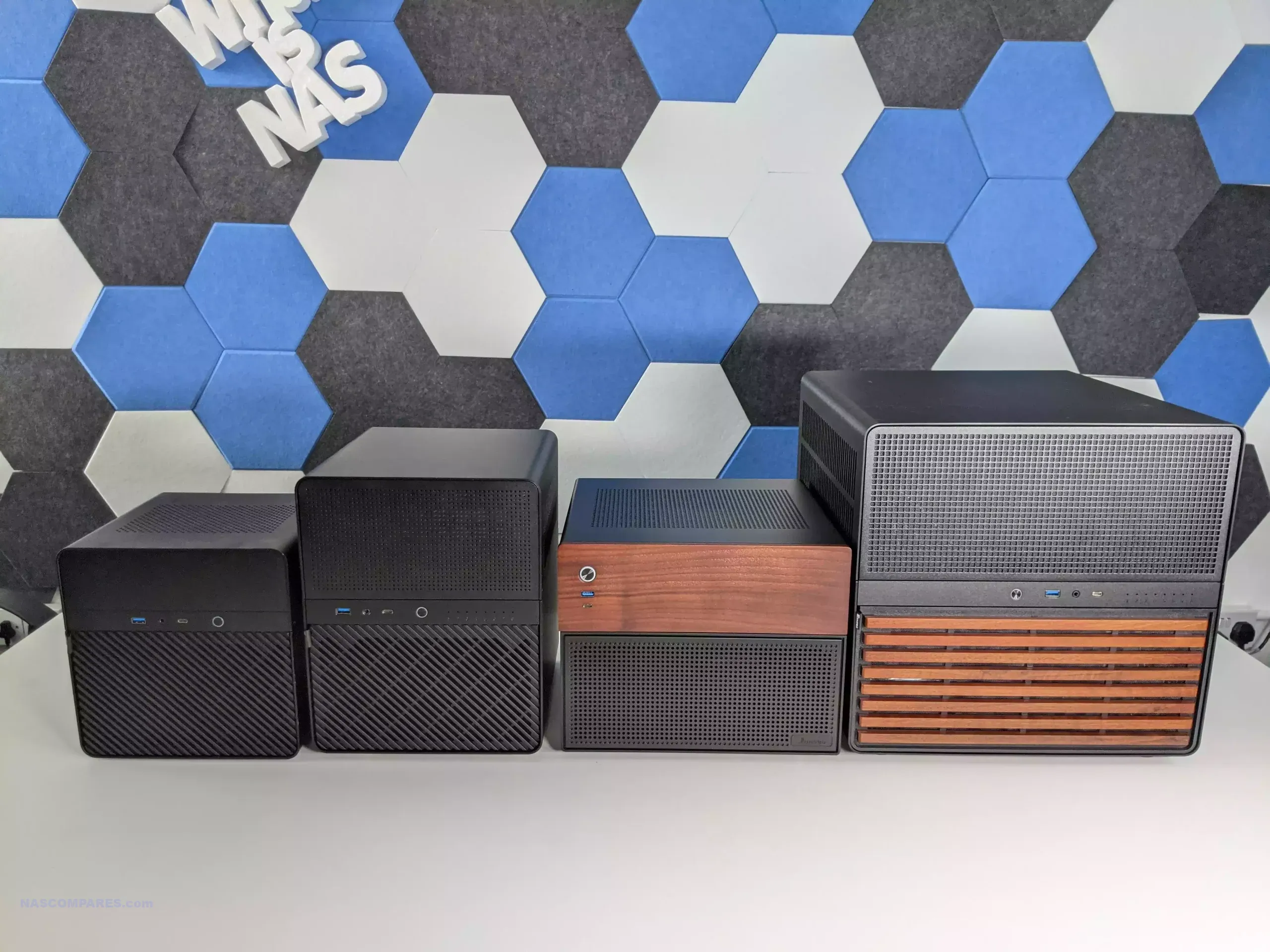
Note – You can see the comparison of the Jonsbo N2, N3, N4 and N5 in this article HERE
|
Where to Buy? #1 Jonsbo N5 (Aliexpress $195) – HERE #2 Jonsbo N5 (Aliexpress $300) – HERE #3 Jonsbo N5 (Aliexpress $192) – HERE Jonsbo N5 Coming to Amazon Soon – HERE |
Jonsbo N5 Review – Quick Conclusion
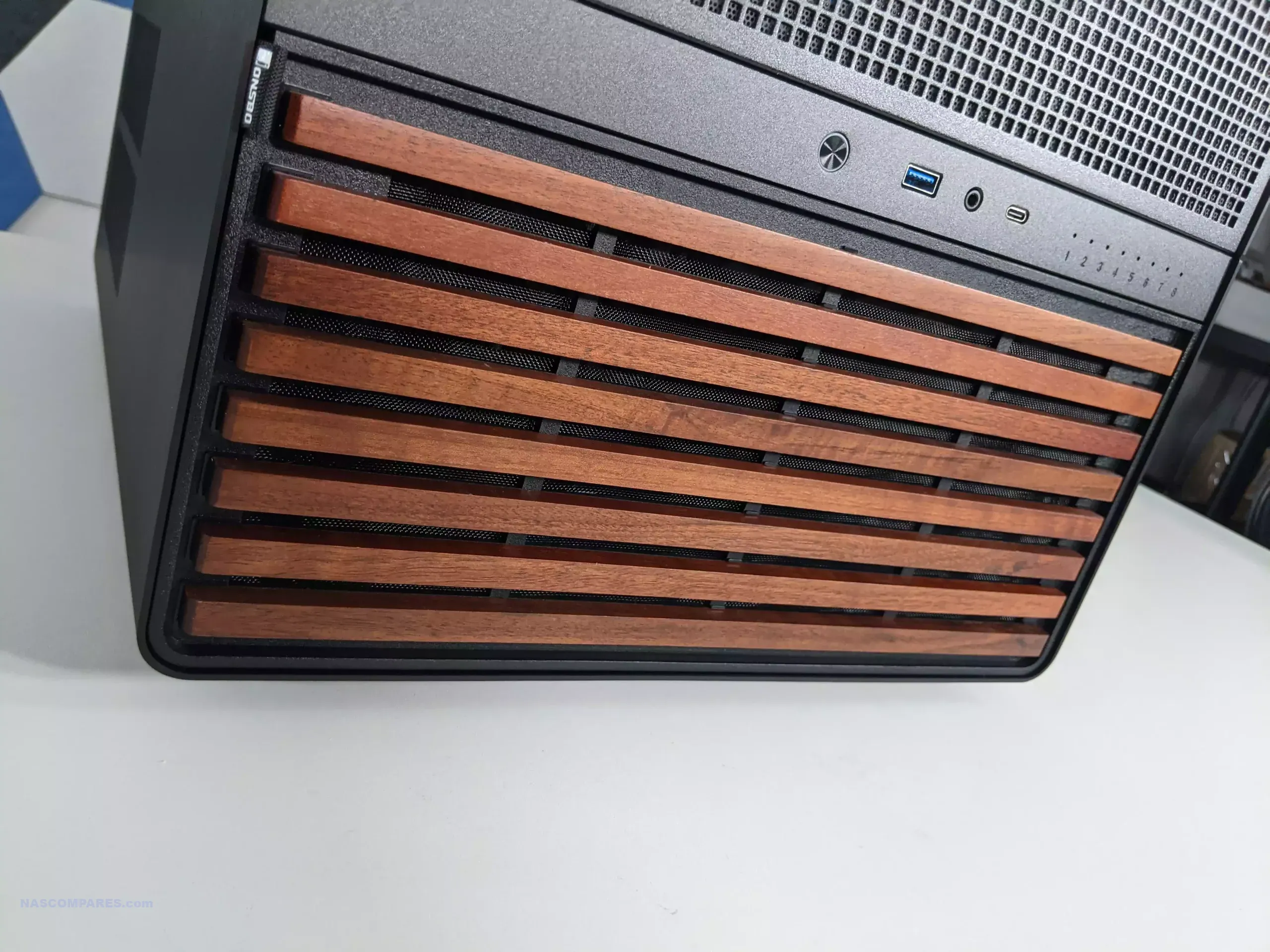
I’m really impressed with the Jonsbo N5! Having experimented with DIY NAS cases for years, I’m reluctant to label any one case as the “ultimate NAS case,” but the N5 comes remarkably close. While it may not be the smallest or the most discreet option, and those hard drive handles can be frustrating, in almost every other way, it’s the ideal NAS case for DIY server builds. If you’ve got the space, you won’t find a more scalable and upgradable NAS solution on the market in 2024. Though it’s not for the faint of heart, if you’re serious about setting up a long-term server solution that you can scale in any direction over time, the N5 will have you covered for years to come. Jonsbo has clearly put thought into refining this product based on past feedback, and while I expect someone to eventually create a hard drive tray mod to fix the handle issue, the case is otherwise unbeatable. Plus, considering the N5 is only about $80-100 more expensive than the N2, N3, and N4, yet far more versatile and scalable, it’s undoubtedly a fantastic choice!
Where to Buy a Product





![]()
![]()

VISIT RETAILER ➤






![]()
![]()

VISIT RETAILER ➤






![]()
![]()

VISIT RETAILER ➤






![]()
![]()

VISIT RETAILER ➤
 DEAL WATCH – Is It On Offer Right Now? DEAL WATCH – Is It On Offer Right Now?These Offers are Checked Daily
|
Jonsbo N5 Review – Packaging
Unsurprisingly, the packaging that the N5 arrives in is absolutely enormous. The enclosure itself is already pretty darn large; this case manages to be taller than most gamer PC cases but also wider too. The external casing, however, is not your typical brown faceless box and actually is adorned with system-specific details on all sides.
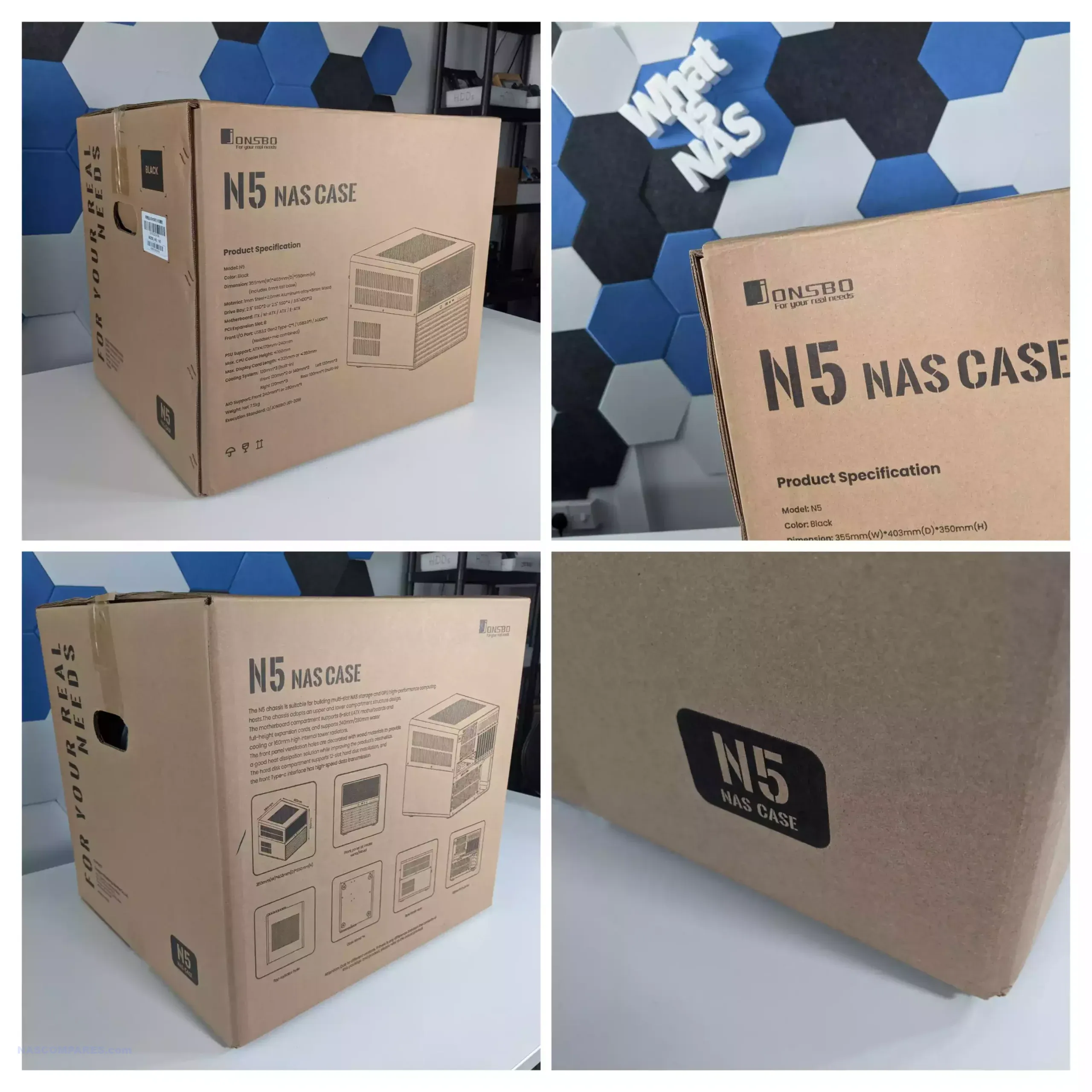
The contents of the system arrive via the main enclosure itself encased in thick foam on all sides to protect the device from damage by shock or motion in transit. The accessory kit that the system arrives with is in its own dedicated box, and although I question the sustainability and recyclability of some of these materials, there’s no arguing that the system is pretty well protected in transit.
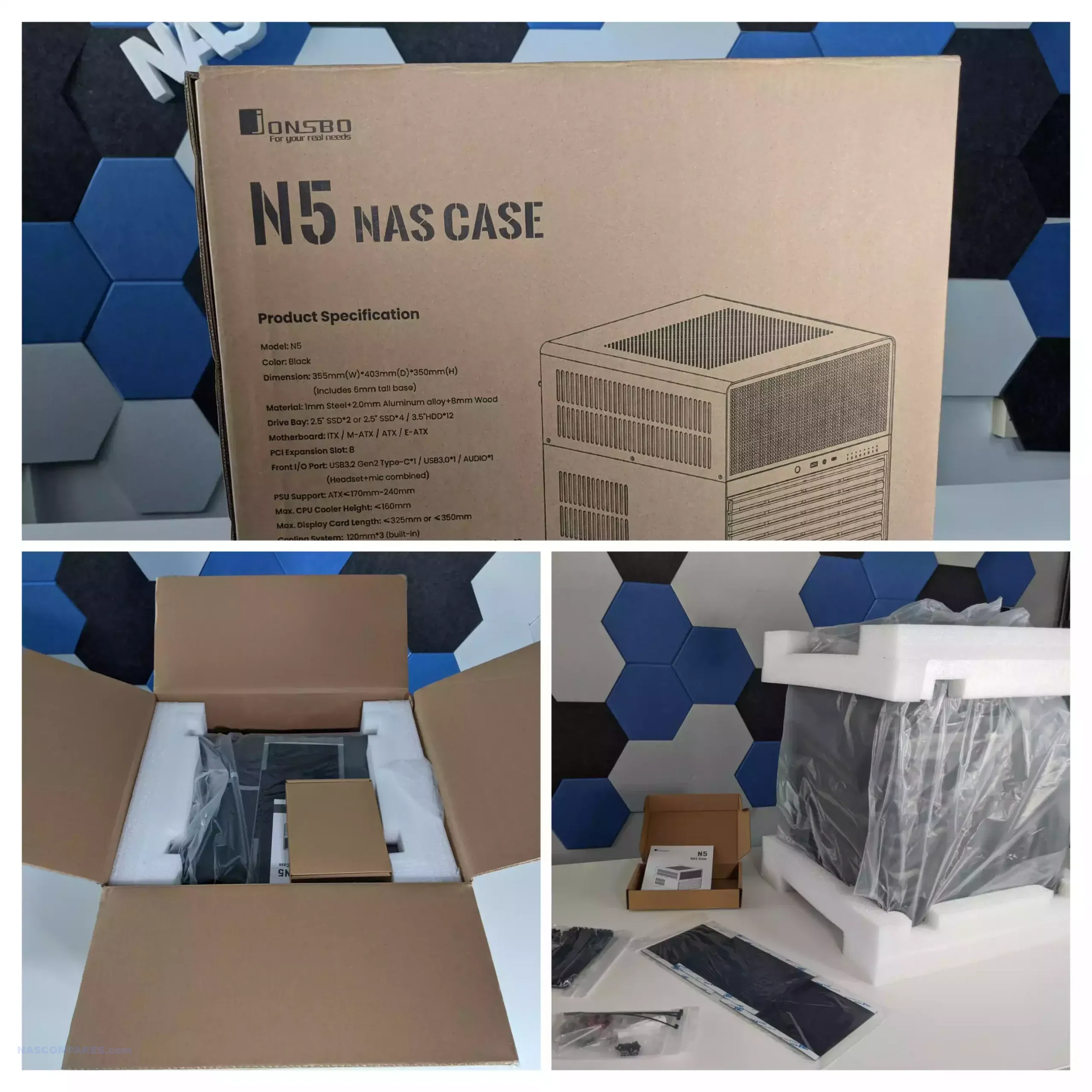
It’s also worth highlighting that, despite the fact that the N5 arrives as a case only, it arrives with a pretty extensive accessory kit included. Indeed, although you obviously have to get your own CPU+Mobo+RAM+storage+PSU+media, everything else you’re going to need is included when constructing the system. The kit includes extra tray accessories, extra screws, extra cable ties, and a couple of screwdrivers for dismantling and constructing the entire system enclosure.
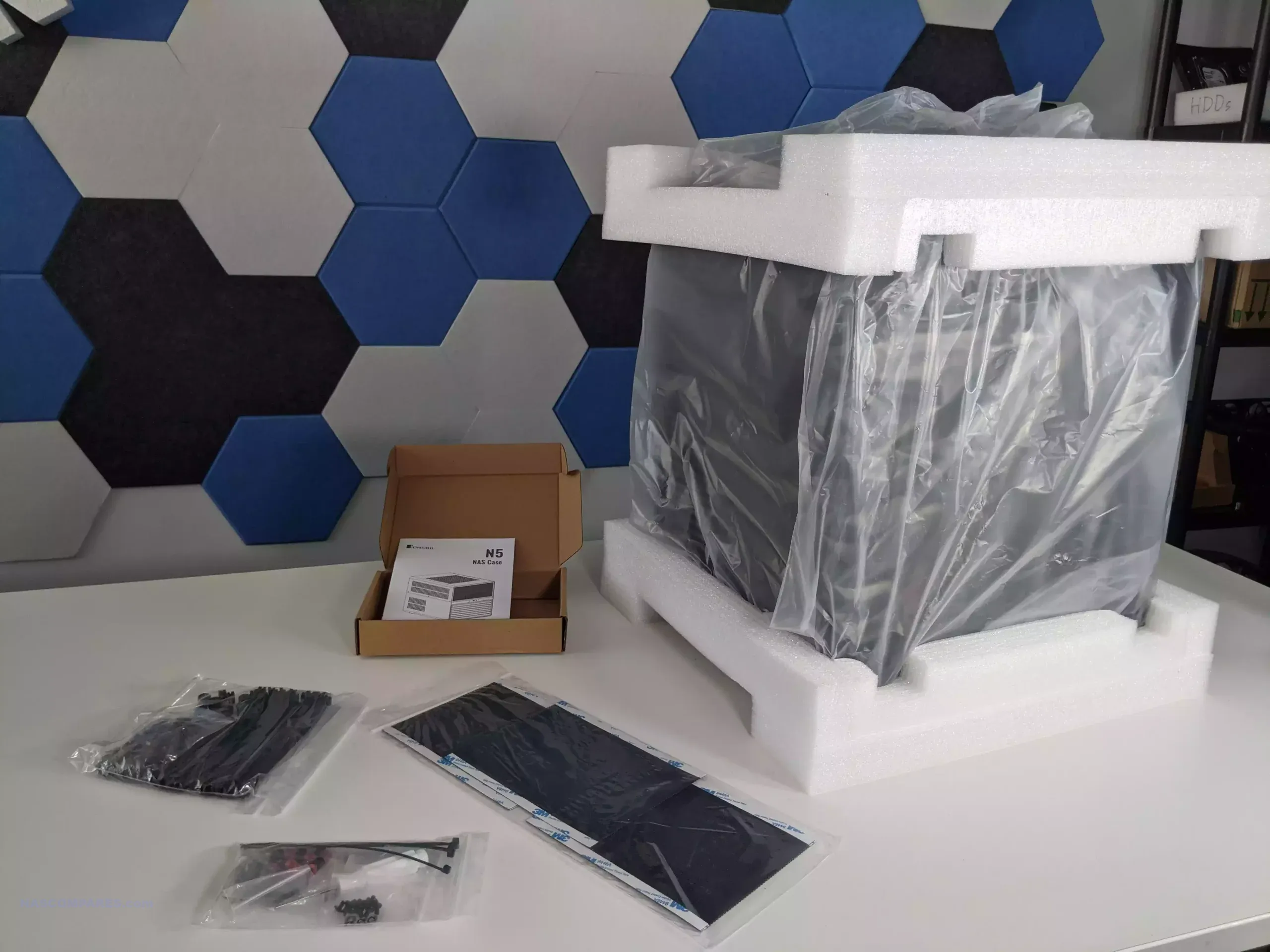
In terms of screws, the kit includes 2.5-inch screws for installing 2.5-inch media into the external framework, screws and grommets for the individual 3.5-inch drive media, screws and mounts for the motherboard and extra cooling systems, and additional washers for each screw kit.
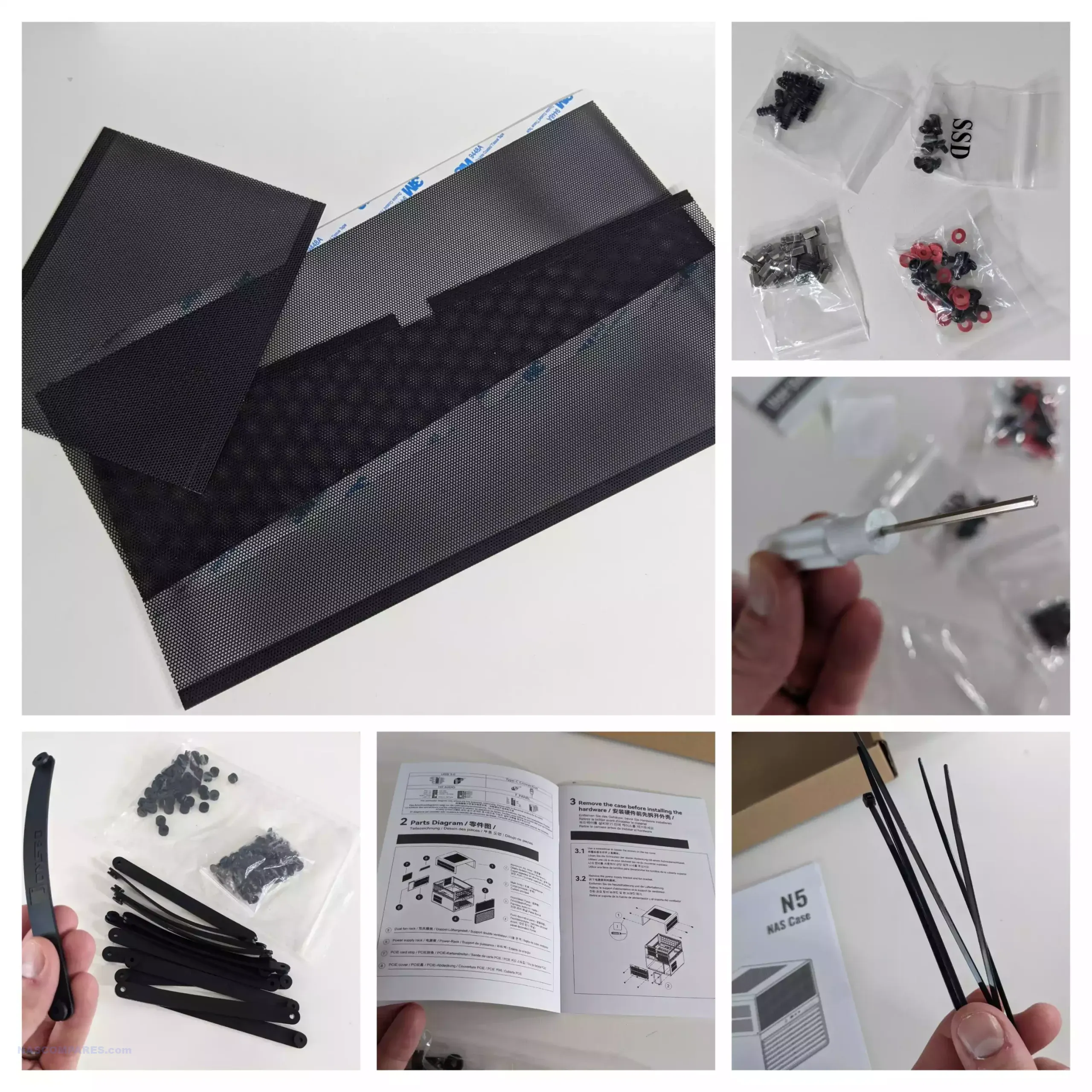
One complaint I’ve had when previously reviewing the Jonsbo NAS enclosure series that continues to annoy me here is that the brand still chooses to use hex/Allen key screws for the lid of the system. I understand why they choose to use these, as they can often be produced to be much more flush with the external enclosure and add to the sleek and discreet external casing that this chassis arrives with. However, these screws are pretty small, and even if you use the included hex/Allen key screwdriver that the kit arrives with, these are very easy to tear up, and once that happens, accessing the inside of your Jonsbo N5 NAS enclosure will become a right nightmare!
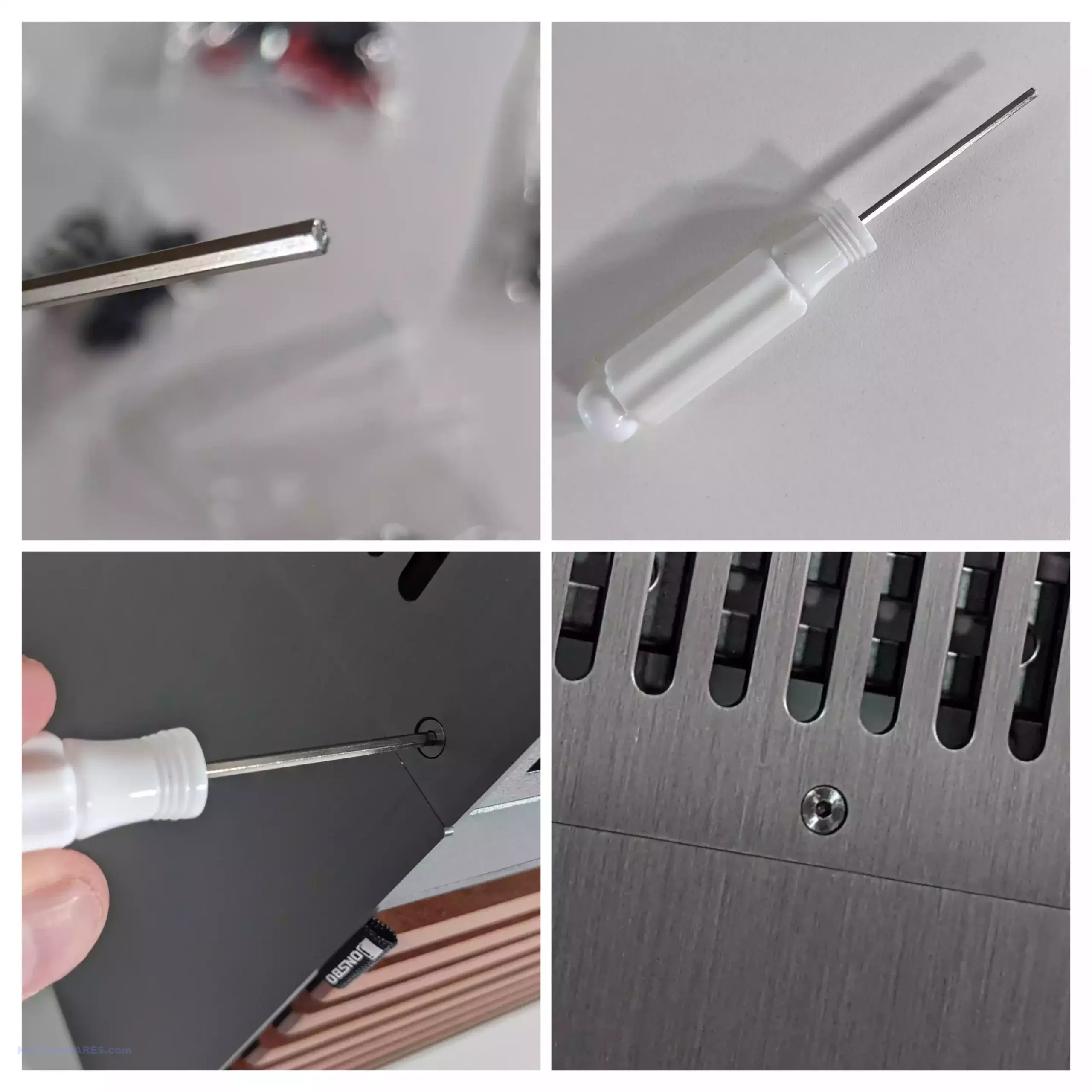
One enormous compliment I have to pay to the presentation of the Jonsbo N5, however, is the included instruction manual. I have reviewed and unboxed absolutely loads of NAS enclosures and complete NAS systems, and none of them I’ve ever had are more useful build instruction manuals than the N5! It details the correct order of building the system, outlines the appropriate outlets that you need to use for installing different components, as well as differentiating and recommending build methods for ITX or ATX deployments, right the way down to cable funneling. Previous Jonsbo NAS enclosures have always arrived with a folded A4 leaflet included, whereas this latest generation device arrives with a much more detailed instruction manual for first-time setup.
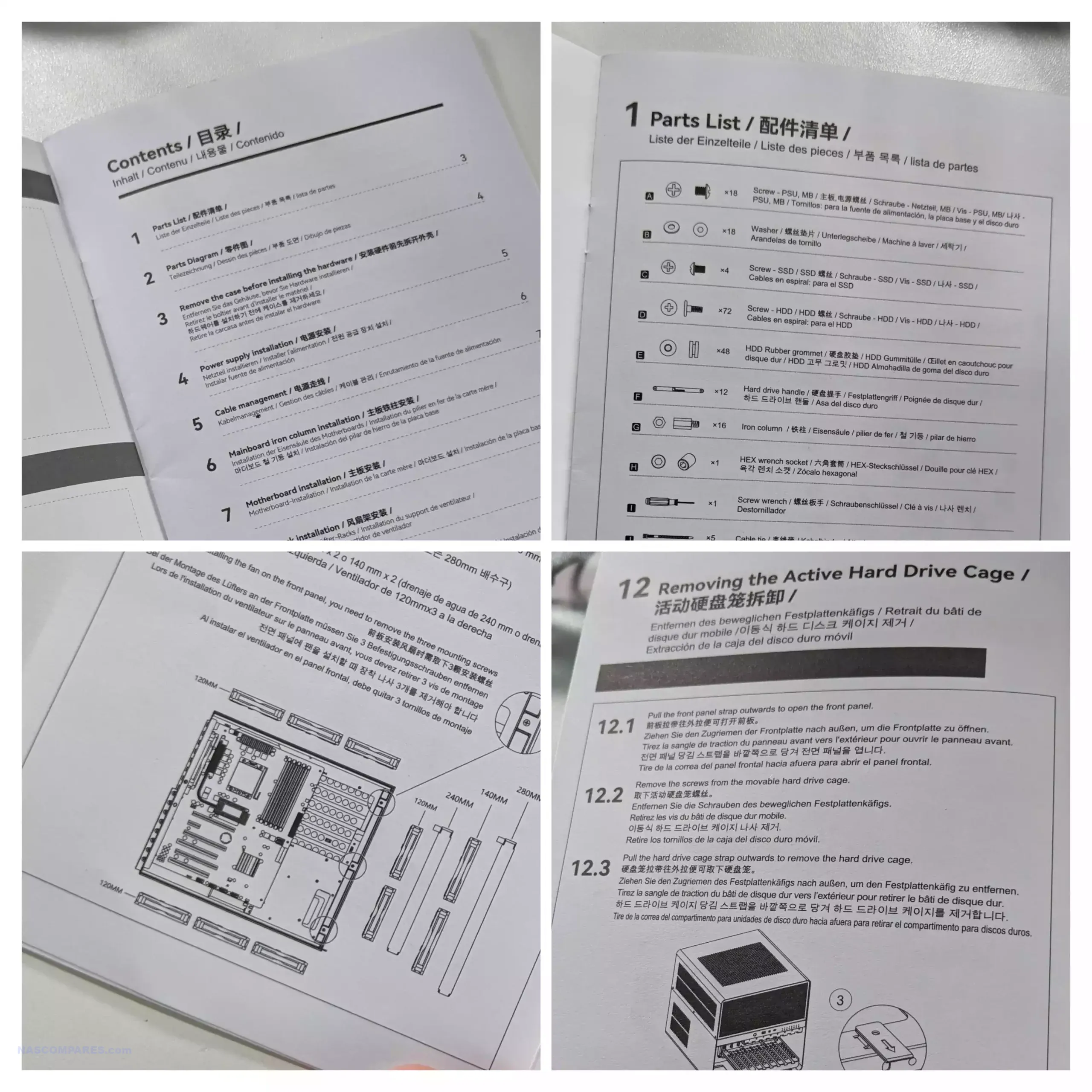
Overall, this is the most impressive DIY NAS presentation and accessory kit that the brand has ever released, arguably better than most other DIY NAS enclosures I’ve played around with in the last few years. However, we need to focus a lot more now on the design of the N5 itself.
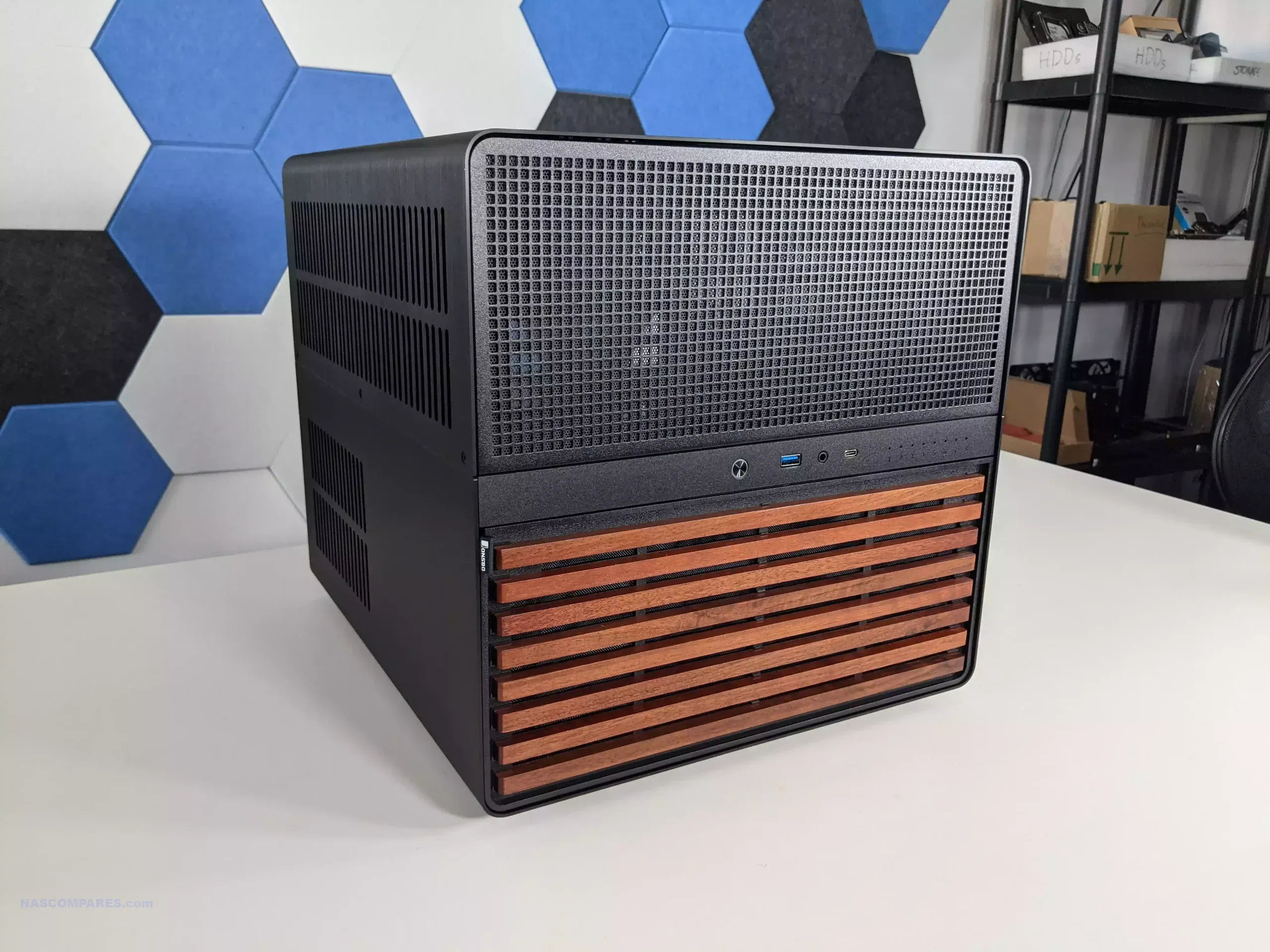
Jonsbo N5 Review – Design (External)
To say that the N5 is a bit big would be a wild understatement. The Jonsbo N5 isn’t just big; it is almost the size of all three Jonsbo N1, N2, and N3 combined! You are looking at the volumetric equivalent of a 12-bay rackmount system boiled down into a desktop enclosure—all the while supporting full-height and full-length PCIe cards, coolers, and accessories. Measuring 35 cm by 40 cm by 35 cm (and over 7.5 kg in weight), this is one seriously large case in every dimension. You do not need to necessarily fill this system on day one, but it’s definitely clear that the N5 is designed for long-term upgrades and scalability.
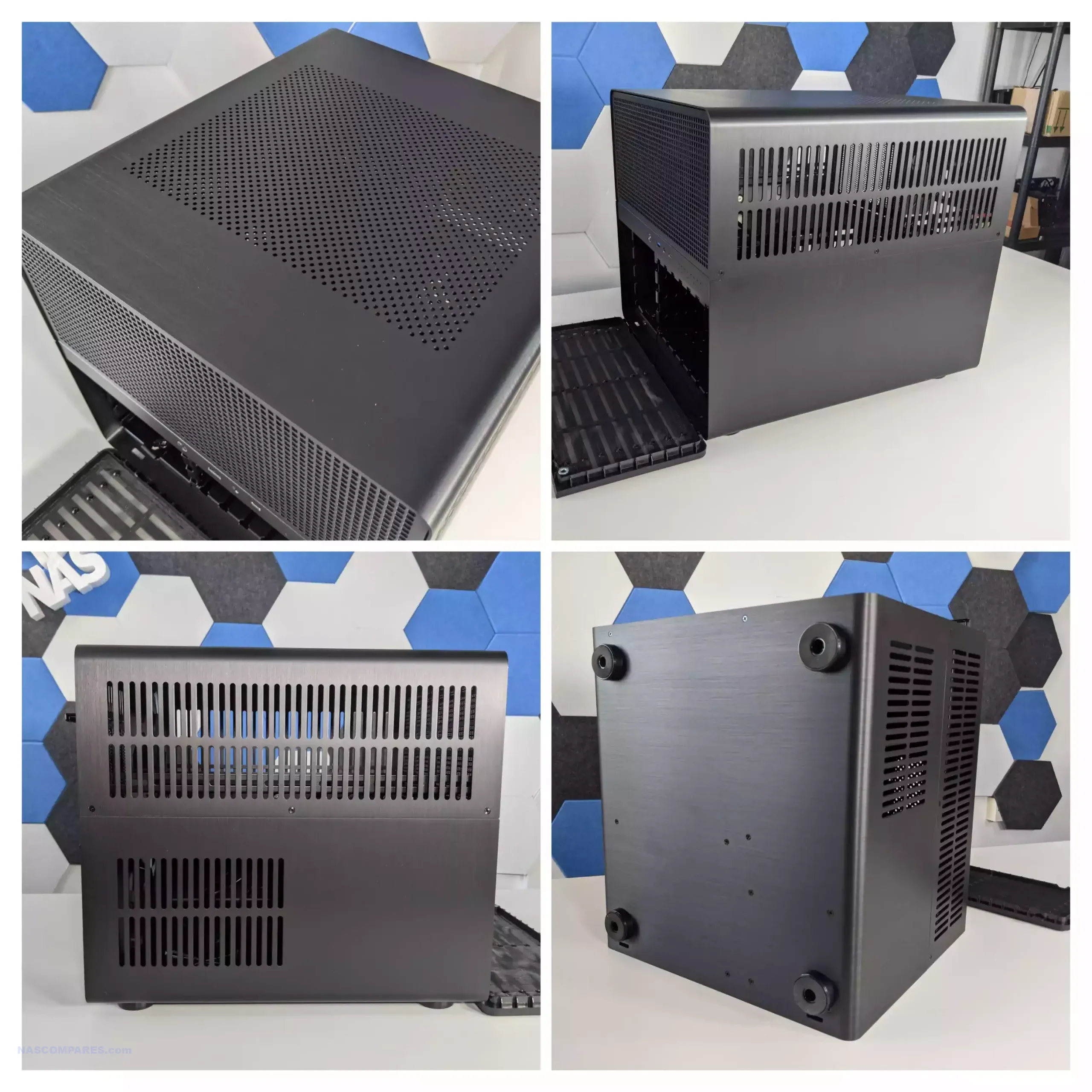
Just to give you a little bit of perspective, below you can see the front-facing size comparison of the Jonsbo N2 versus N3 versus N4 versus N5. There is no gradual growth here, and in fact, it’s a huge scale-up between the N4 and N5.
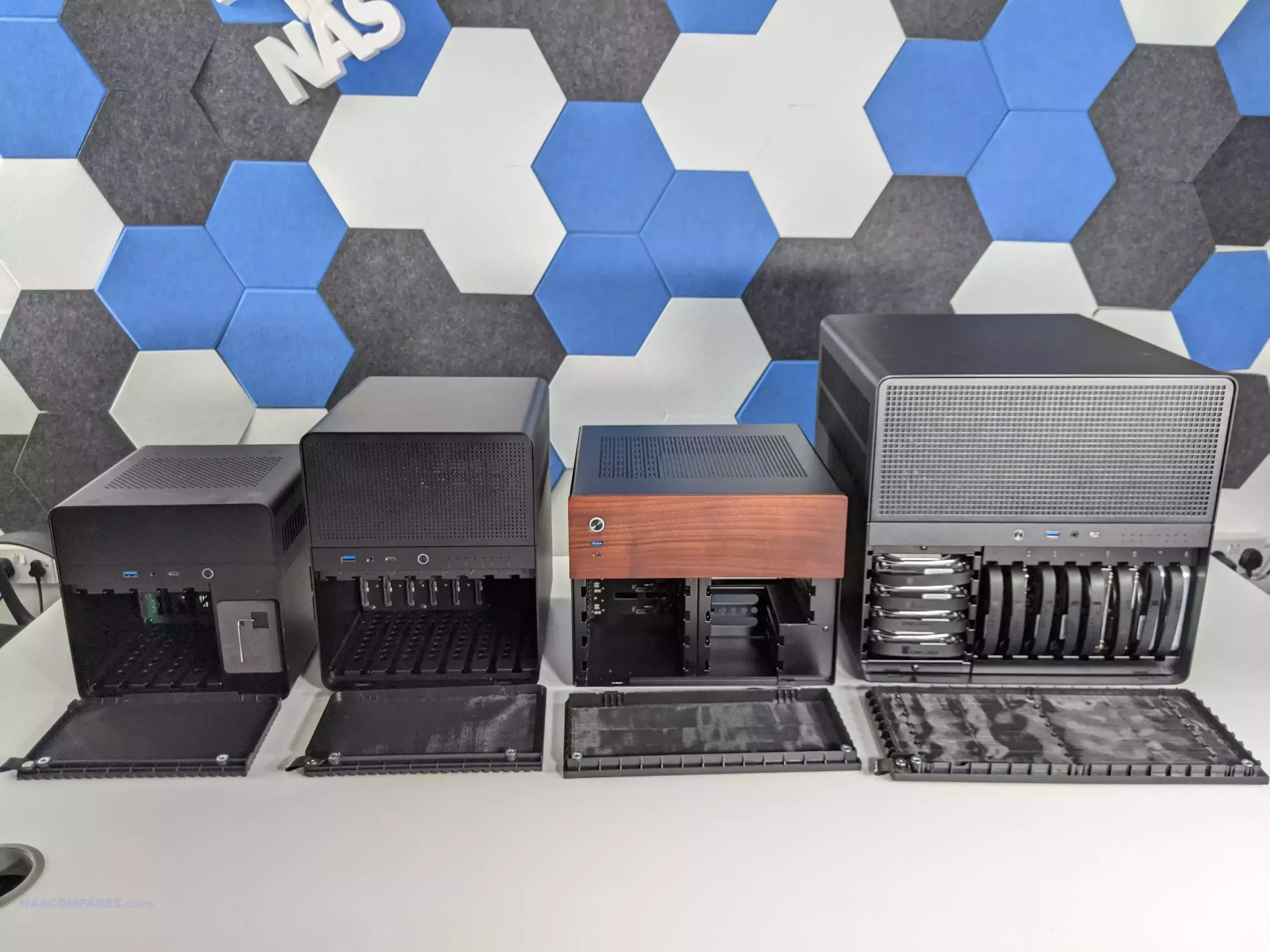
Indeed, this is factored into the depth of the three cases too. When you have the N2, N3, N4, and N5 facing sideways, you can see the full depths of the N5 realized to a great deal better.
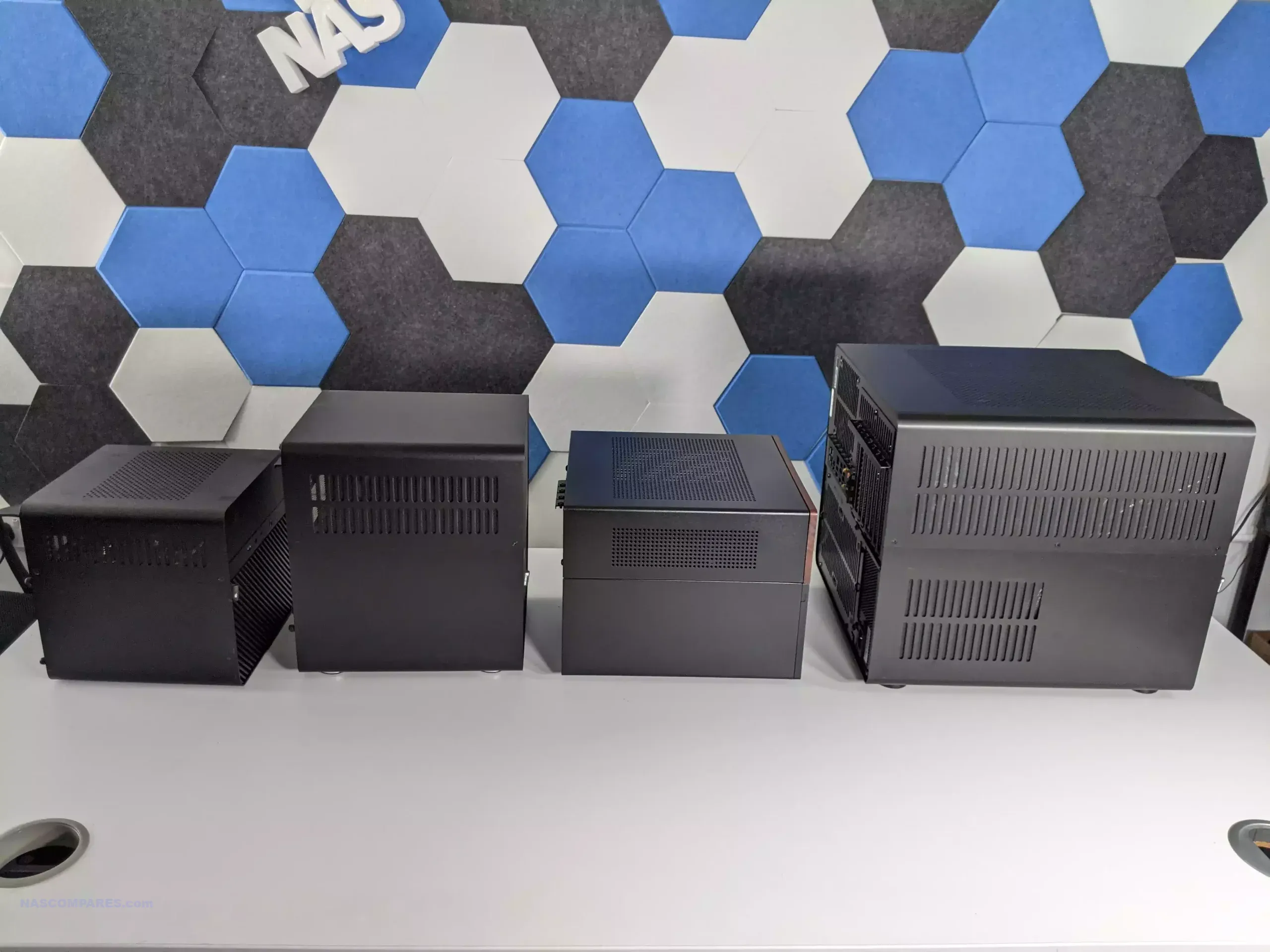
For a better understanding of how these four cases differ in their full specifications, use the chart below:
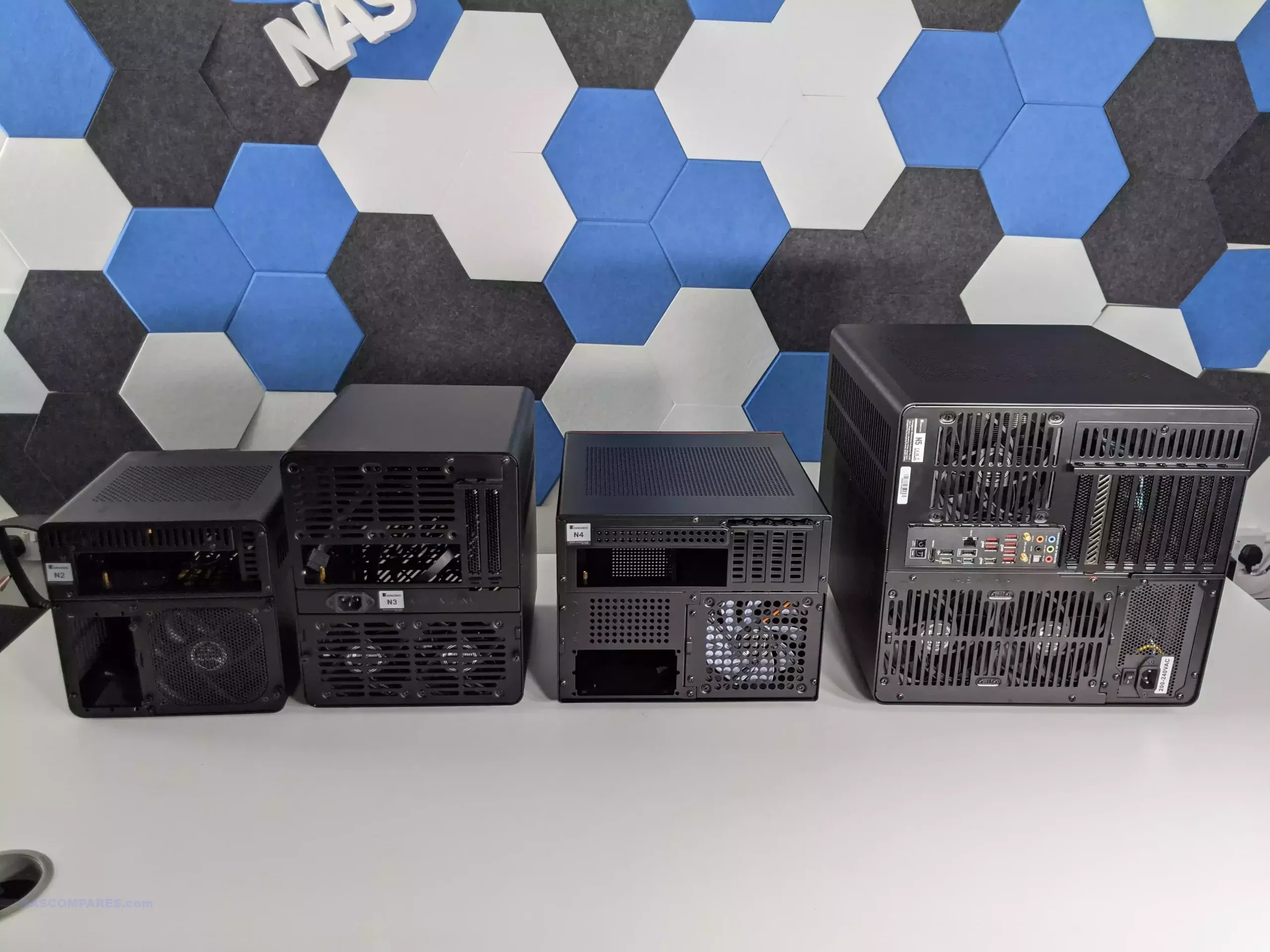
| Specification | Jonsbo N1 | Jonsbo N2 | Jonsbo N3 | Jonsbo N4 | Jonsbo N5 |
|---|---|---|---|---|---|
| Dimensions (W x D x H) | 170mm x 354mm x 217mm | 222.5mm x 222.5mm x 224mm | 233mm x 262mm x 298mm | 286mm x 300mm x 228mm | 355mm x 403mm x 350mm |
| Material | 3mm Aluminum alloy (External), 1mm Steel | 2mm Aluminum alloy (External), 1mm Steel | 2mm Aluminum alloy (External), 1mm Steel | 0.7mm Steel + Wood | 1mm Steel + 2mm Aluminum alloy + 8mm Wood |
| Drive Bay | 2.5″ SSD1 / 3.5″ HDD5 | 2.5″ SSD1 / 3.5″ HDD5 | 2.5″ SSD1 / 3.5″ HDD8 | 2.5″ SSD2 / 3.5″ HDD6 | 2.5″ SSD4 / 3.5″ HDD12 |
| Motherboard Support | ITX | ITX | ITX | ITX / M-ATX | ITX / M-ATX / ATX / E-ATX |
| PCI Expansion Slots | 1 (Low profile) | 1 (Low profile) | 2 | 4 | 8 |
| Max CPU Cooler Height | 70mm | 65mm | 130mm | 70mm | 160mm |
| Max GPU Length | 185mm (Low profile) | 197mm (Low profile) | 250mm | 230mm | 350mm |
| Cooling System | 1 x 140mm (built-in) | 1 x 120mm (built-in) | 2 optional 100mm (HDD), 2 optional 80mm (MB) | 1 x 120mm (built-in) | 11 total fan slots (120mm and 140mm) |
| Weight | 3.8kg | 2.9kg | 3.9kg | 3.75kg | 7.5kg |
One thing that is worth highlighting is that although the case looks tremendously imposing in its largely metallic chassis that is going to dominate your desktop, the black matte steel is only 1 mm thick. This doesn’t mean that heat dissipation won’t be pretty effective on the casing, but it also means that it is going to amplify ambient noise when the system is in operation. This is especially true if you start adding even more internal fans to the system for cooling or use larger than 10TB drives, which have a tendency to be more industrially built.
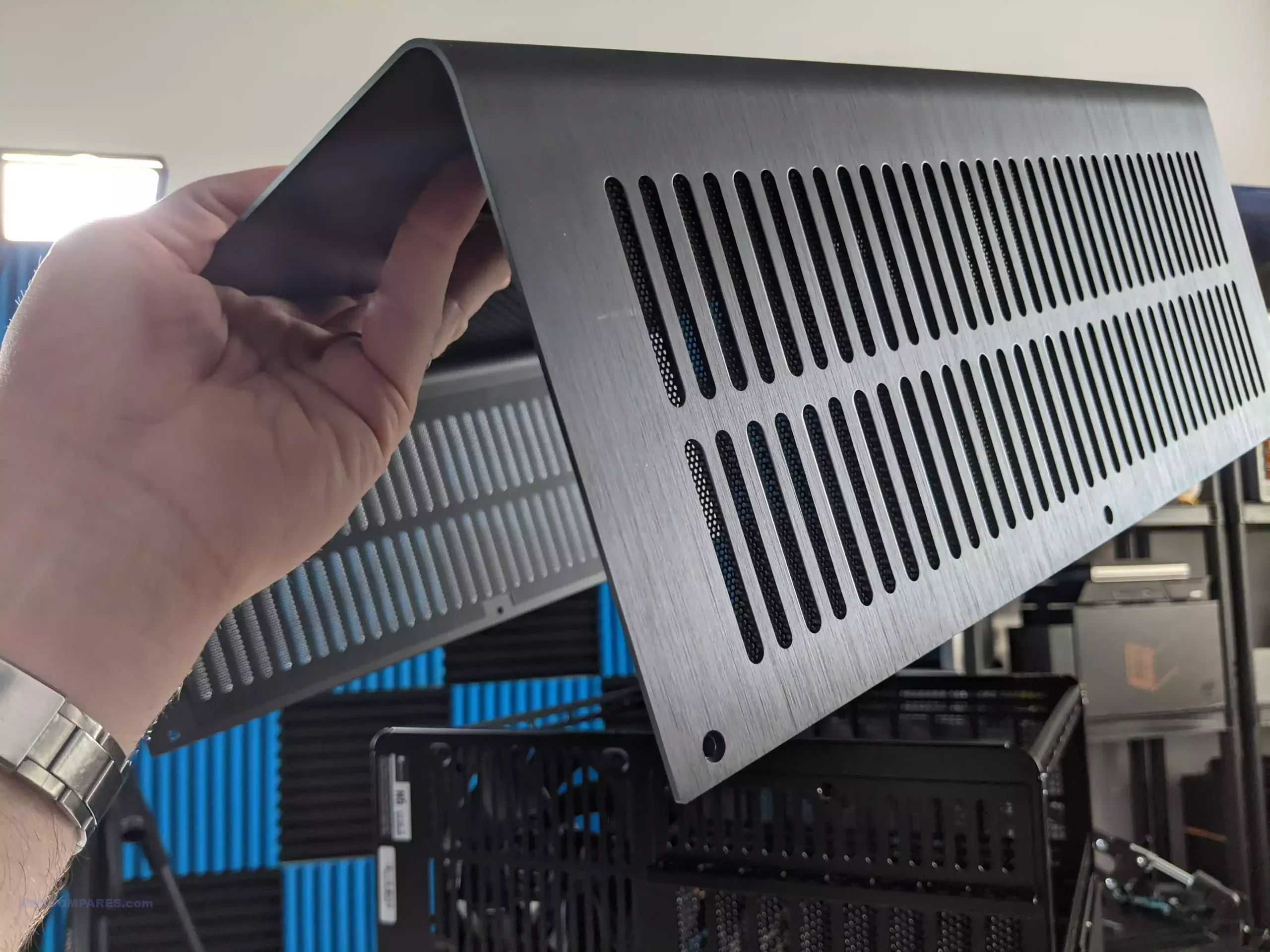
The N5 has passive ventilation coming out of the wazoo in practically every direction. From ventilation on the top of the case, vented slots on either side, the entirety of the front panel featuring two-stage ventilation at the top and bottom, and the rear of the casing being filled with more holes than a particularly unlucky gangster, Jonsbo is clearly aware of the fact that this system is going to be massively reliant on airflow to keep the large quantity of internal components cool.
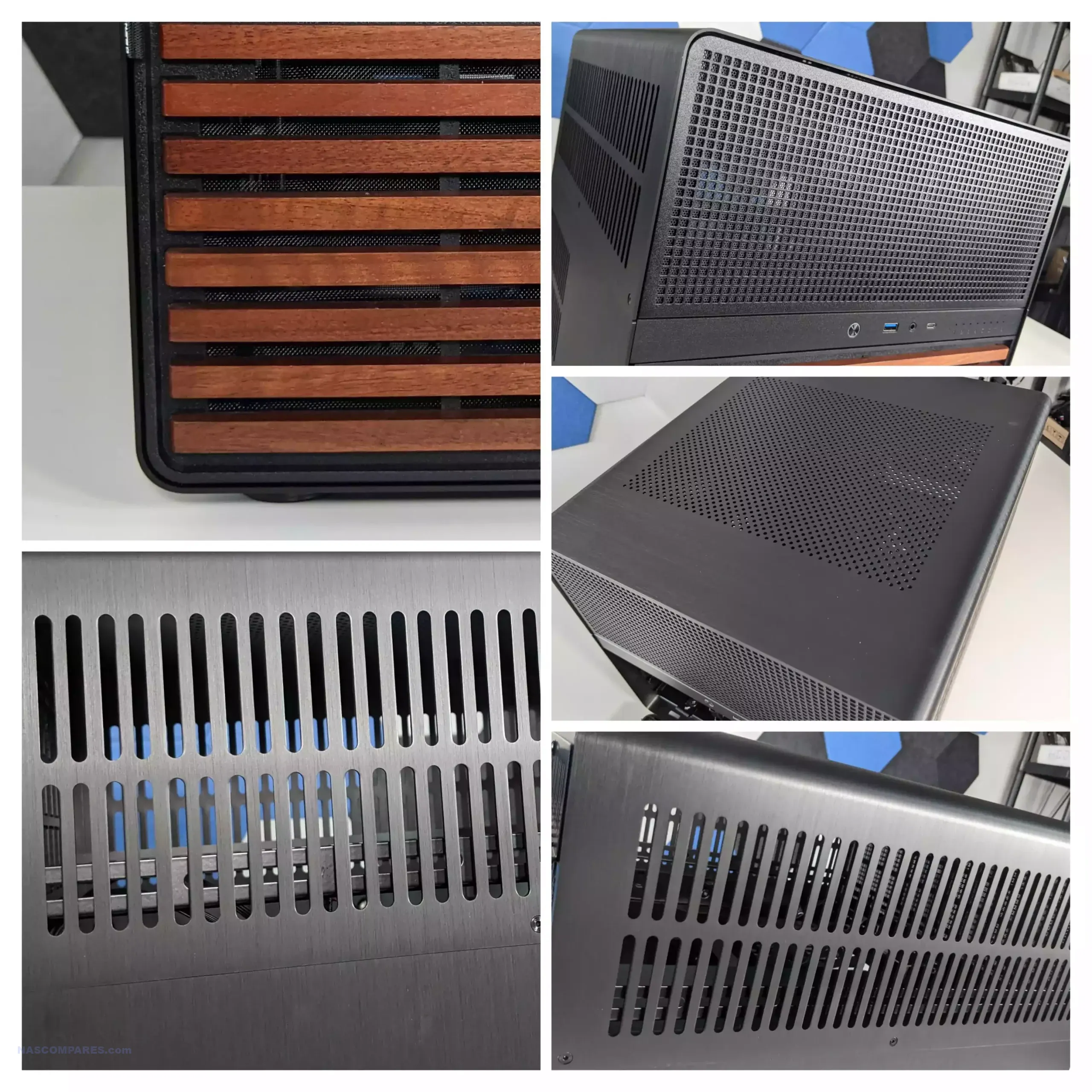
Additionally, the kit includes three adhesive mesh dust panels that can be fitted to the three vents on the side compartments of the N5 enclosure. These are completely optional, but I would still recommend utilizing them to limit any kind of external detritus when using this big old case!
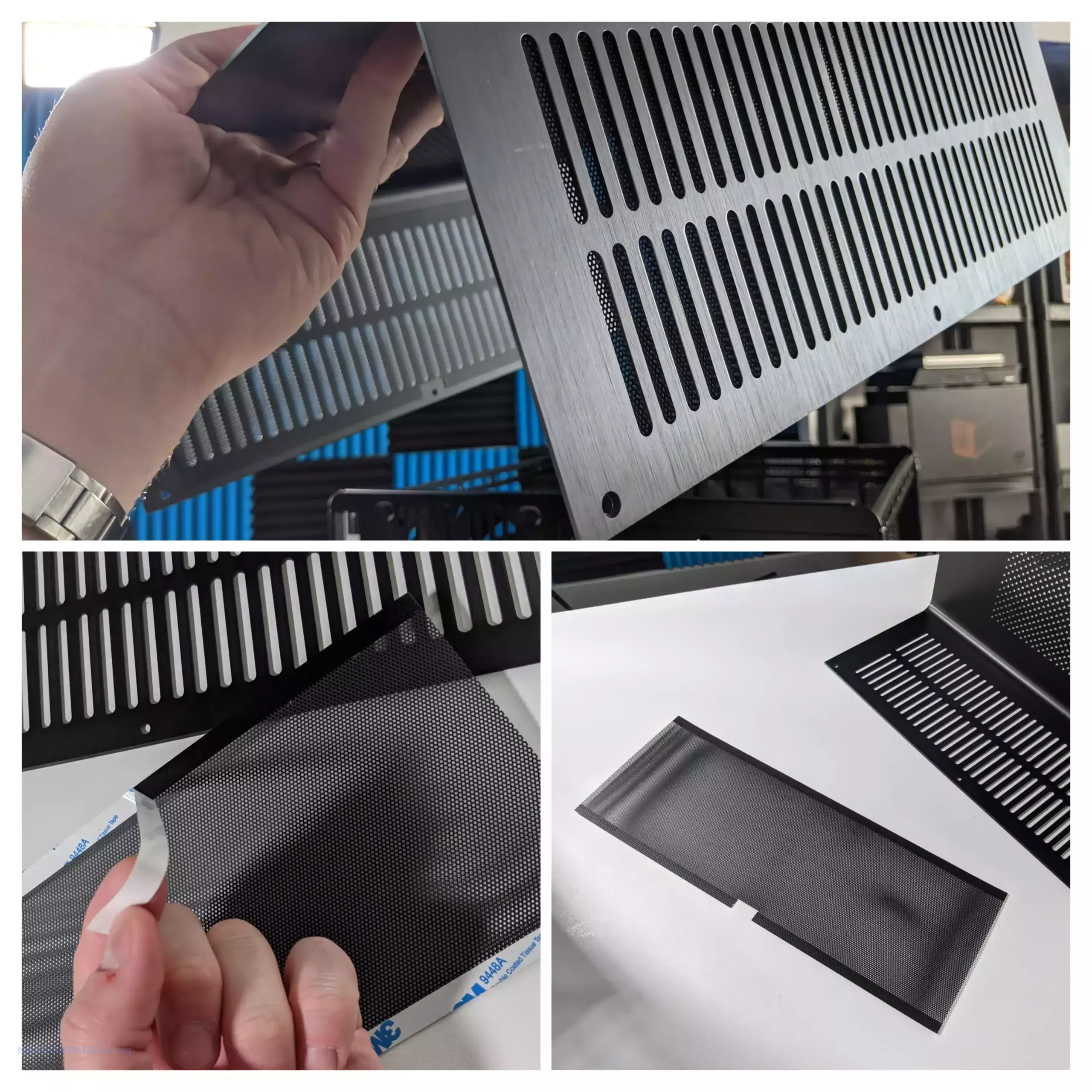
The front panel also features a pre-fitted mesh dust panel behind its large ventilation slits throughout. The front panel comes off easily thanks to a fabric pull handle and is real wood, at 8 mm thick.
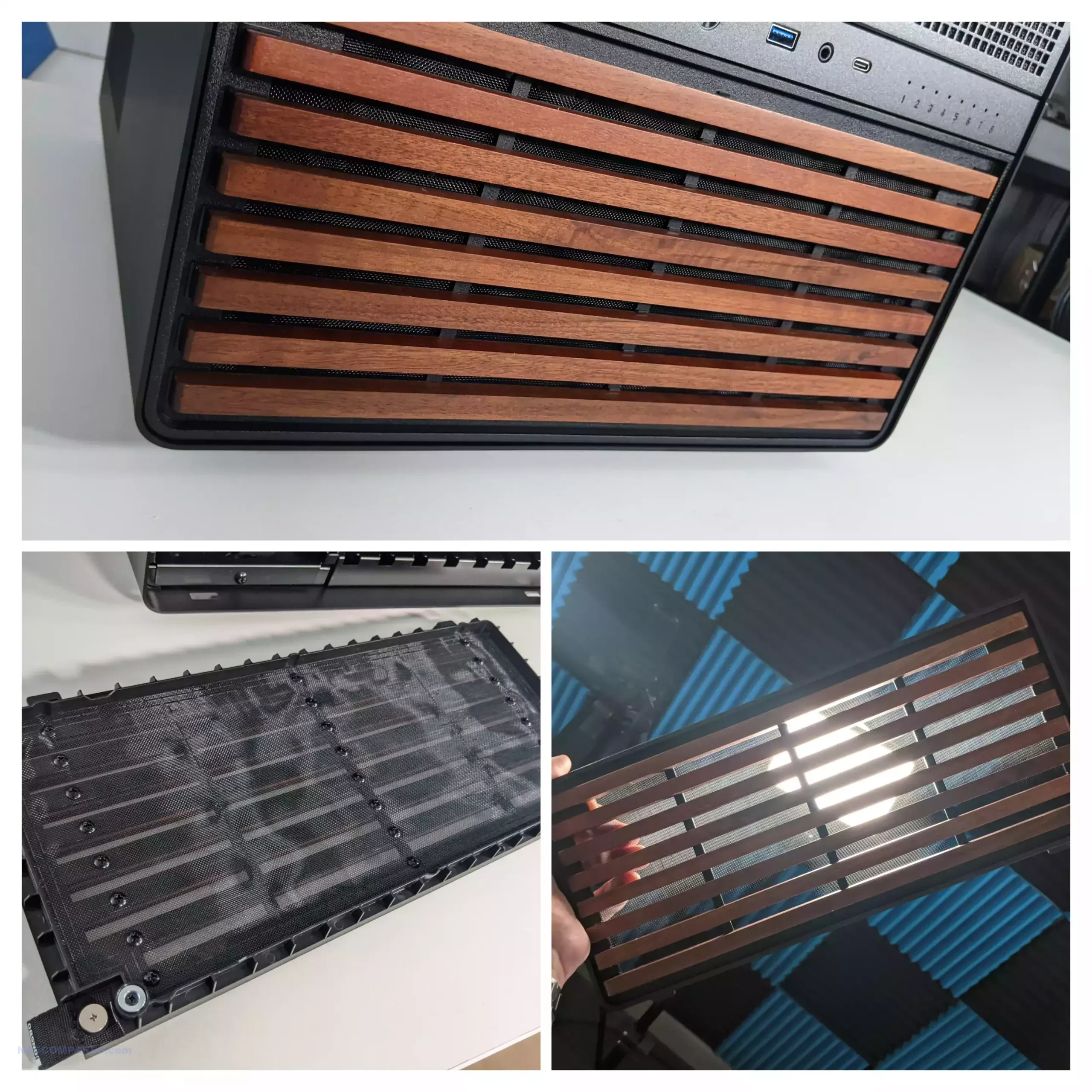
LED indicators that show drive health and activity are oddly displaced on the system. However, the eight vertical bays have their own eight dedicated LEDs shown clearly on the front panel of the N5 and are as clear as you would expect. However, the four horizontally mounted drives have their own LEDs tucked somewhat hidden to the left of the casing internally and are by no means as clear as the initial eight LEDs. This is an odd choice and one that I can only assume is down to utilizing the original N3 design a little too much, or the difficulty of porting in the four additional LEDs from the sub HDD cage into that front panel smoothly.
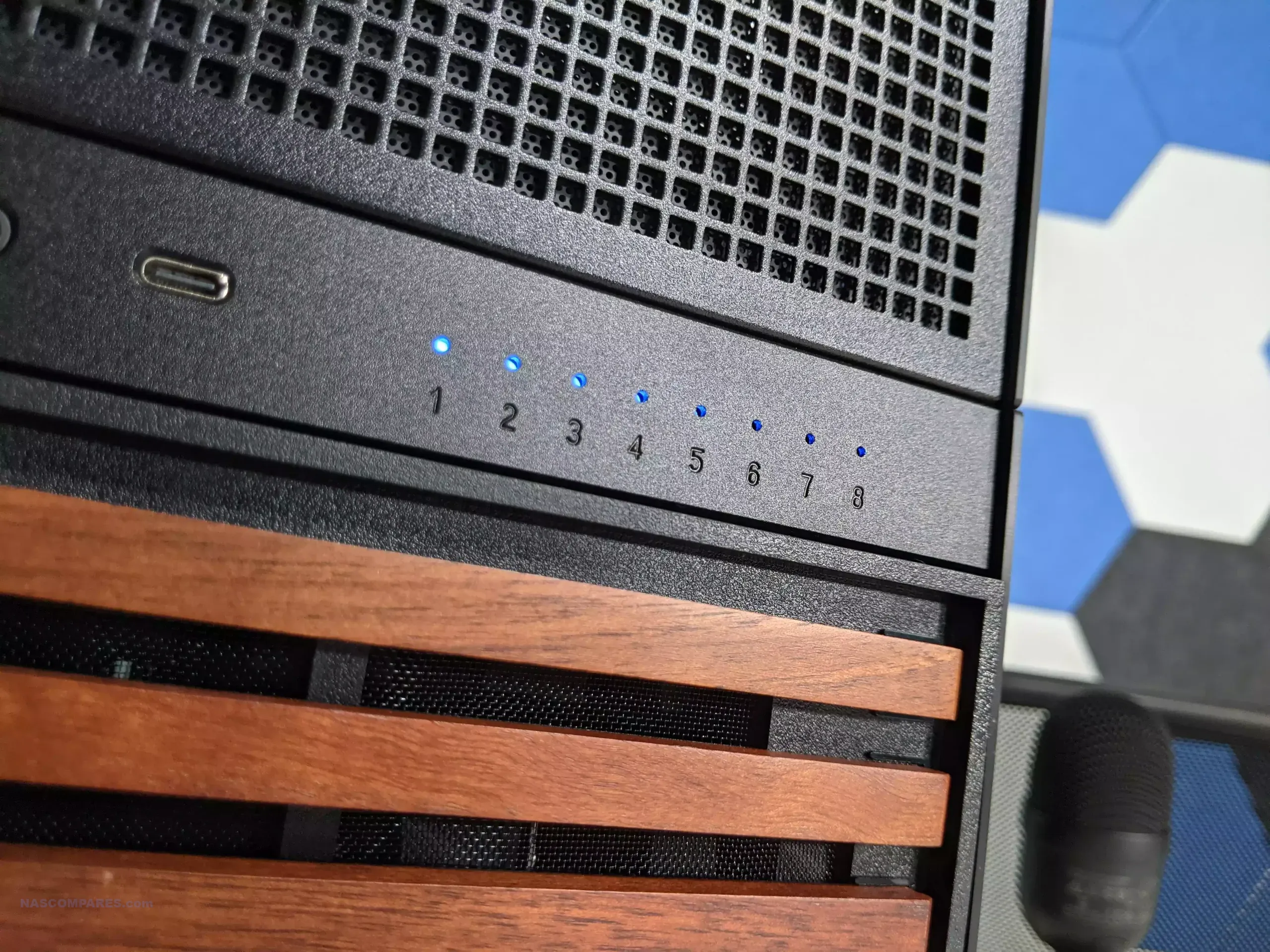
I populated the system with 12 3.5-inch hard drives, and each drive feeds directly into its own dedicated combined SATA power and data interface—no loose wires and all interfaces are mounted on their own PCB backplane. Internally, it is actually two separate PCBs, with eight on one and four on the other.
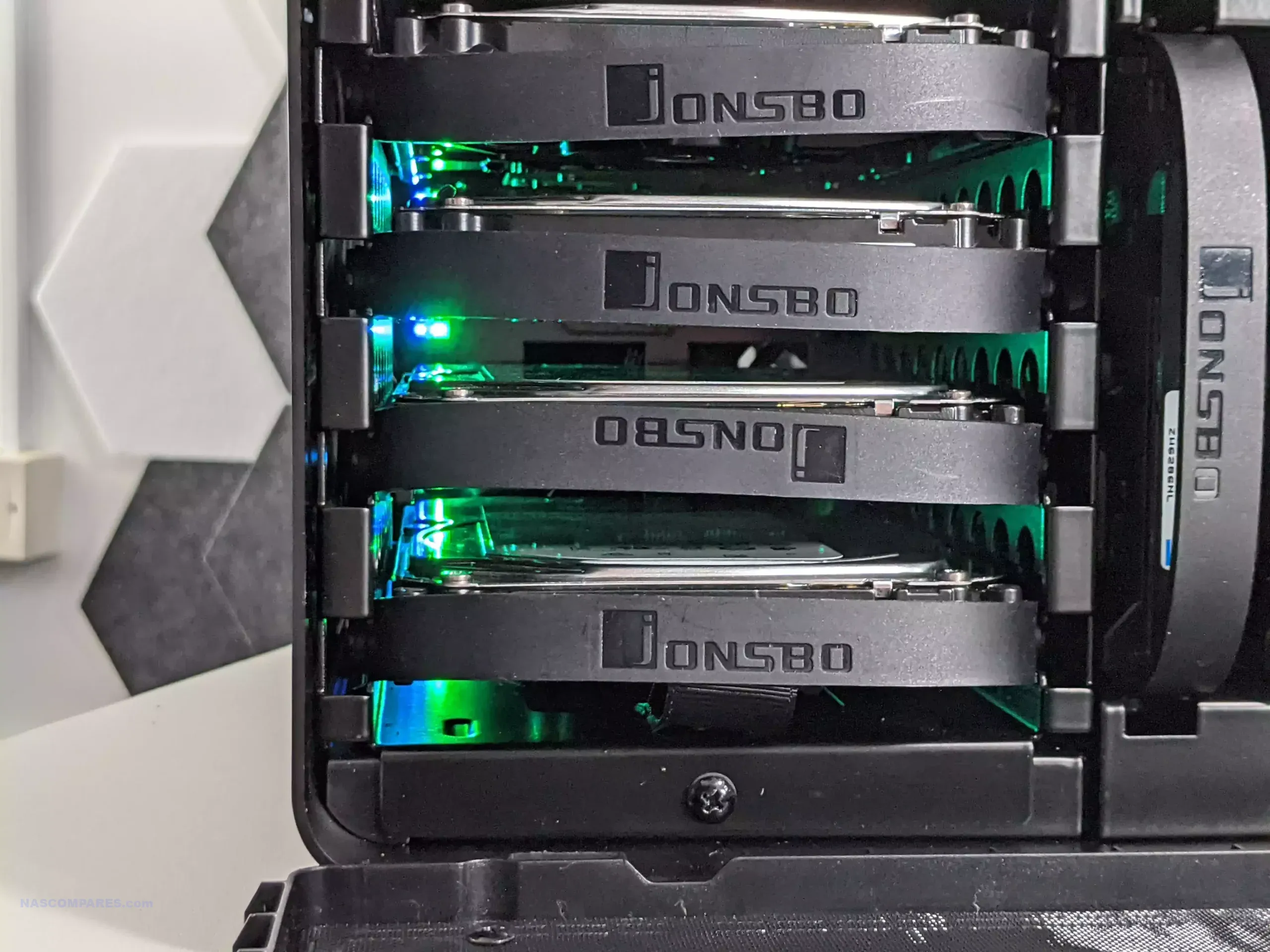
However, I’m sad to say that Jonsbo still persists in using their odd rubber handle and grommet design on hard drive installation instead of traditional trays like everyone else in the market! I have commented on this numerous times in the past through my other reviews of the N2, N3, and N4 systems, and have never really liked these trays.
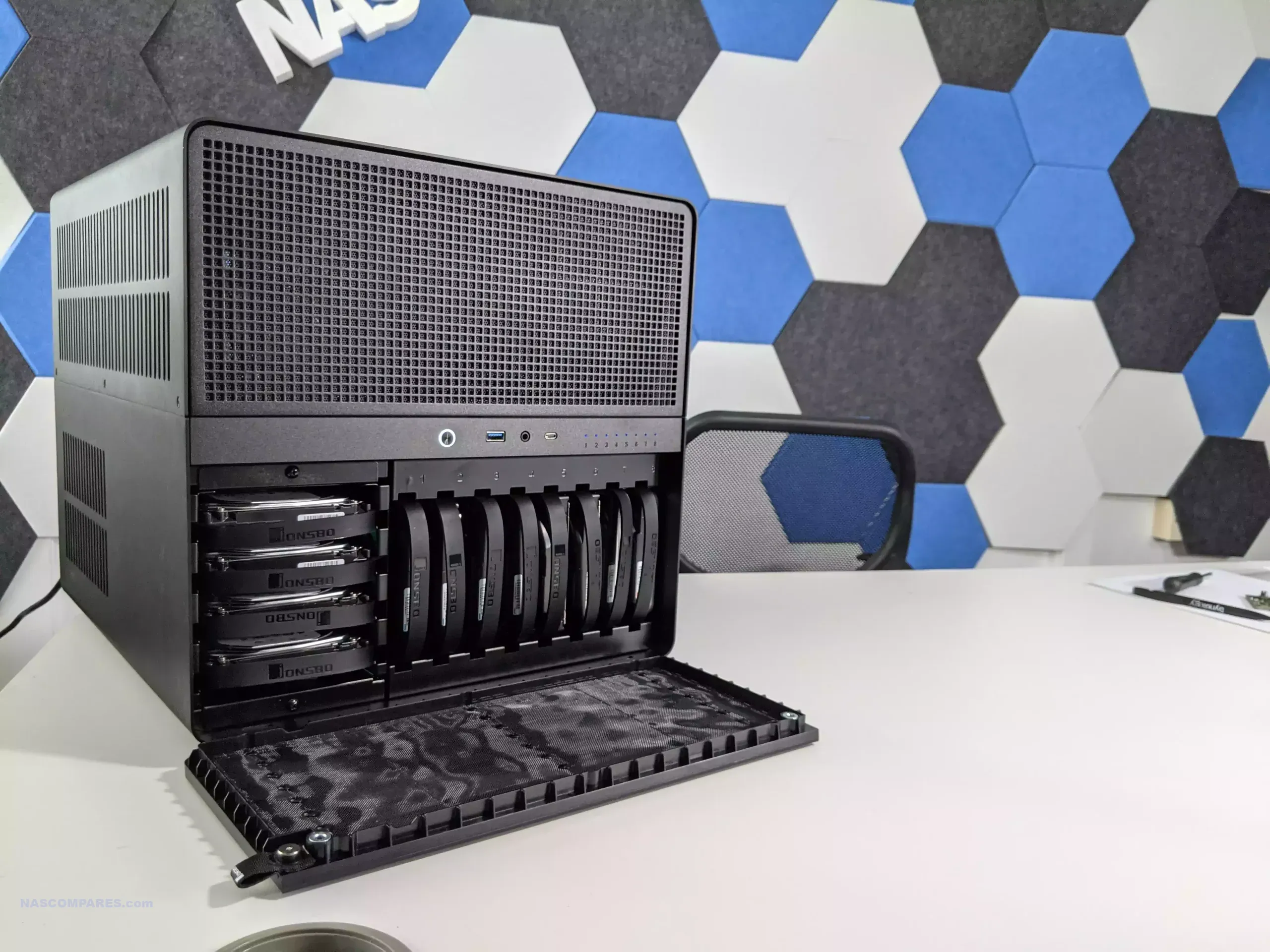
Standard 3.5-inch hard drive trays would be considerably smoother for installation, and the fact that the system feeds directly into static PCB and SATA interfaces internally means that there is no reason for using such a flexible choice of media injection when a static tray would serve just as well—and about 10 times better.
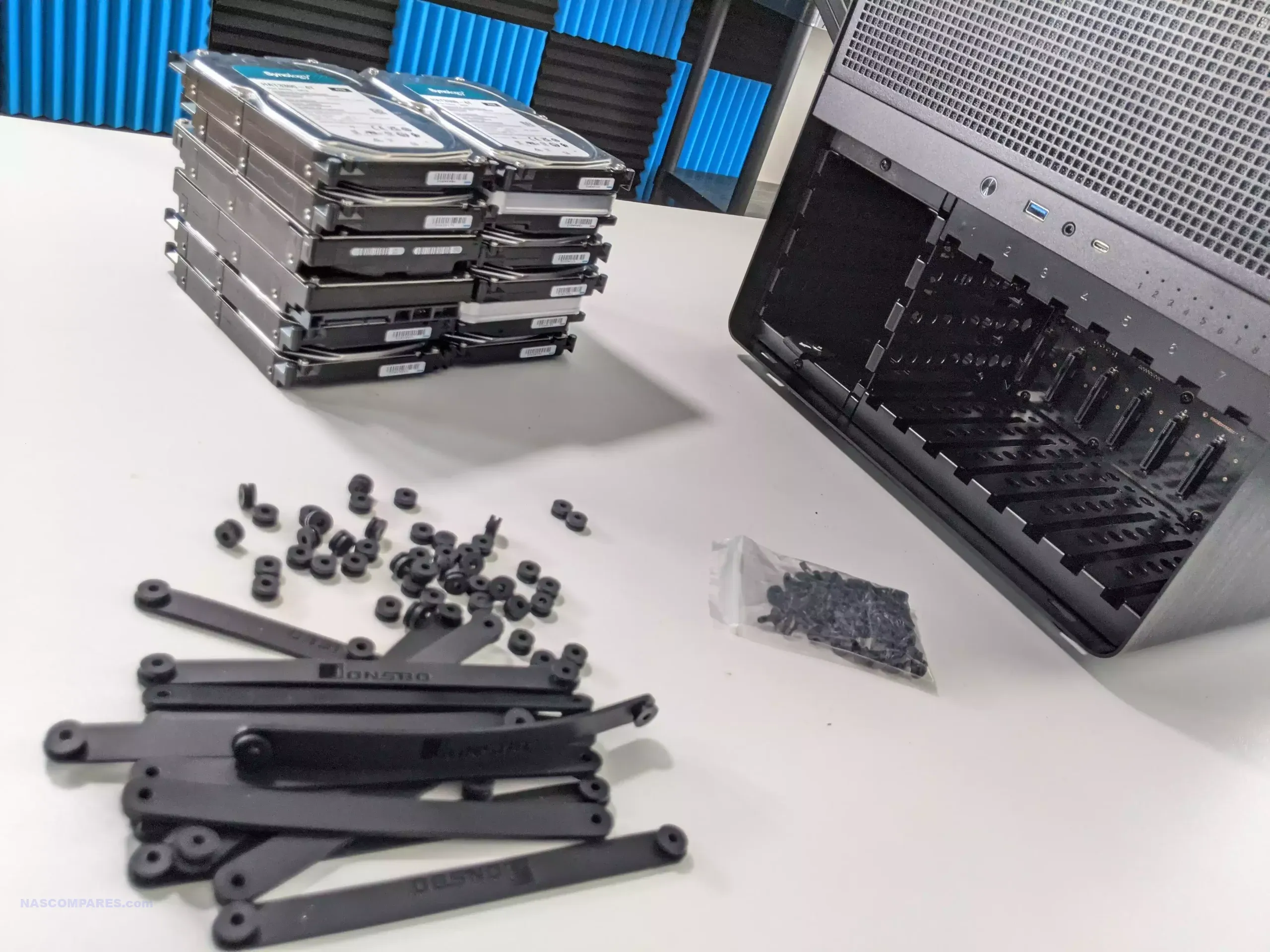
Worse still, I’m not entirely convinced that these rubber handles are safer than trays when it comes to removing drives in the event of a RAID failure and drive swap out. The rubber handles have too much give when pulling and could lead to a potential spring of the drive into your knuckles as you remove it, or worse, that you have to pull it extra hard to remove the drive and the drive ejects, hitting the table. I still don’t understand why Jonsbo persists with these trays.
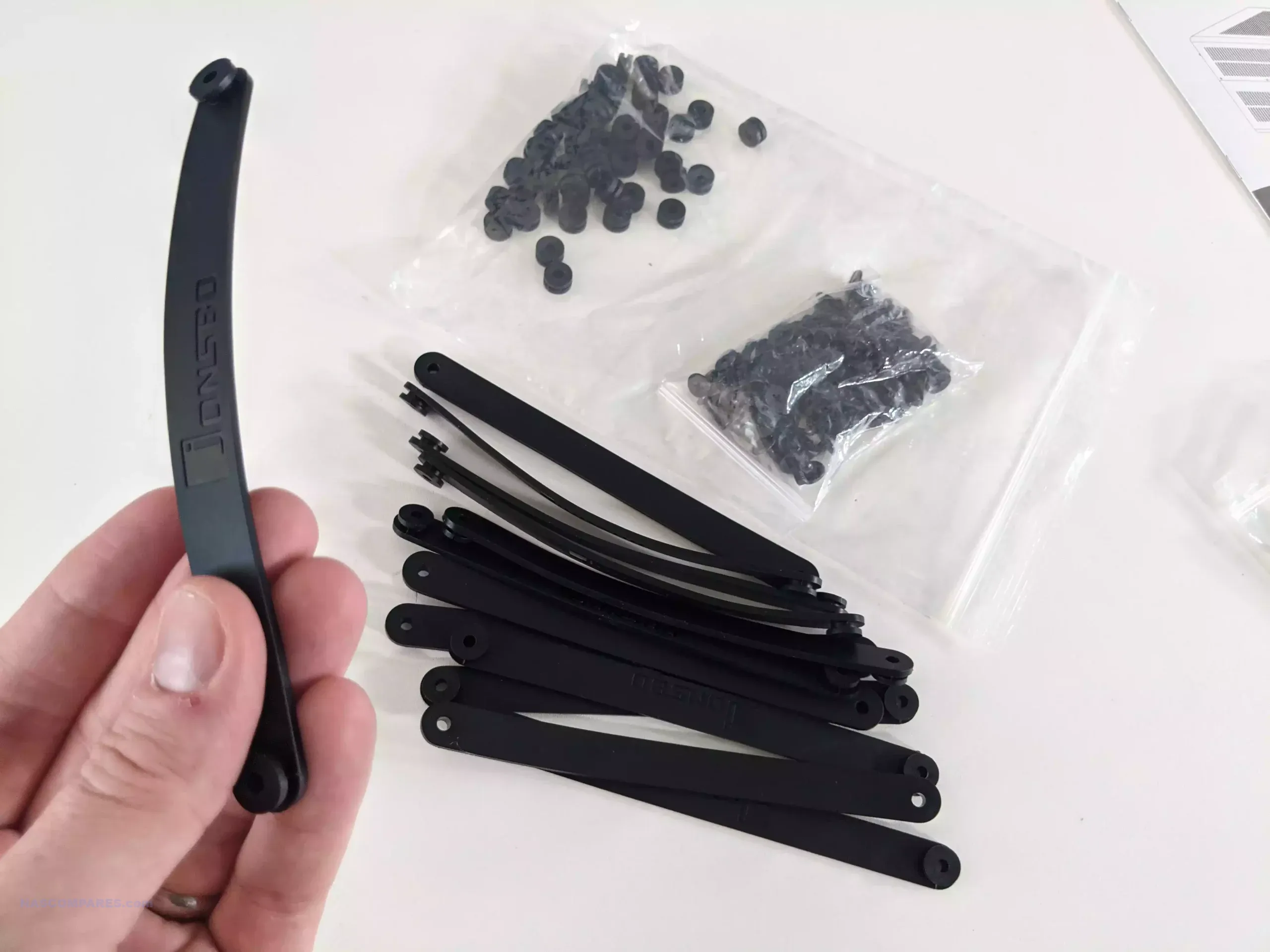
Though, ever so slightly in Jonsbo’s defense, as each drive is being held by six individual rubber grommets that tightly fit inside the internal chassis, there is an argument to be made that these do reduce ambient vibration throughout the rest of the chassis in a way that a loose tray perhaps might not.
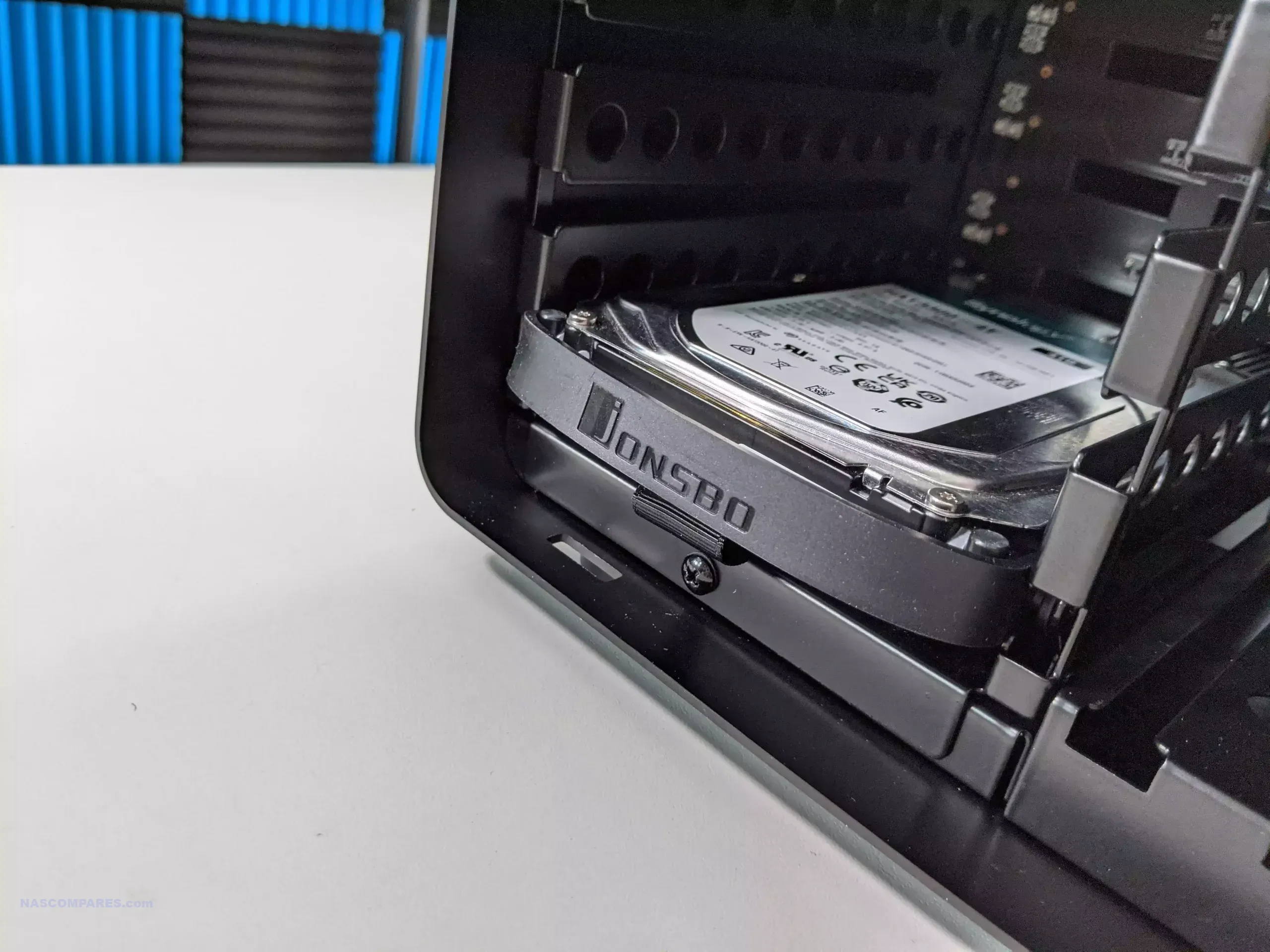
With the system fully populated with 12 hard drives, utilizing the three default fans that the system has on full, as well as a silent CPU cooler, I made two individual noise tests of the system when in operation. The front of the system, which has all of the storage media but lacks any direct active cooling, achieved an average noise level of between 45 and 47 decibels. Now I’m sure these numbers could be lessened by users who plan to use smaller-capacity and less industrially constructed hard drives; nevertheless, I can’t imagine it would be that much quieter given you have 12 drives spinning inside this comparatively packed desktop chassis.
Turning the device around to the fans and ports end, noise was actually fractionally subdued, hitting an average of between 37 and 39 DBA. It is still not exactly a quiet system, but I was actually kind of surprised that these three active cooling fans built into the rear of the chassis did not cause more noise than this.
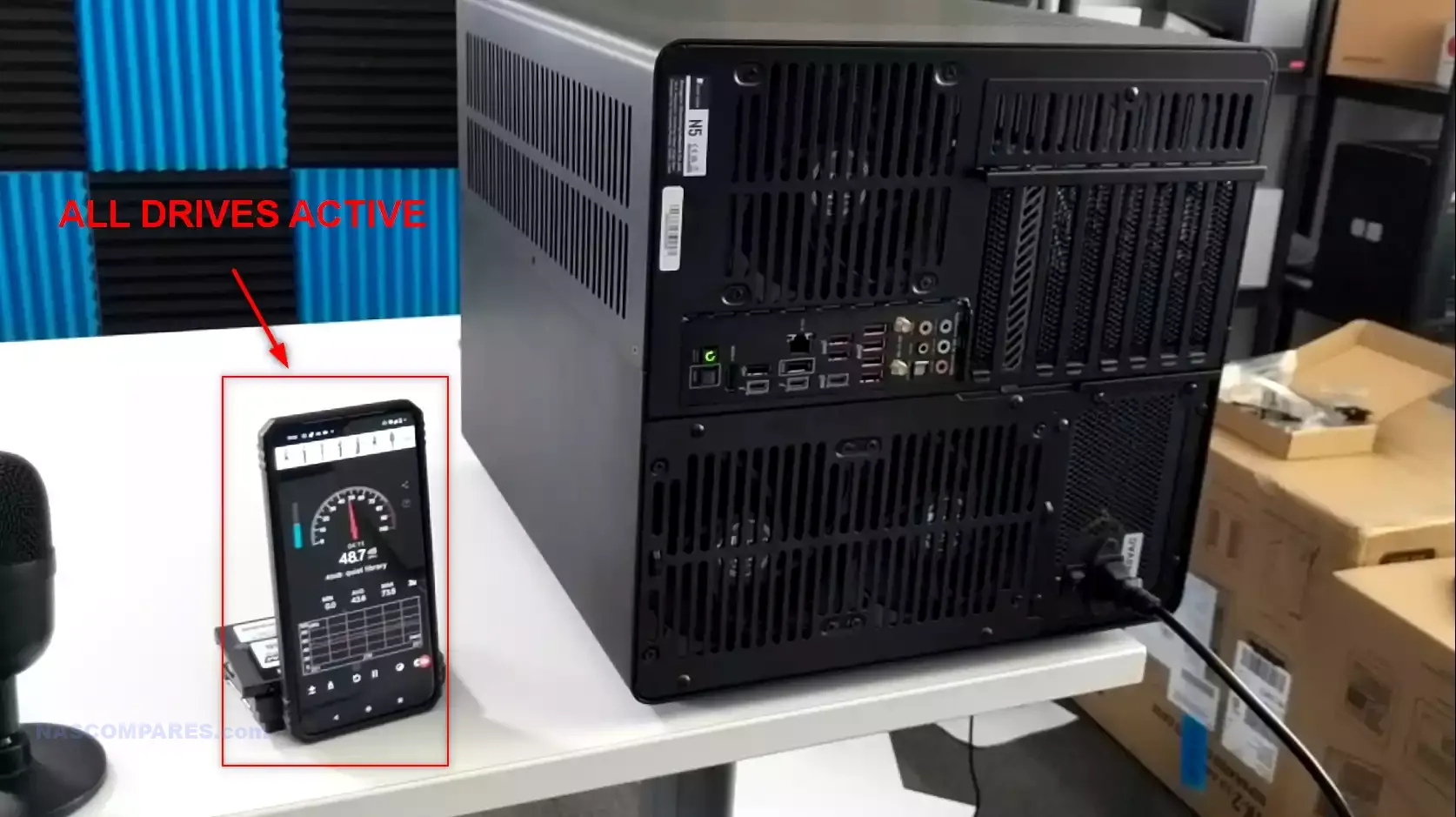
As mentioned earlier, the eight vertically stacked hard drives all back onto an internal PCB that features individual interfaces for each drive, numbered 1 through 8. It also features individual SATA outputs, a SATA power input, and two Molex power inputs.
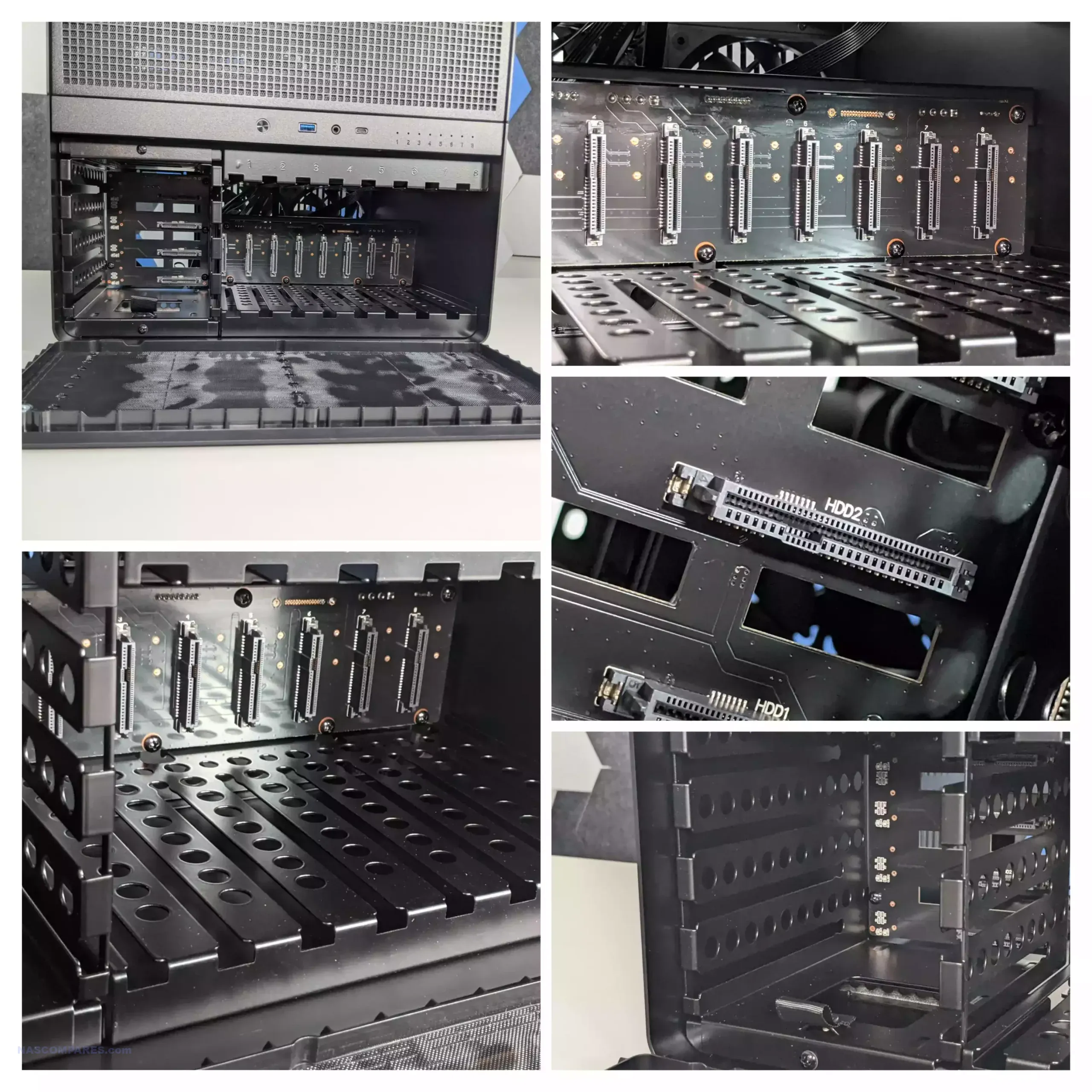
This PCB features an additional SATA power, Molex power, and individual SATA outputs for the drives on the other side of that board. I did start to wonder why exactly Jonsbo had decided on mounting two individual media PCB boards into this system rather than one large dedicated board that funneled all 12 SATA inputs.
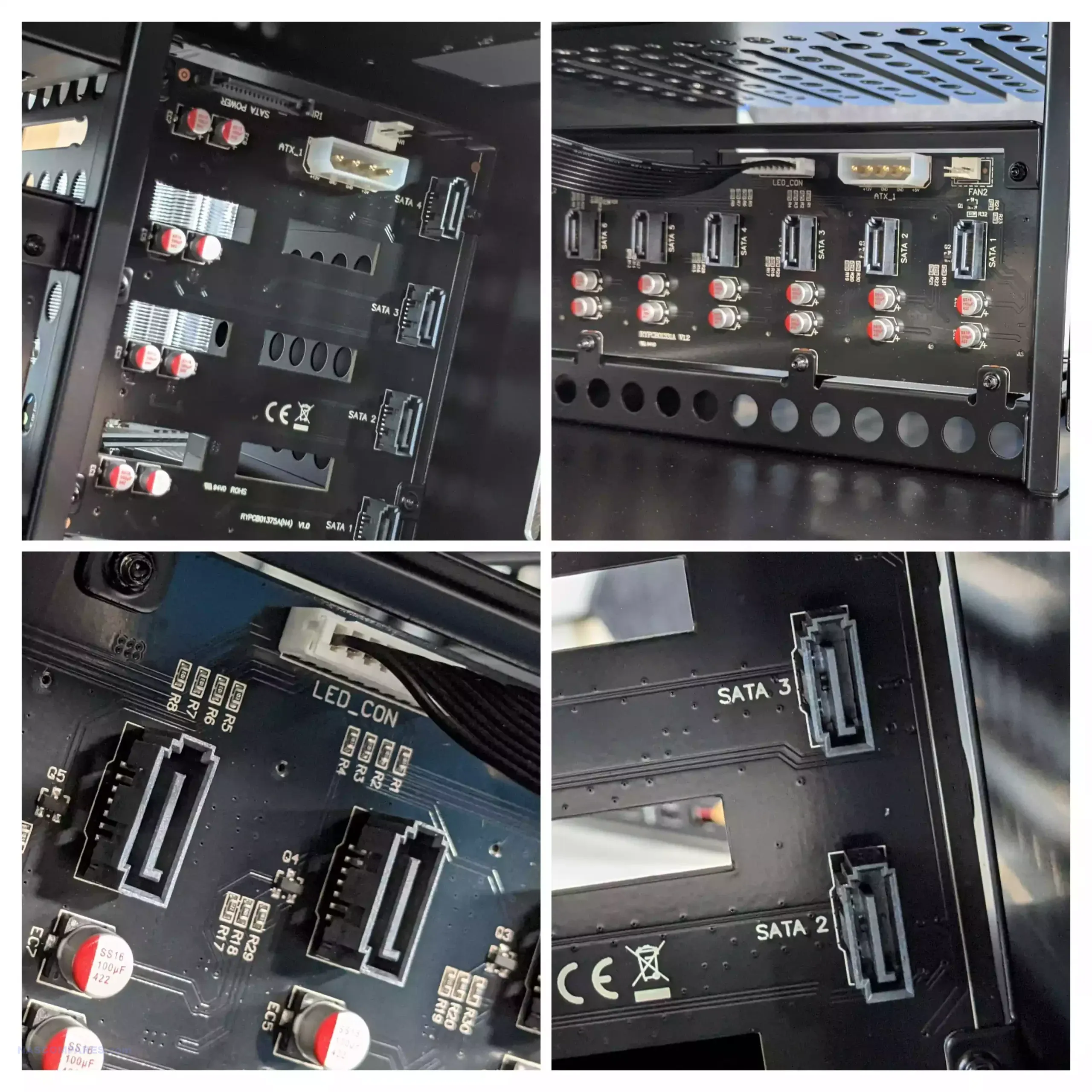
The answer ended up being surprisingly interesting. The four horizontally stacked storage drives are mounted in their very own cage. This cage can be removed from the front of the system via just two screws holding it in place, and this allows you to slide out this main cage and install the drives and the SATA cables considerably more easily after the installation of the PSU and its accompanying cables. The space between the PSU and this four-drive bay area is actually really tight, and there are definitely benefits in having the ability to slide out this storage area for easier access to this cabling, as well as funneling the SATA cables more effectively or applying maintenance to an existing storage setup inside the system.
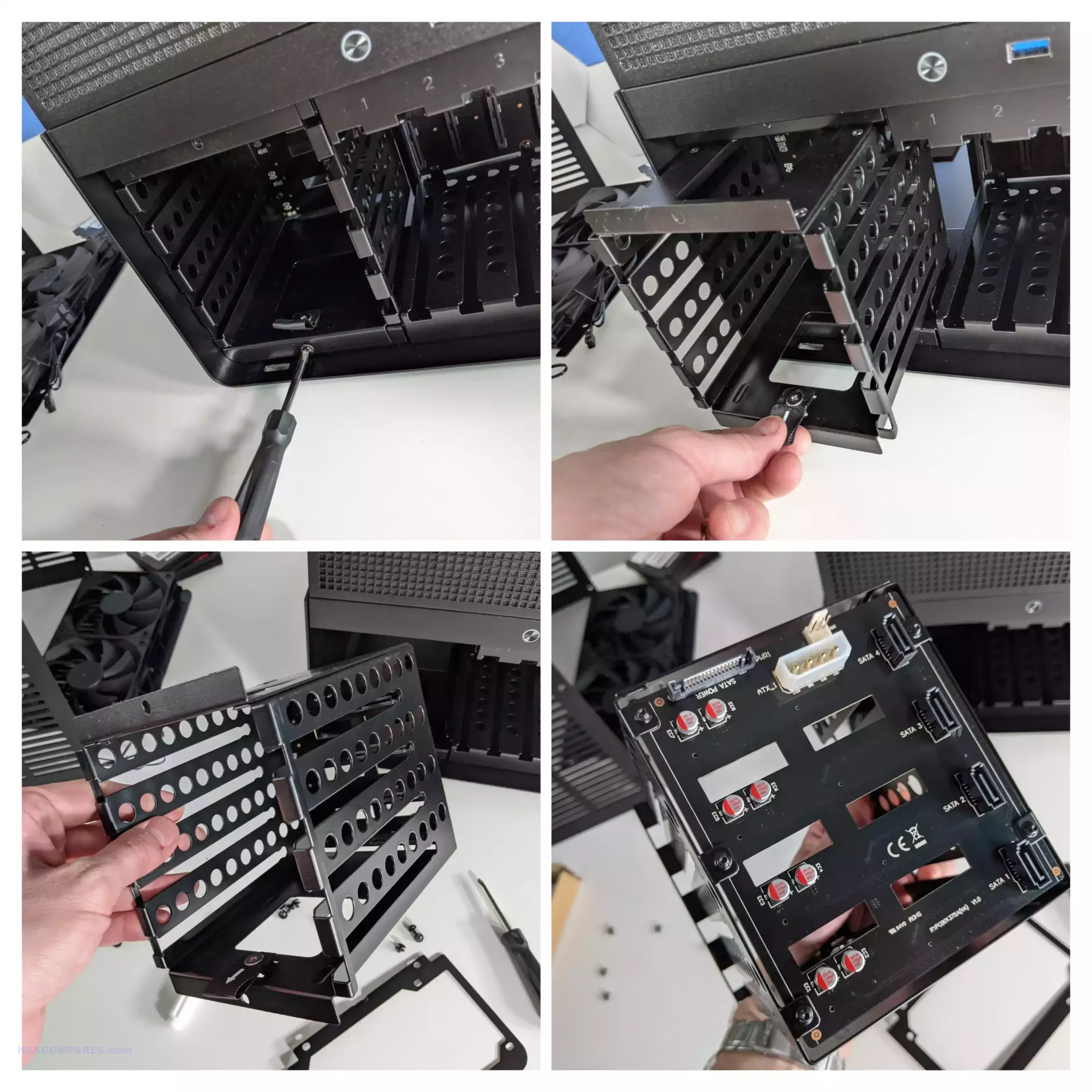
The front of this system features similar ports to previous Jonsbo NAS cases, which include a USB Type-A, a USB Type-C, and audio in and out ports. These USB ports are USB 10G, but that is definitely going to depend on your motherboard installation of choice and whether it is compatible fully with the F-panel cabling inside the N5.
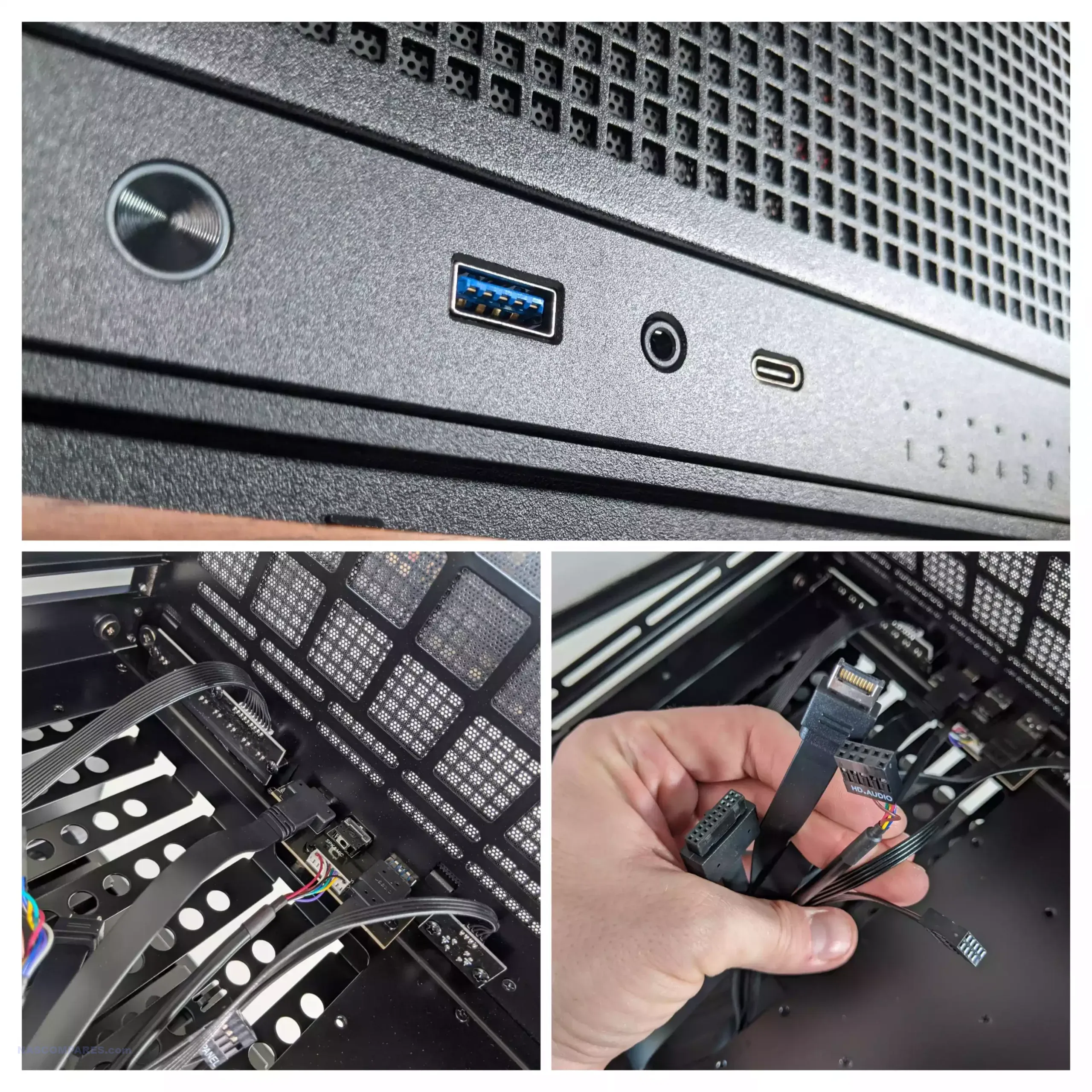
The rear of the case doesn’t feature any further ports, and will be solely reliant on the motherboard that you choose to install inside the case. Pre-populated in any way. You get the case, you get the accessory kit to install your components, and that is it.
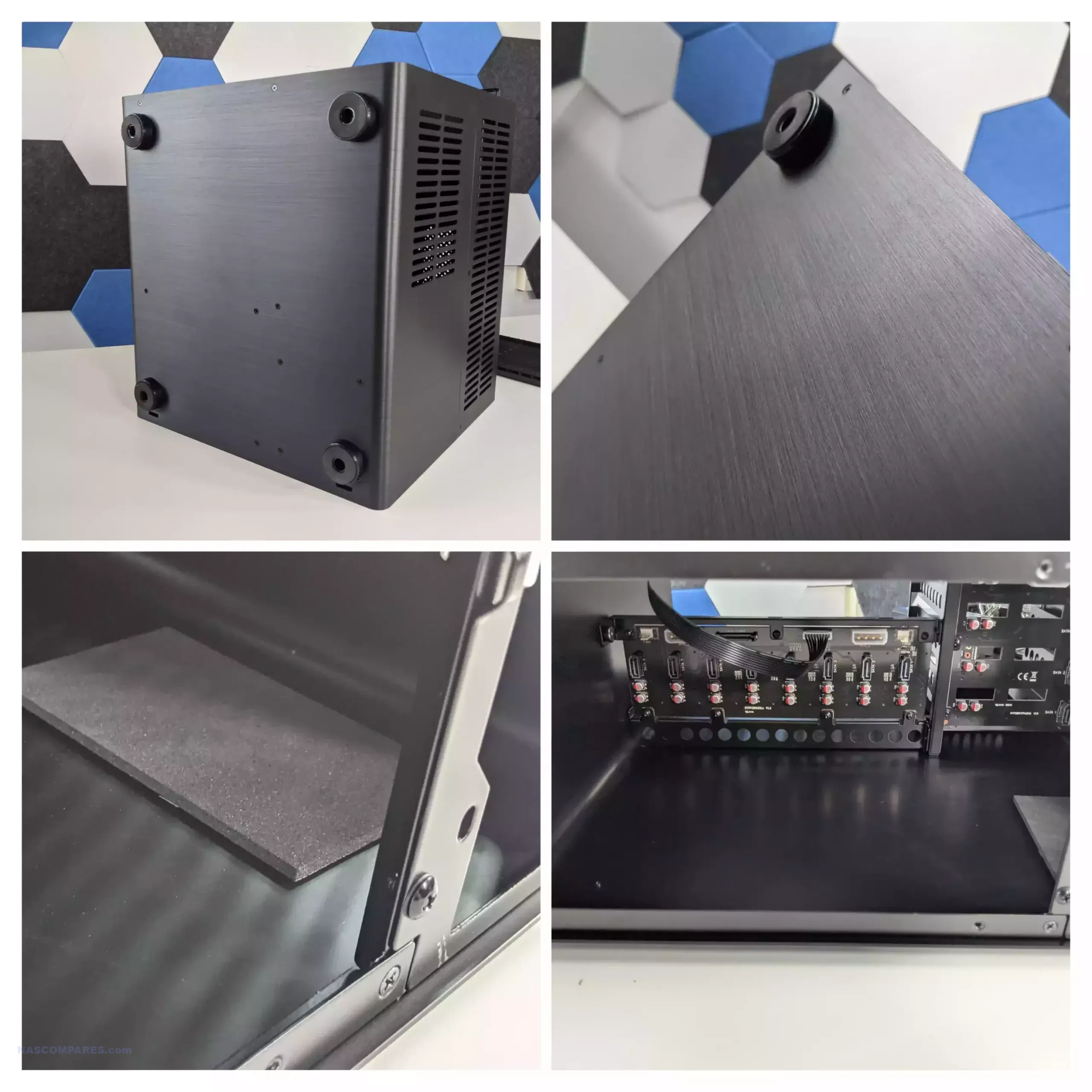
The three fans built into the rear of the N5 are Jonsbo-branded 120 mm fans. There is an argument that replacing these fans with a quieter alternative, such as the Noctua options in the market, but really you would be putting a plaster on a shotgun wound in the case of the N5. This case is going to make a great deal of ambient noise, whether you like it or not, and reducing the fan noise by a few decibels really is not going to make a great deal of difference here.
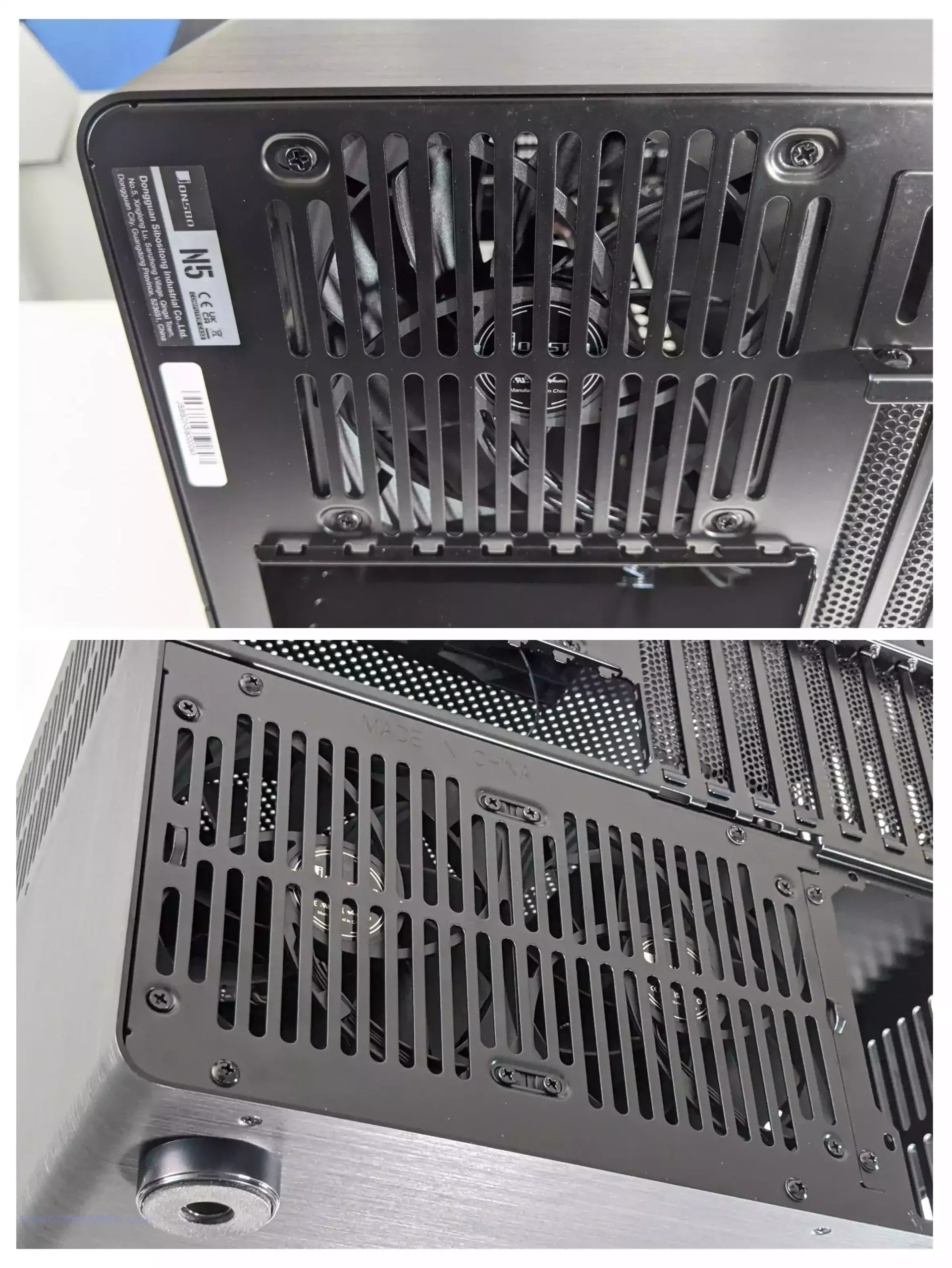
On the inner walls of the sides internally, the N5 features mounting rails, as well as screws to install each of these components included with the accessory kit. These do seem metal basic, but at the same time, hardly any different from the other popular large-scale NAS cases like the Fractal Node 804. I would have, of course, preferred to see direct 2.5-inch SATA injection rather than loose cables and a light framework, but at least you have these two side-mounted frames to add small system mods conveniently to hand.
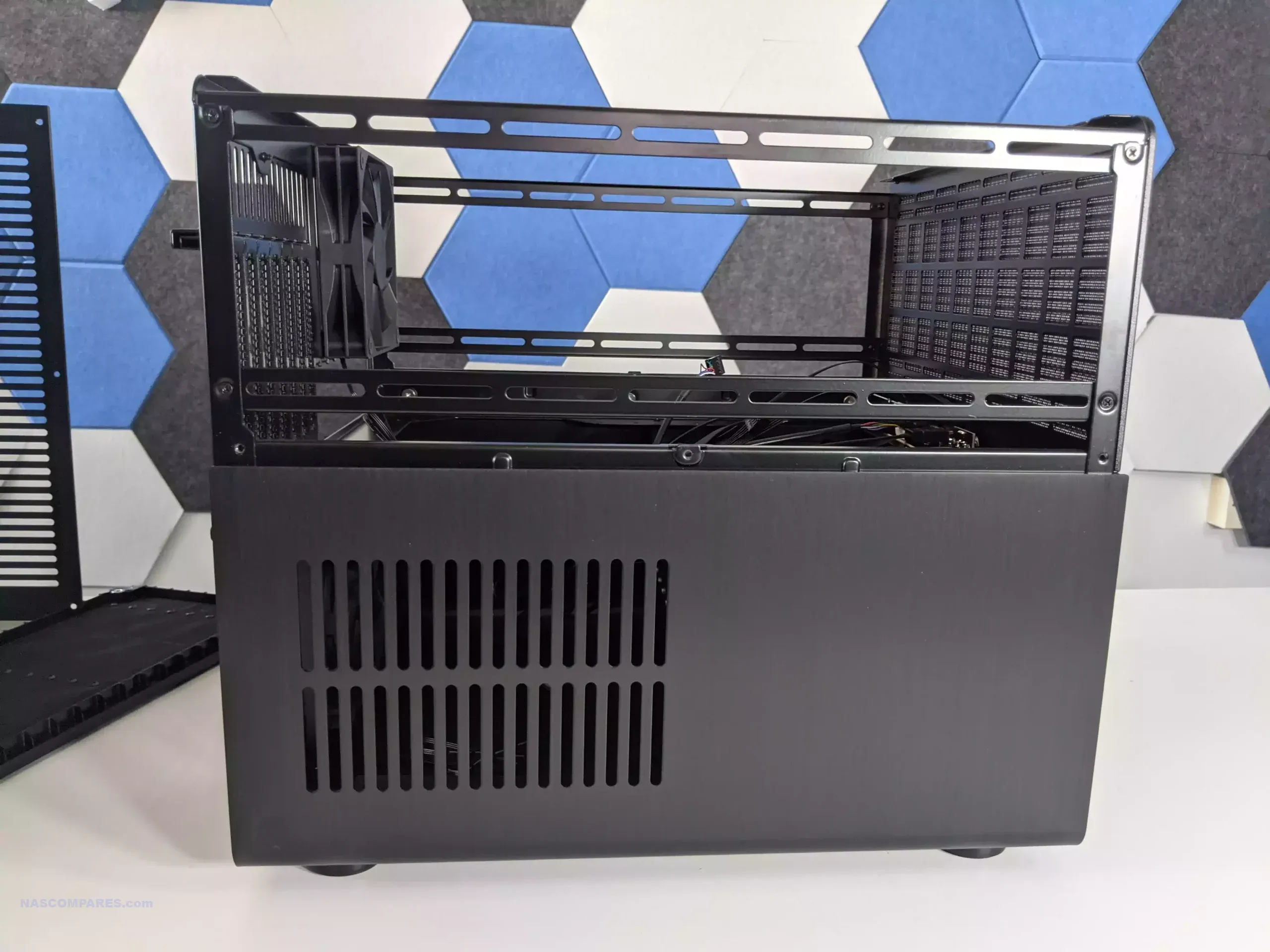
Unlike previous Jonsbo cases, which used SFX power supplies, the Jonsbo N5 supports larger-scale ATX internal PSUs. This is clearly reflective of the larger motherboard support that this system features, and although there is sufficient room to mount the PSU and use a similar PSU plate as previous Jonsbo cases, it does lead to a tight cluster space between the PSU and the horizontal 4-bay hard drive cage.
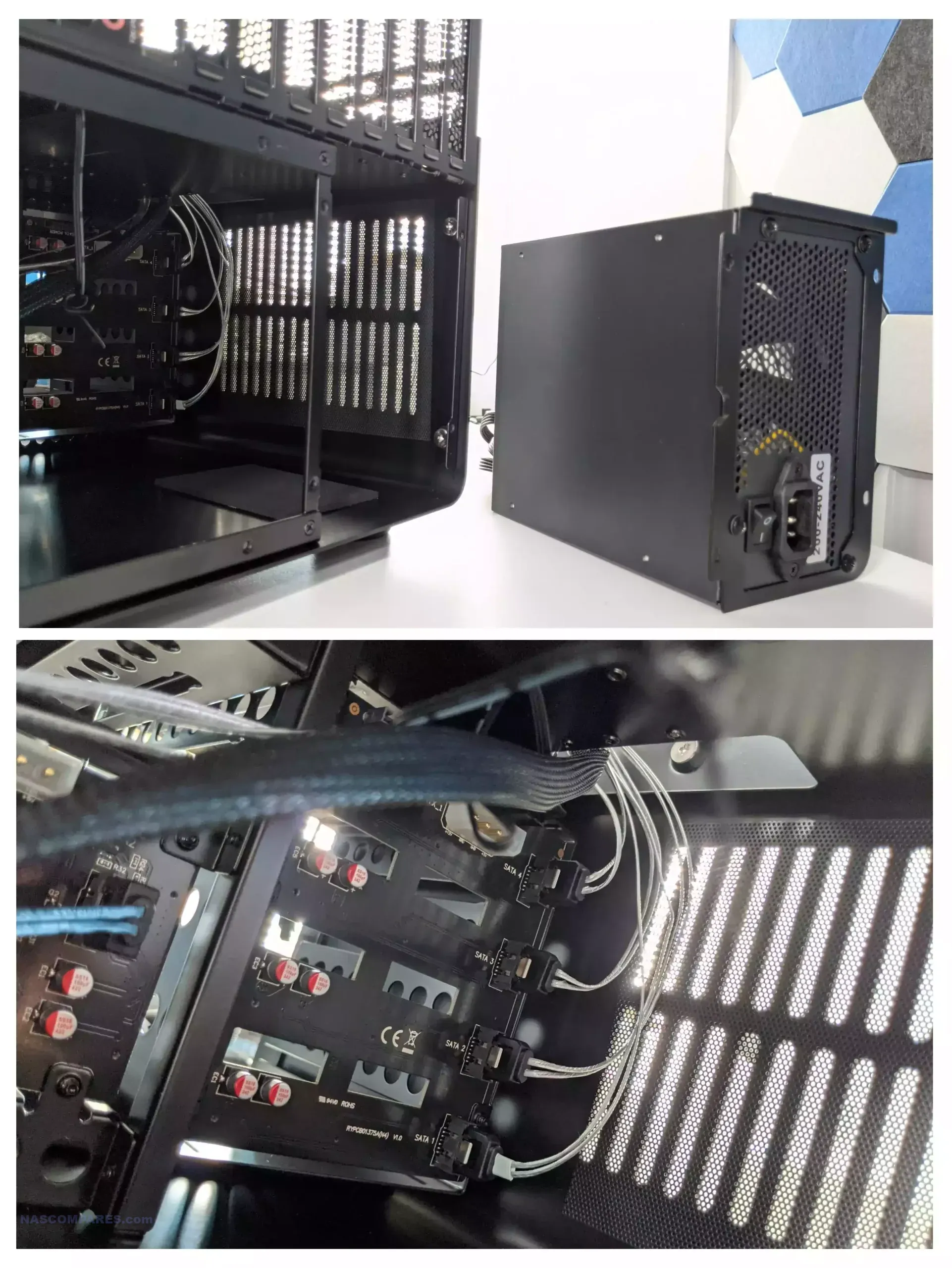
Why Jonsbo persists in utilizing the hexagonal Allen key screws to mount the top of the case, when every other screw inside the system uses a standard cross-head screw, kind of blows my mind. By six individual small screws, which, although easy to remove, still kind of beg the question—why you can’t have had normal flat-head cross screws instead for convenience.
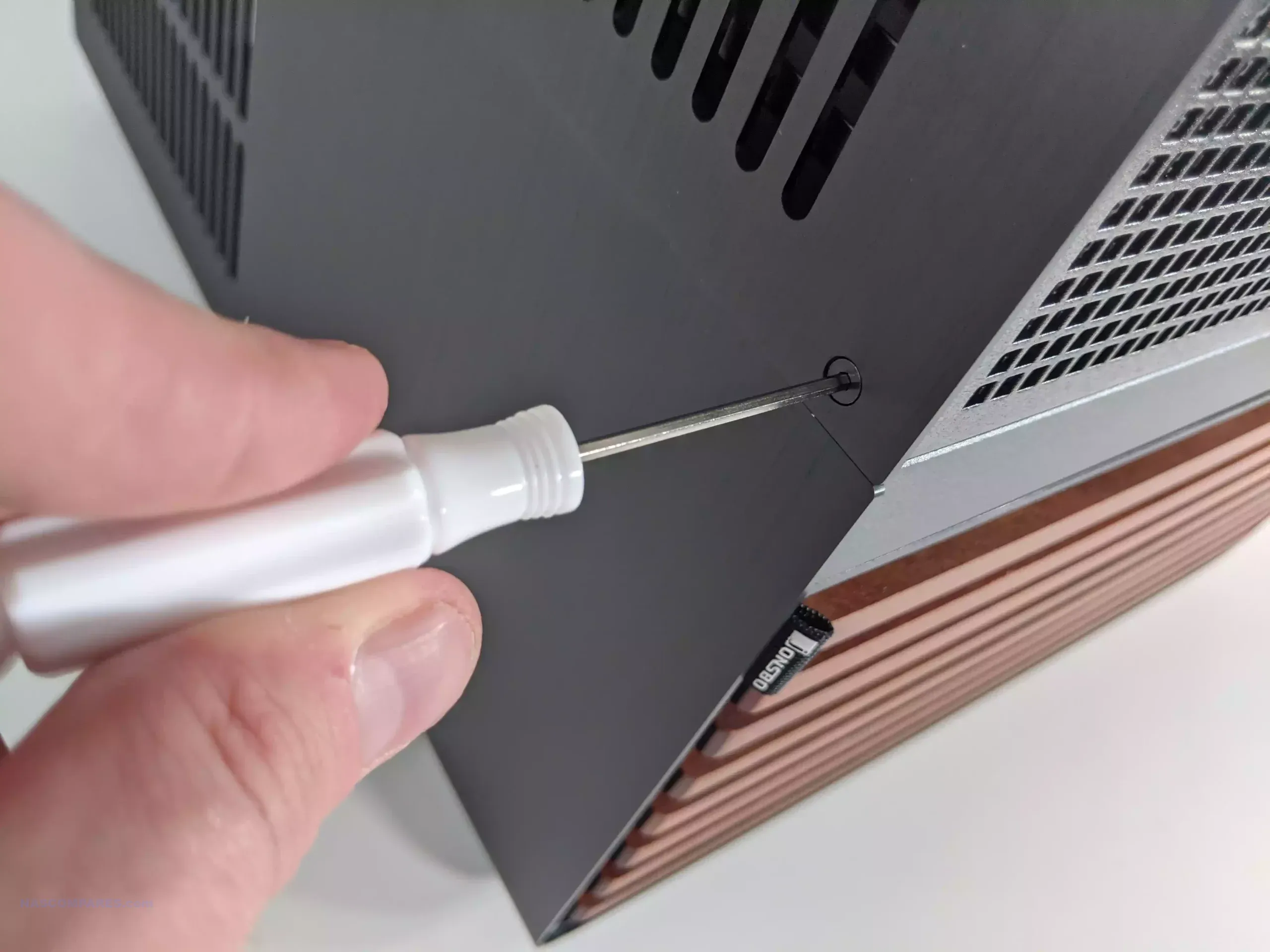
Overall, the external design of the N5, keeping in mind the massive scale of this system, largely repeats the design elements from my previous Jonsbo NAS case reviews (the horrible rubber band trays and the odd choice of screws). And although I’m a little confused by the LED and SATA PCB arrangement, overall, I’m really happy with the construction of the N5 externally. Let’s take a look at the inside and discuss what we find.
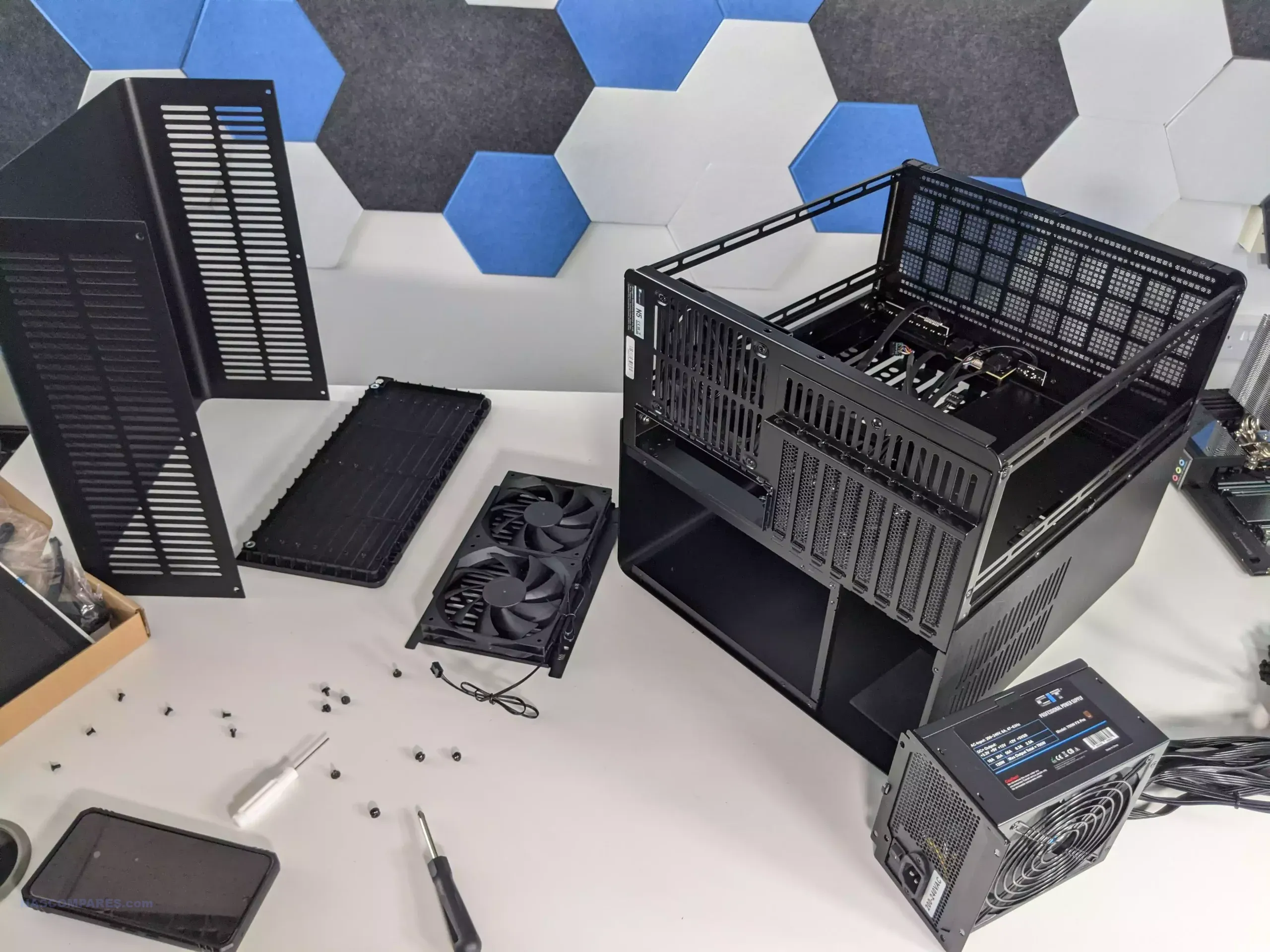
Jonsbo N5 Review – Internal Design
When Jonsbo launched the N4 NAS enclosure earlier this year, it seemed to be a NAS case that fell behind a lot of the scale-ups and improvements of the N3 before it. Jonsbo has clearly decided to rectify these things by maxing out practically every direction possible on the scalability of the N5. For a start, you can support up to eight whopping 160 mm CPU coolers inside the system. Given the 12 SATA storage media support and up to 8 PCIe cards, it makes sense that you’re going to use much more powerful CPUs, and therefore need a cooler best suited to capture all of that active airflow! I tested several large-scale CPU coolers, and even my 160 mm height CPU fan still had around 5-7mm clearance space.
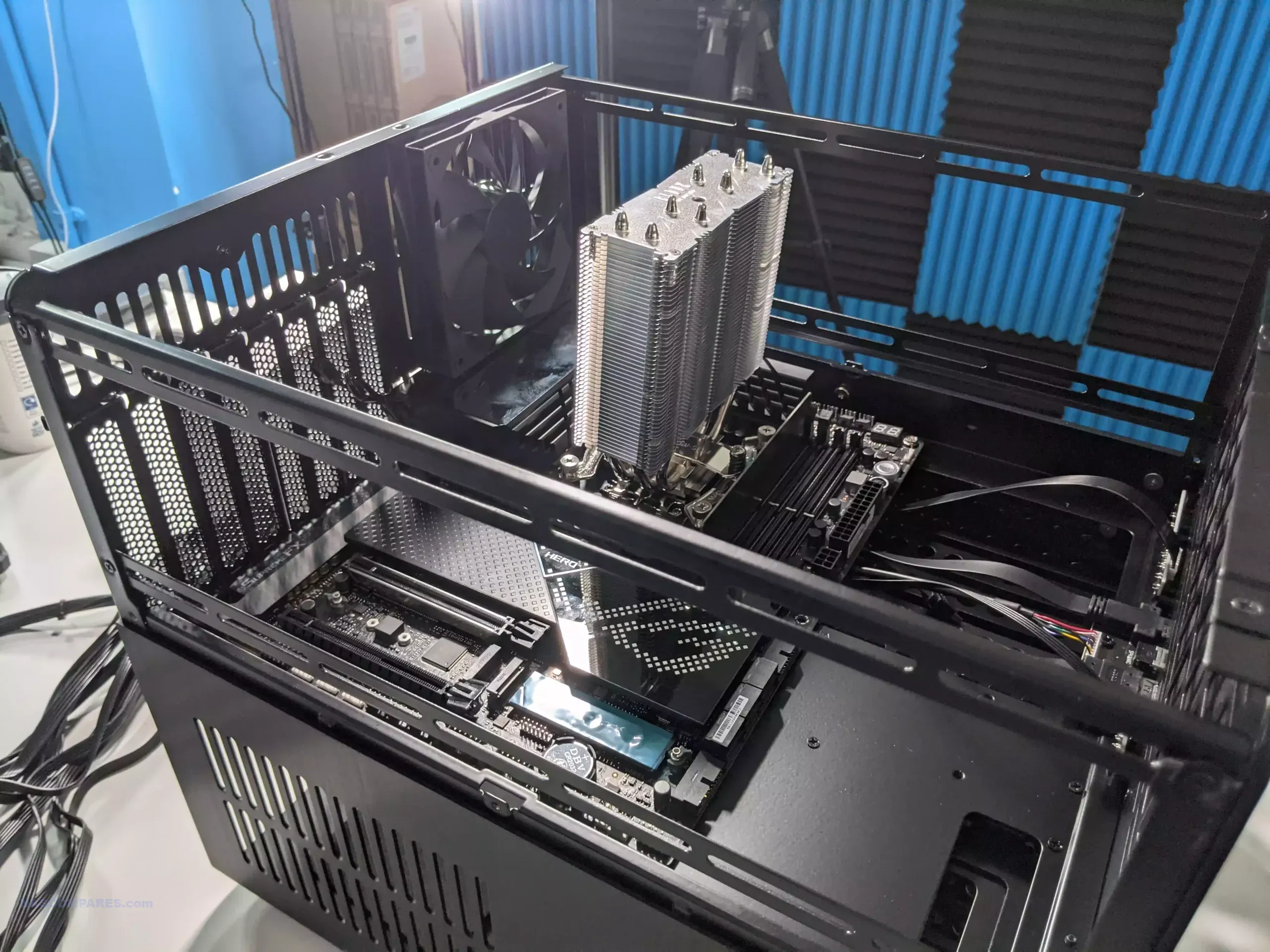
The space afforded to the motherboard installation on the Jonsbo N5 is absolutely huge. A few users online have already told me that they have opted to install an ITX motherboard inside this case, and although I am a massive ITX mobo fan (as there’ve been some fantastic NAS-optimized compact boards of late from Topton, CWWK, and Minisforum), when I did pop an ITX board in, it was kind of comical how little space it actually took up.
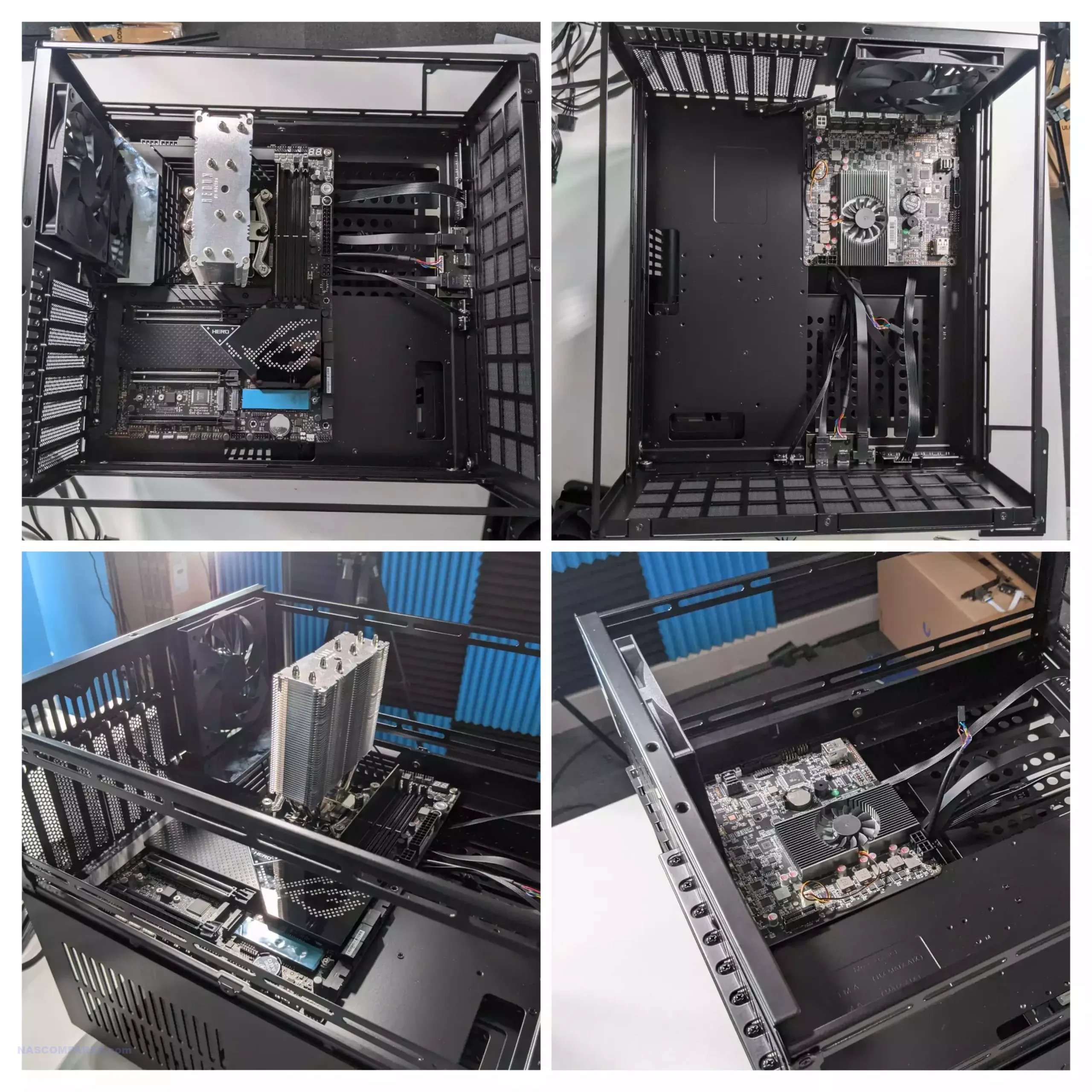
So for the build video I’m working on, I decided to cannibalize an existing ATX test machine that I’ve been using for about a year on Gen 5 SSDs. This board fit in snug as a bug in a rug, and there was still a ton of space where the main eight SATA storage space protrudes beyond the motherboard cavity. Unlike previous generation Jonsbo cases that nest the motherboard directly on top of the storage media bays, the N5 has got sufficient room that there is only a small amount of overlap and therefore restrictive airflow and potential heat generation to be concerned about.
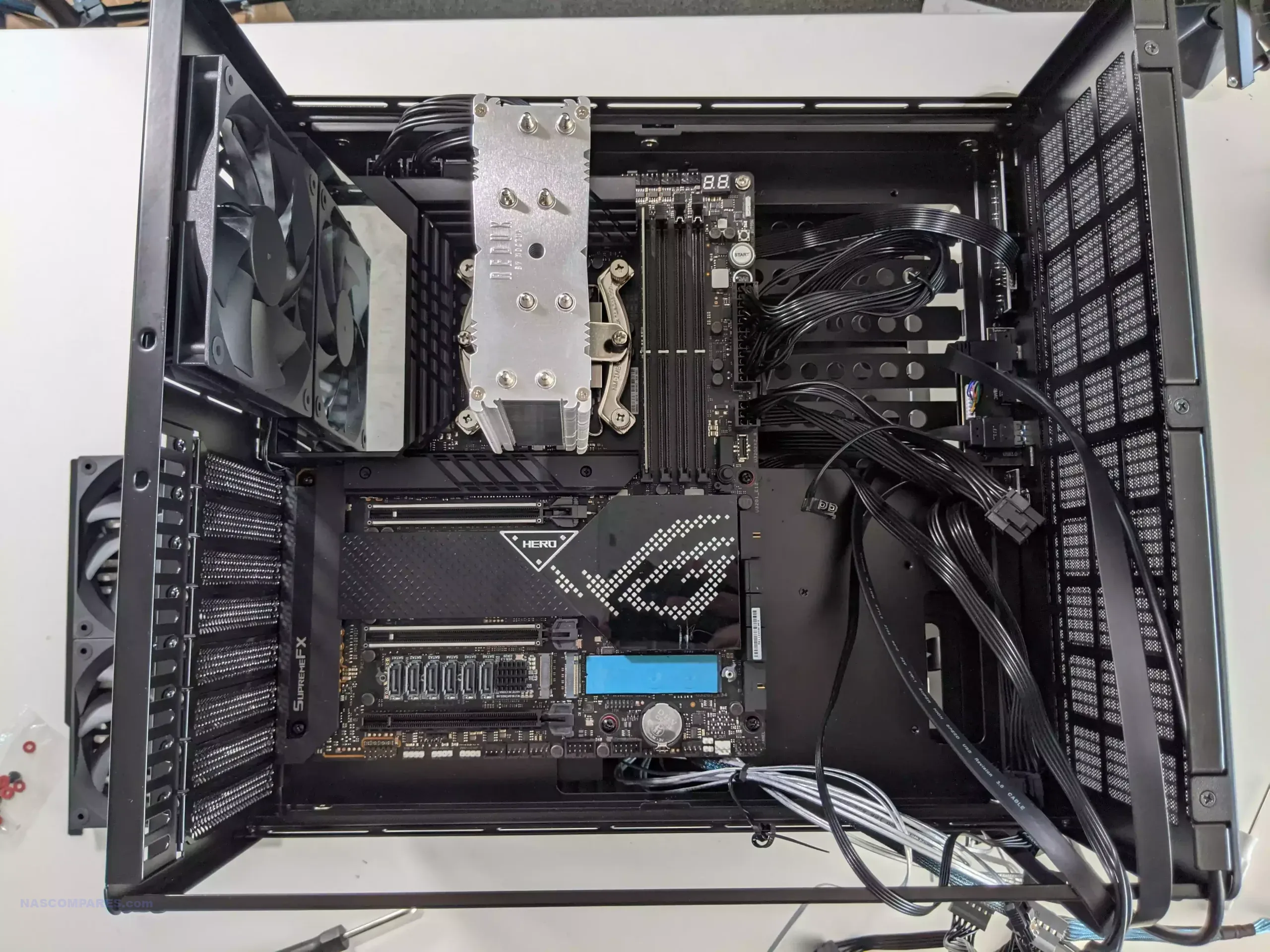
With eight individual PCIe slots on the rear, even if you use double-height cards on your motherboard, that still allows for four individual fat graphics cards if you want! On top of that, the system supports up to 350 mm length cards as well, at full height, so the scope for PCIe upgradability here is absolutely massive. Add to that the fact that even more modest motherboards with 1-2 PCIe slots will still be able to capitalize on the scope of this case, thanks to modern M.2 to PCIe adapters in the market.
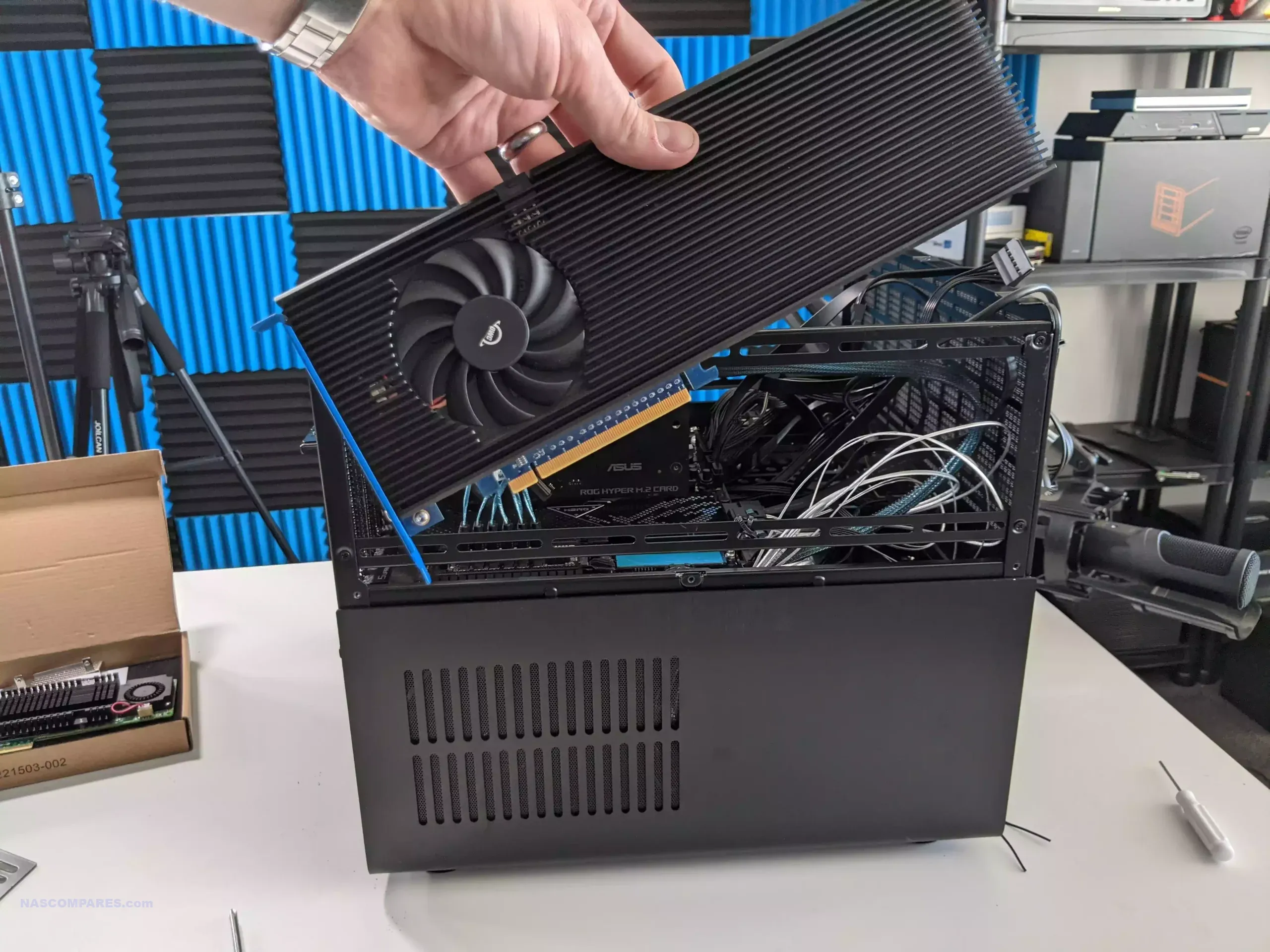
If you do mount 2.5-inch SATA SSDs inside the case via the mounting rails mentioned earlier, just be aware that this does overlap ever so slightly over the last PCIe slot. And although most likely this won’t pose an issue, as a double-height card will occupy the two last slots comfortably, just be aware that this may also block active airflow slightly.
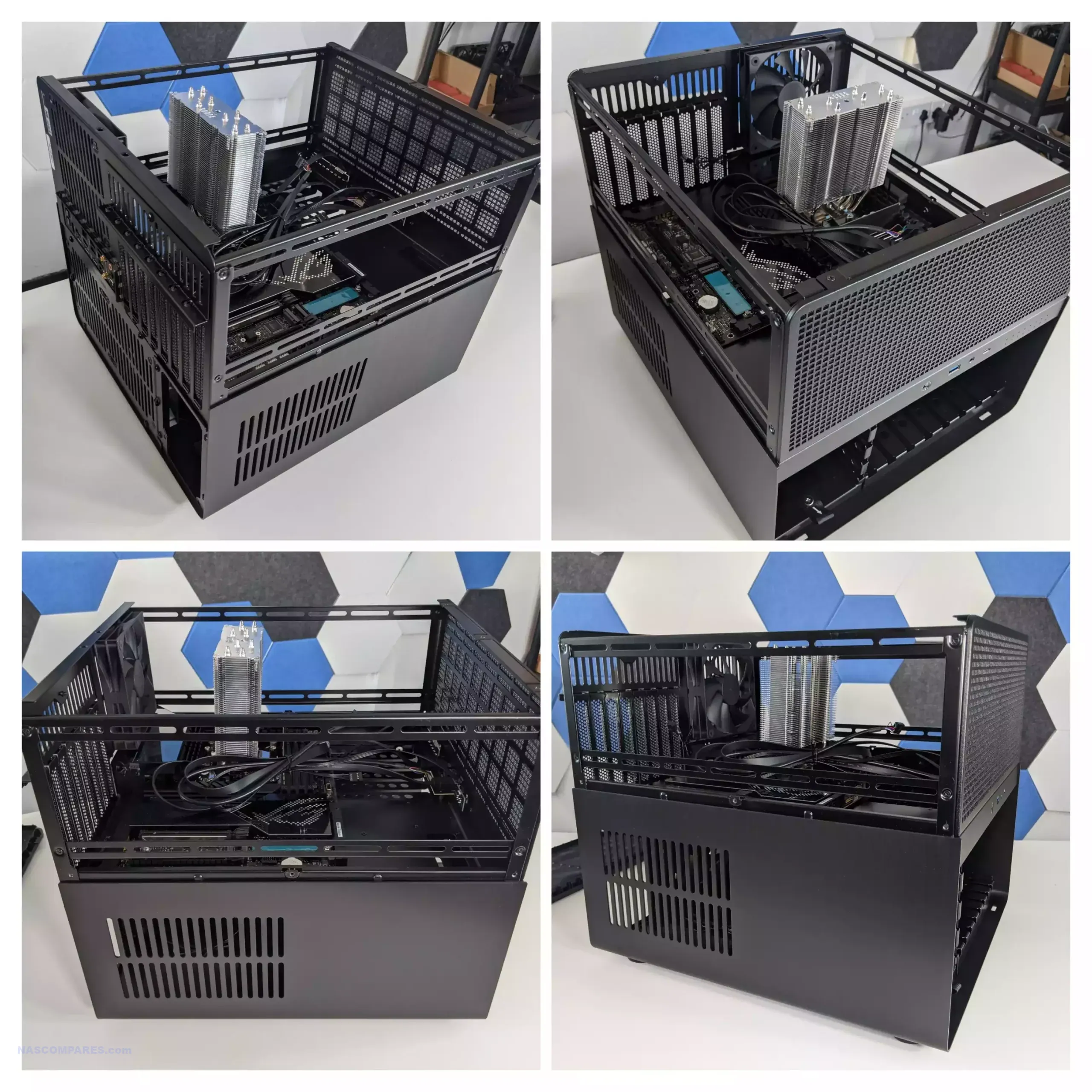
It’s an exceptionally spacious and clear cavity to install your motherboard here, with the same space that you would regularly see afforded to a professional gaming rig, but this time geared much more towards 24/7 storage. But what about if you’re building this NAS case? Are there any hurdles or hiccups you should be aware of?
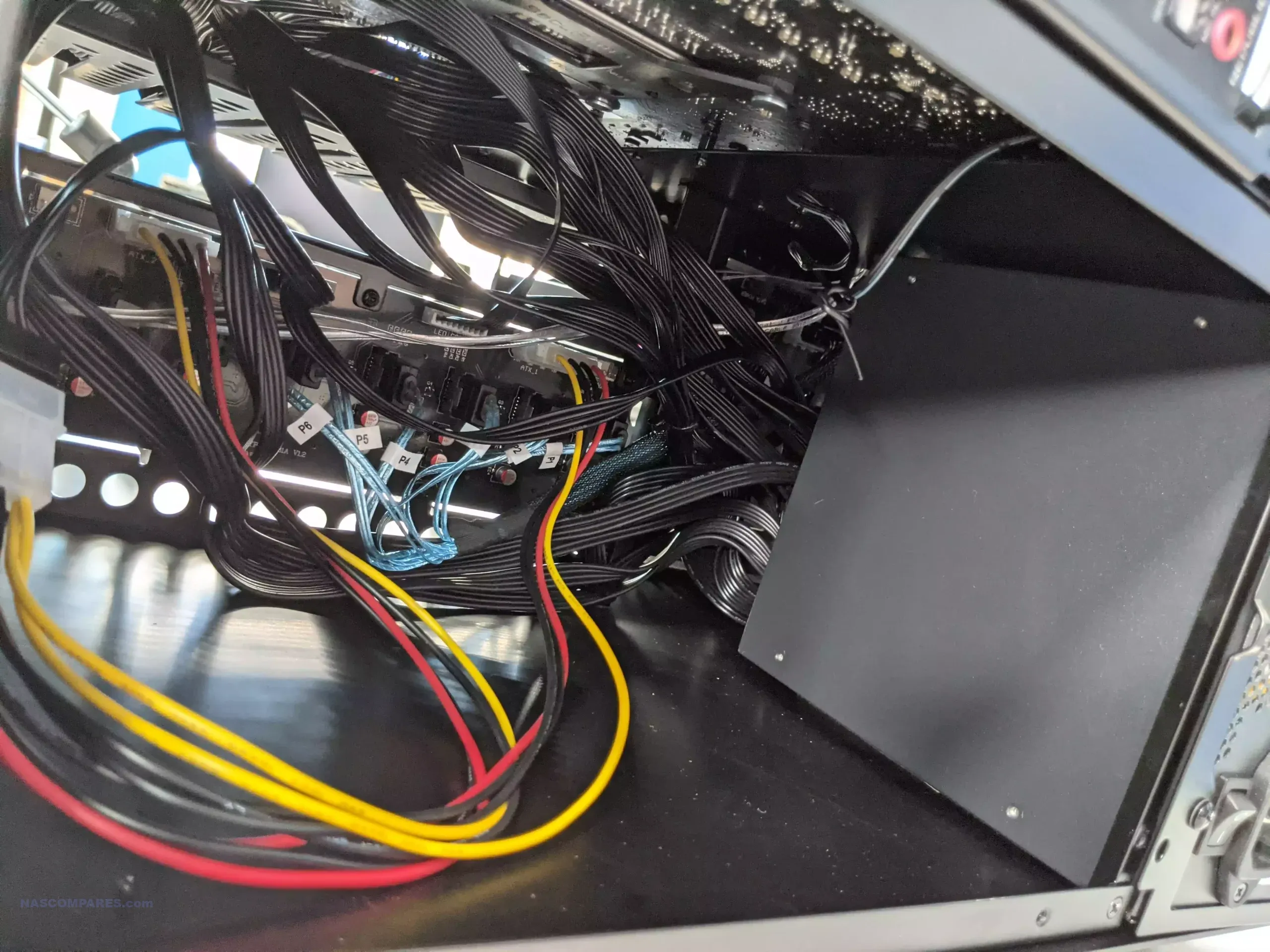
Jonsbo N5 Review – Building a NAS?
I’m currently working on a step-by-step build guide for the Jonsbo N5; however, in the meantime, until that is finished, here are a few early observations that I had when building a server using the N5.
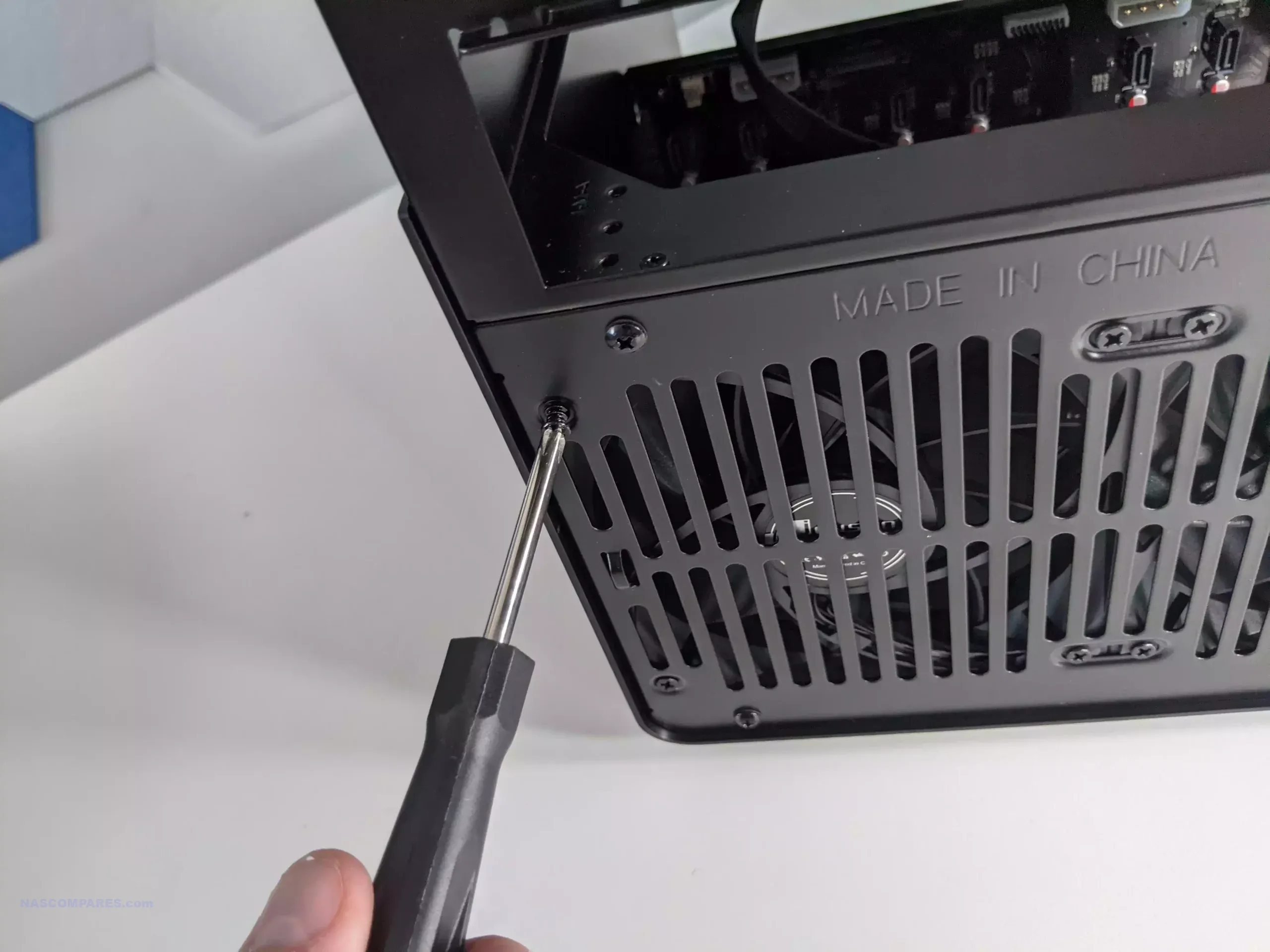
The area behind the hinged fan panel is surprisingly spacious, and in contrast to the tight-knit area behind the PSU, there is absolutely loads of space here to funnel your PSU SATA cables freely without fear of blocking the air inlet.
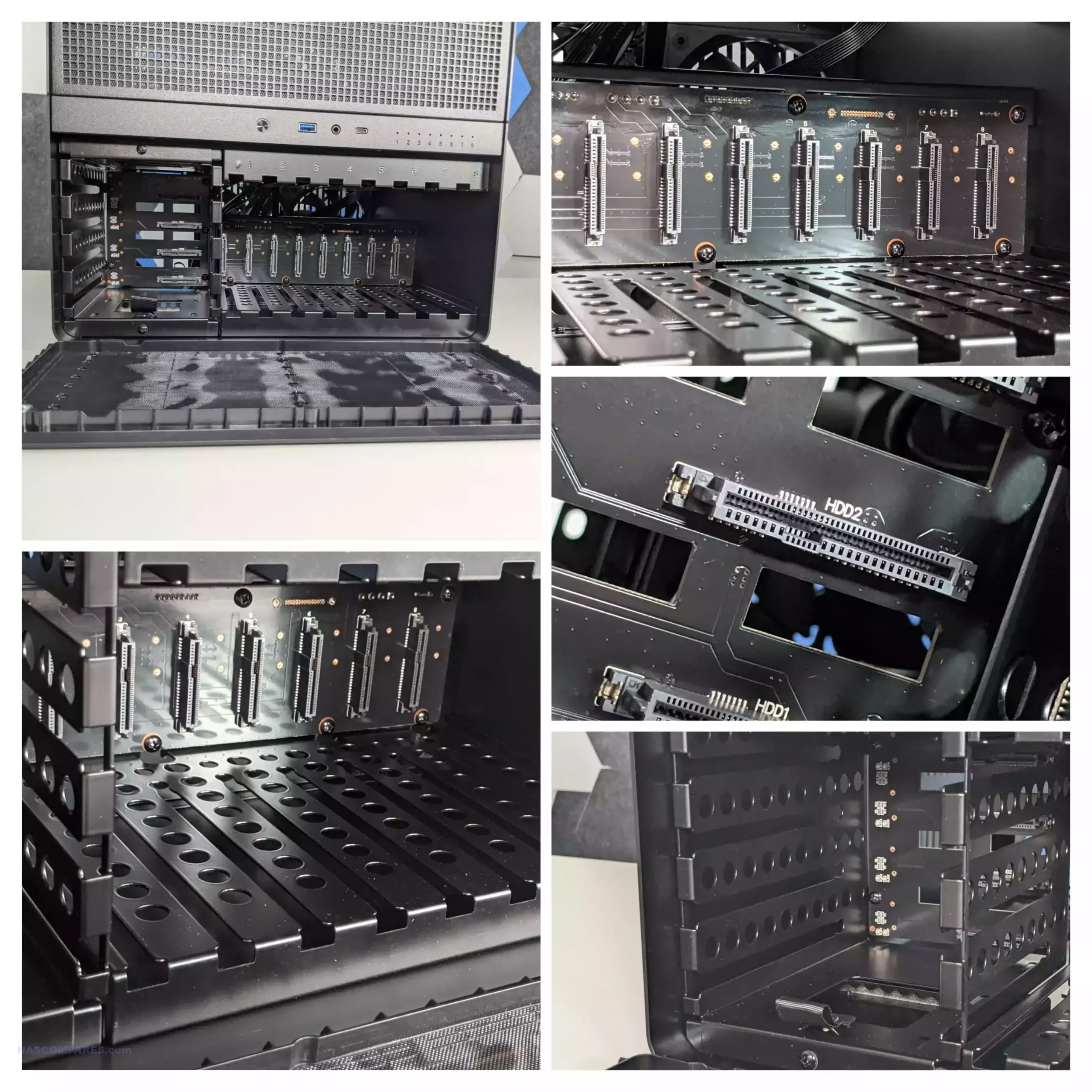
The area behind the 4-bay cage that is sandwiched behind the PSU is a different story, however, and I strongly recommend that you funnel all of your SATA cables long, long before you even consider playing with the PSU installation.
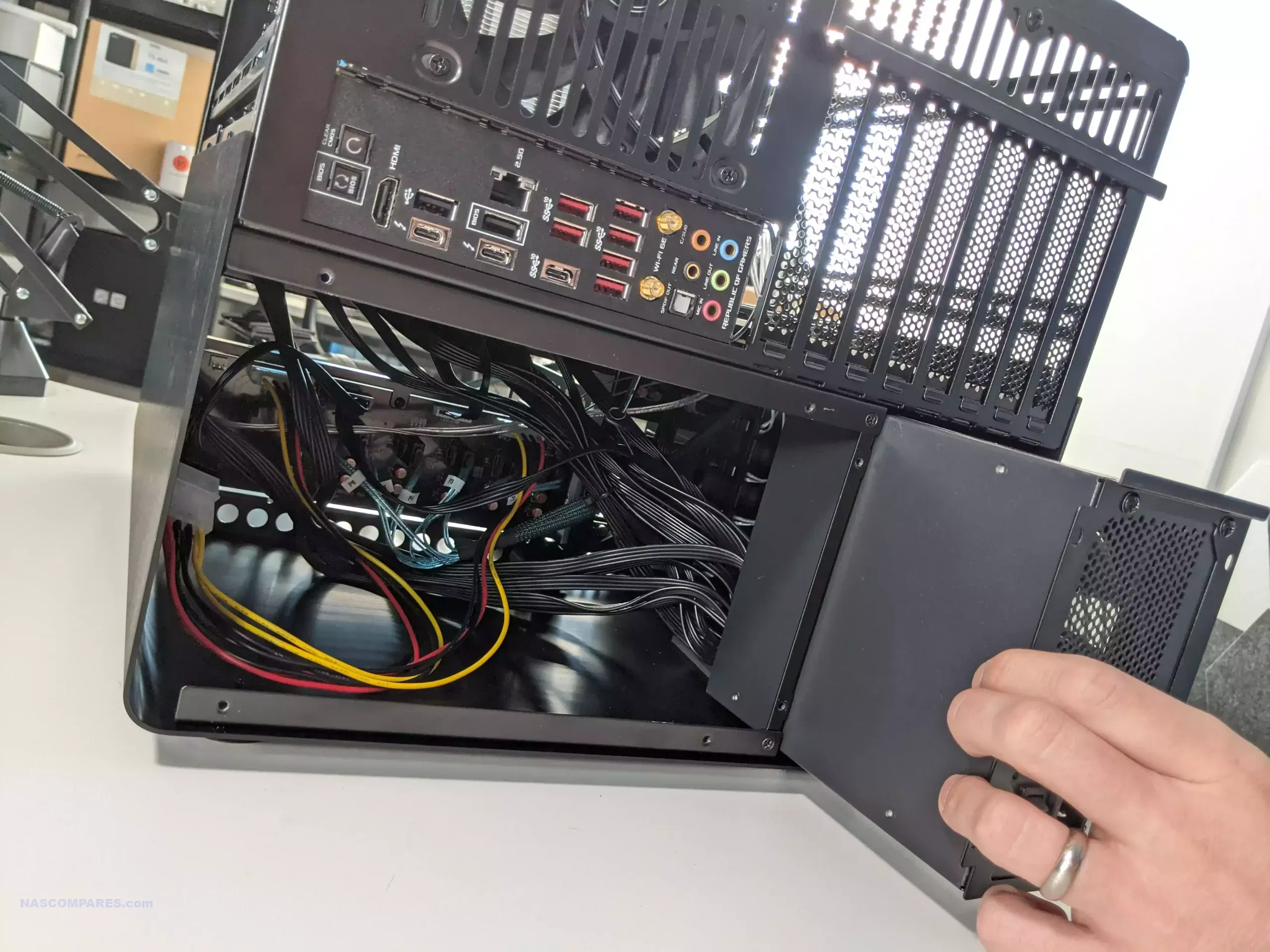
The PCBs inside the Jonsbo N5, as it separates the media across two PCB boards, require you to separate the power a little. The rear board features three individual Molex power female ports and two SATA power female ports. More than likely, you are going to need to use a Molex splitter on the majority of domestic PSUs in order to accommodate these connections.
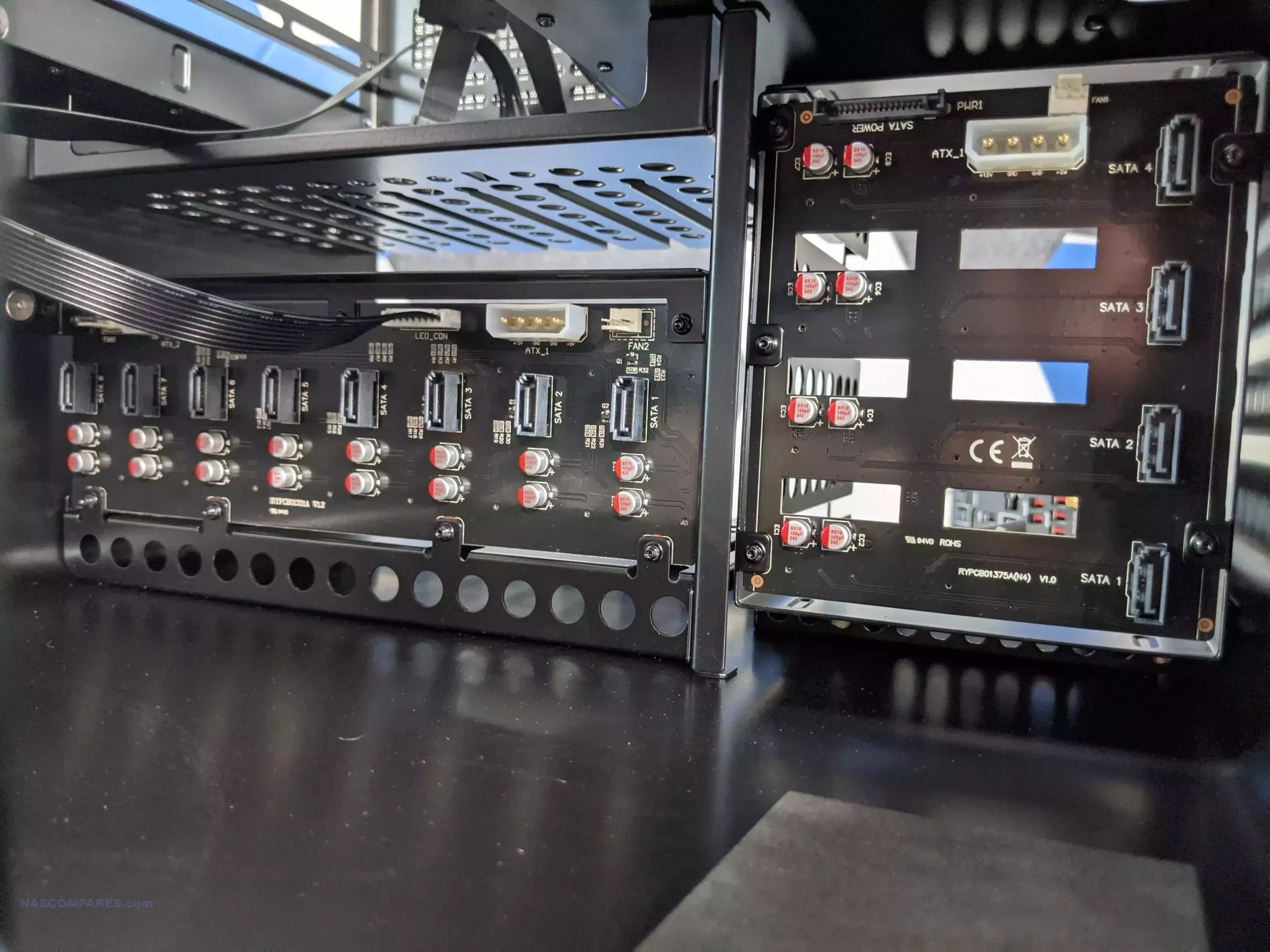
It is recommended that you use 60 cm SATA cables minimum when connecting all 12 bays of storage to the N5-installed motherboard. The four horizontal drives will easily cable in well to the small cavity hole for these cables in the case, but the eight individual SATA bays will need to effectively double up to reach the small SATA inlet hole featured in the N5, so perhaps even consider swapping slots 1234 with 90 cm SATA cables.
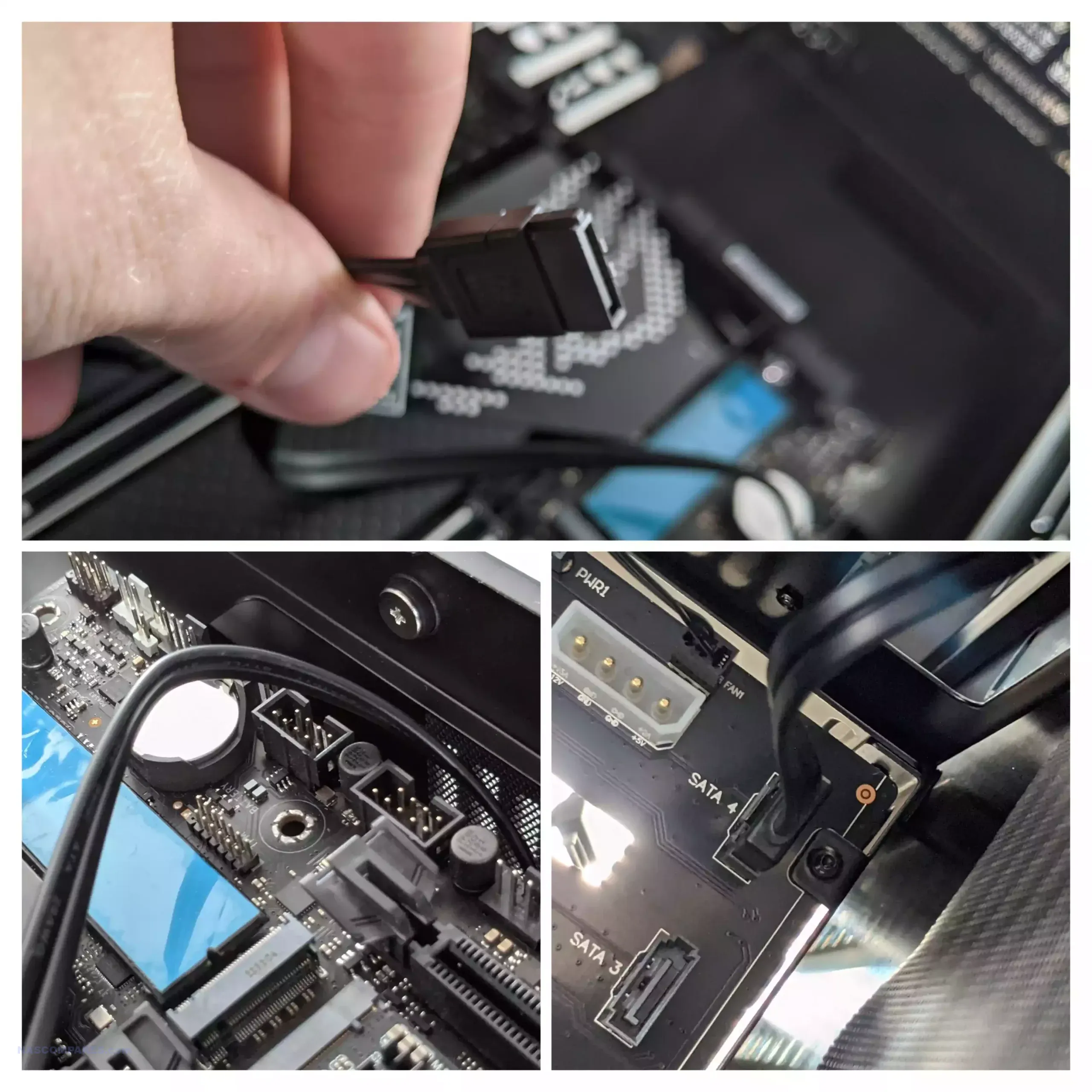
The main SATA 20-pin connector and a couple of 6/8-pin power connectors can be funneled via the cavity above the 8x hard drive storage bay. These can be tracked via the small envelope space above the eight-slot SATA PCB.
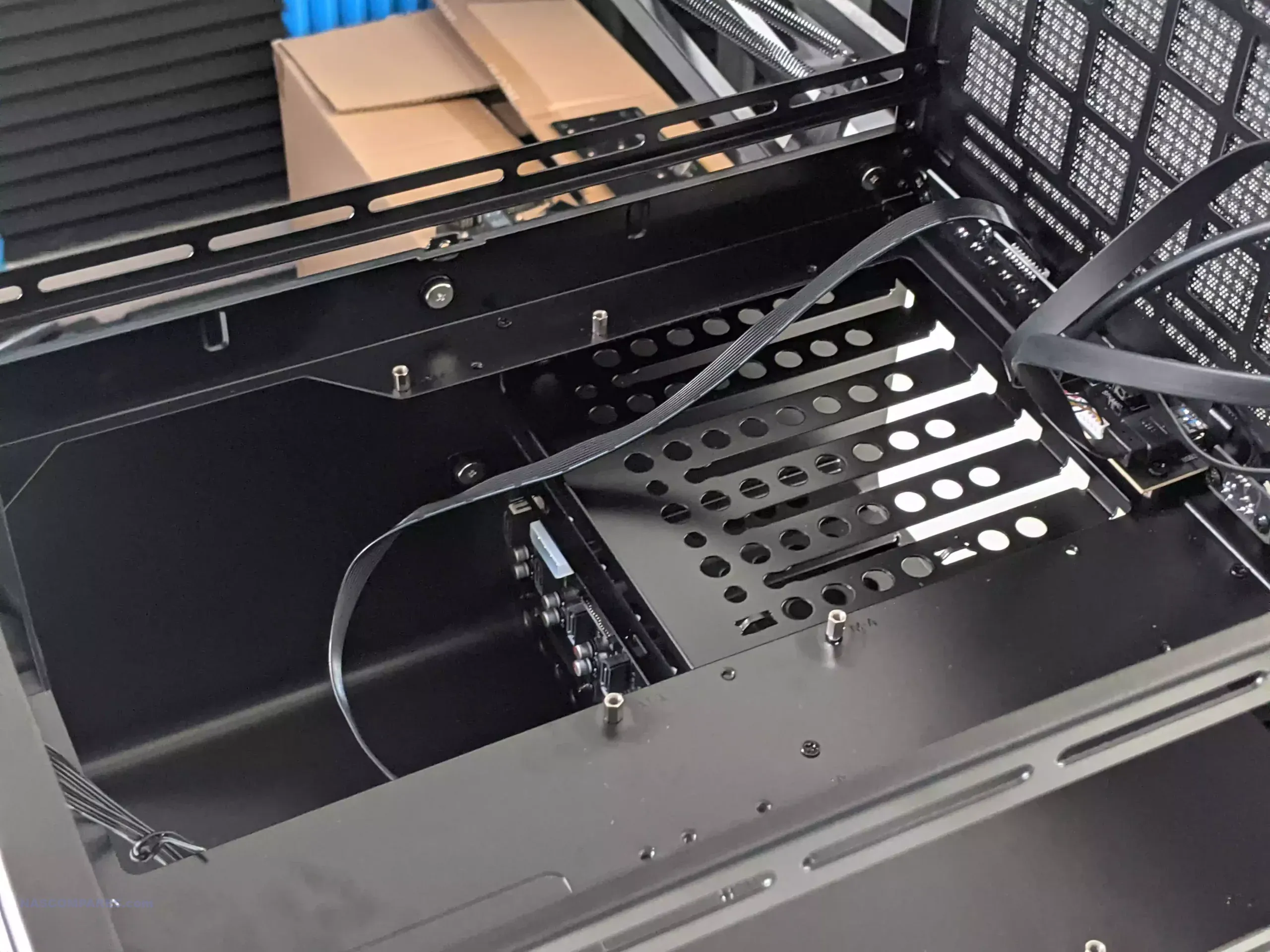
However, there is an additional small cable inlet located next to the motherboard backplane area that you can use to funnel additional 4/6/8-pin power inputs for your motherboard at that corner if needed.
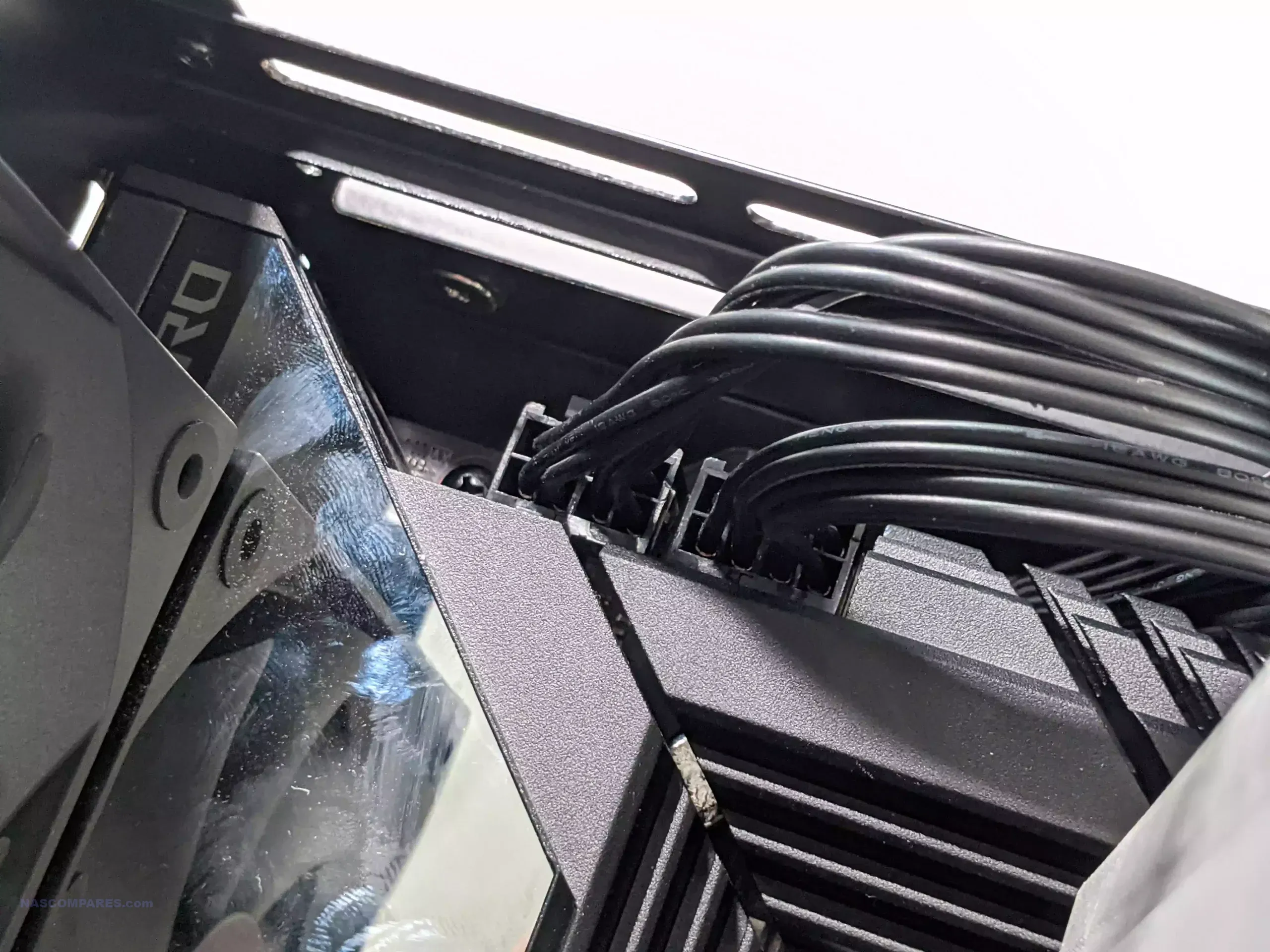
Everything else about building this case was pretty straightforward, just be aware that you really need to focus on funneling the SATA cables first, then routing each of the PSU cables into their relevant internal case cavity before sliding the PSU and its plate into place. As it is near impossible to do this afterwards and will result in having to dismantle almost the entire arrangement after. Let’s discuss some recommended upgrades and build options.
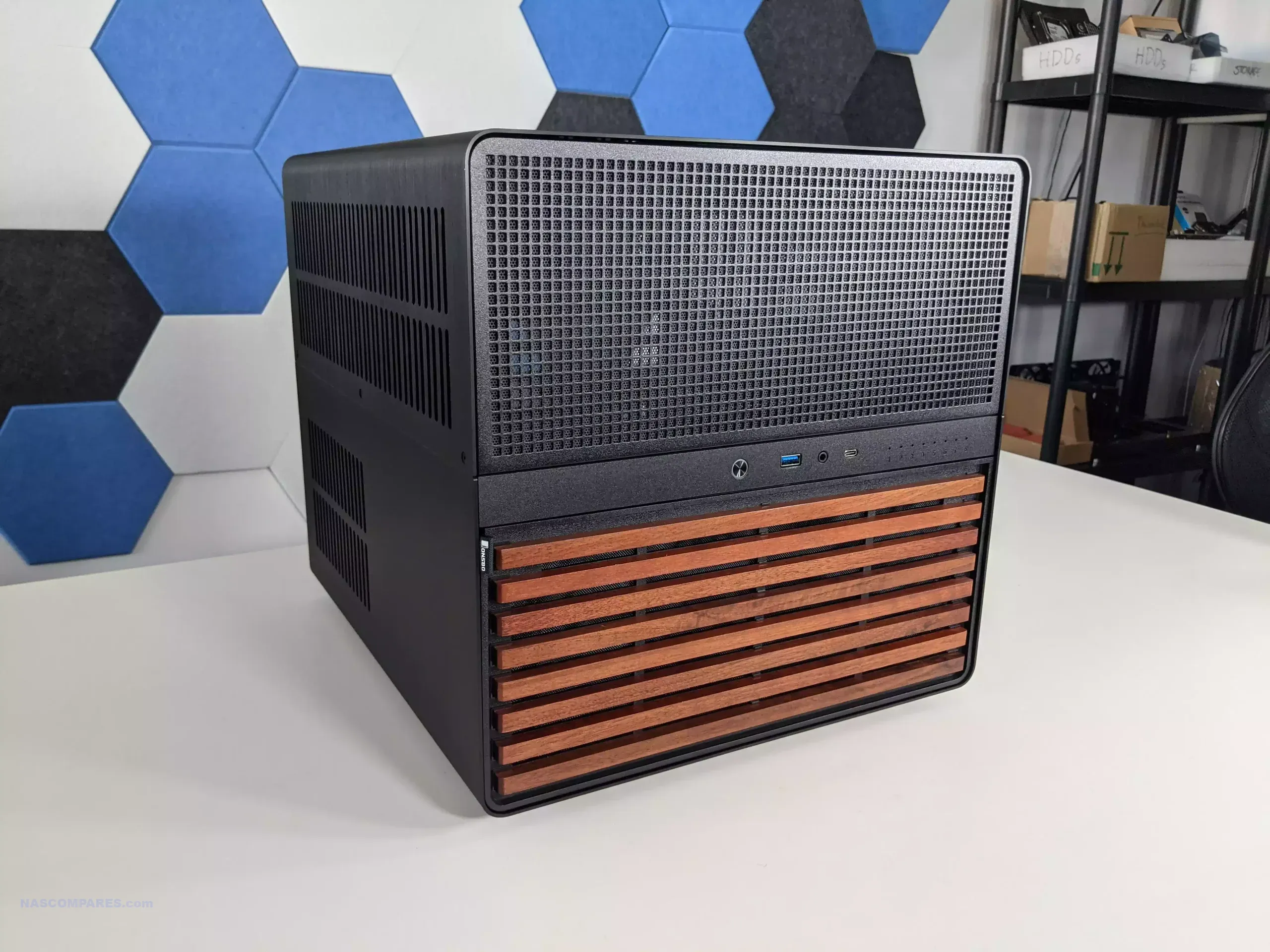
Recommended Upgrades and Adapters for your Jonsbo N5 Build
Here are a bunch of upgrades that will allow you to scale up just what you can do with your Jonsbo N5 NAS case build. Many of these are soft mods or adapters that allow you to scale up even smaller class systems into something more aggressive.
If you have run out of PCIe slots on your motherboard but still want to add 10 GB Ethernet, don’t fear, as you can get hold of the IO Crest M.2 to 10GBE network adapter that even arrives with its own PCIe backplate that you can slot into one of the available cavities of the N5, and is attached with a loose ribbon to an M.2-mounted controller.
Buy the IOCREST M.2 to 10GbE Adapter HERE for $79 at Aliexpress
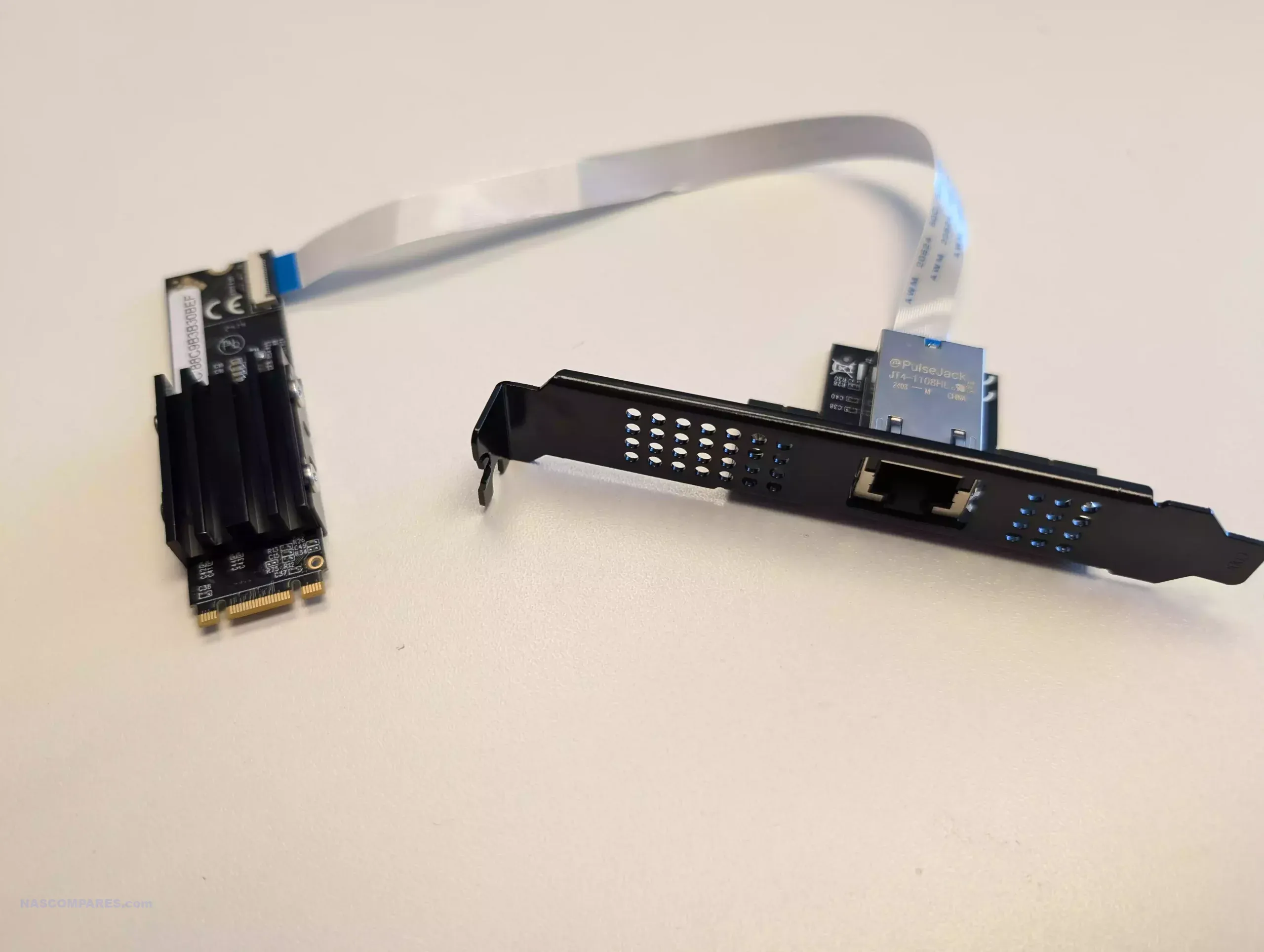
If you are thinking of being a little bit more broad in what you want to do with your PCIe slots beyond 10GB network upgrades, then you can get an M.2 to PCIe upgrade riser. You can even get hold of a Gen 4 x 4 M.2-supported model pretty affordably now that will allow you to attach up to a full x16 length PCIe card, but keep in mind that the M.2 adapter is limited to x4 speed (Gen 4 x 4 is approx 8 GB per second bandwidth).
Buy the ADT-LINK Gen 4×4 M.2 to PCIe Slot Adapter HERE for $26 at Aliexpress
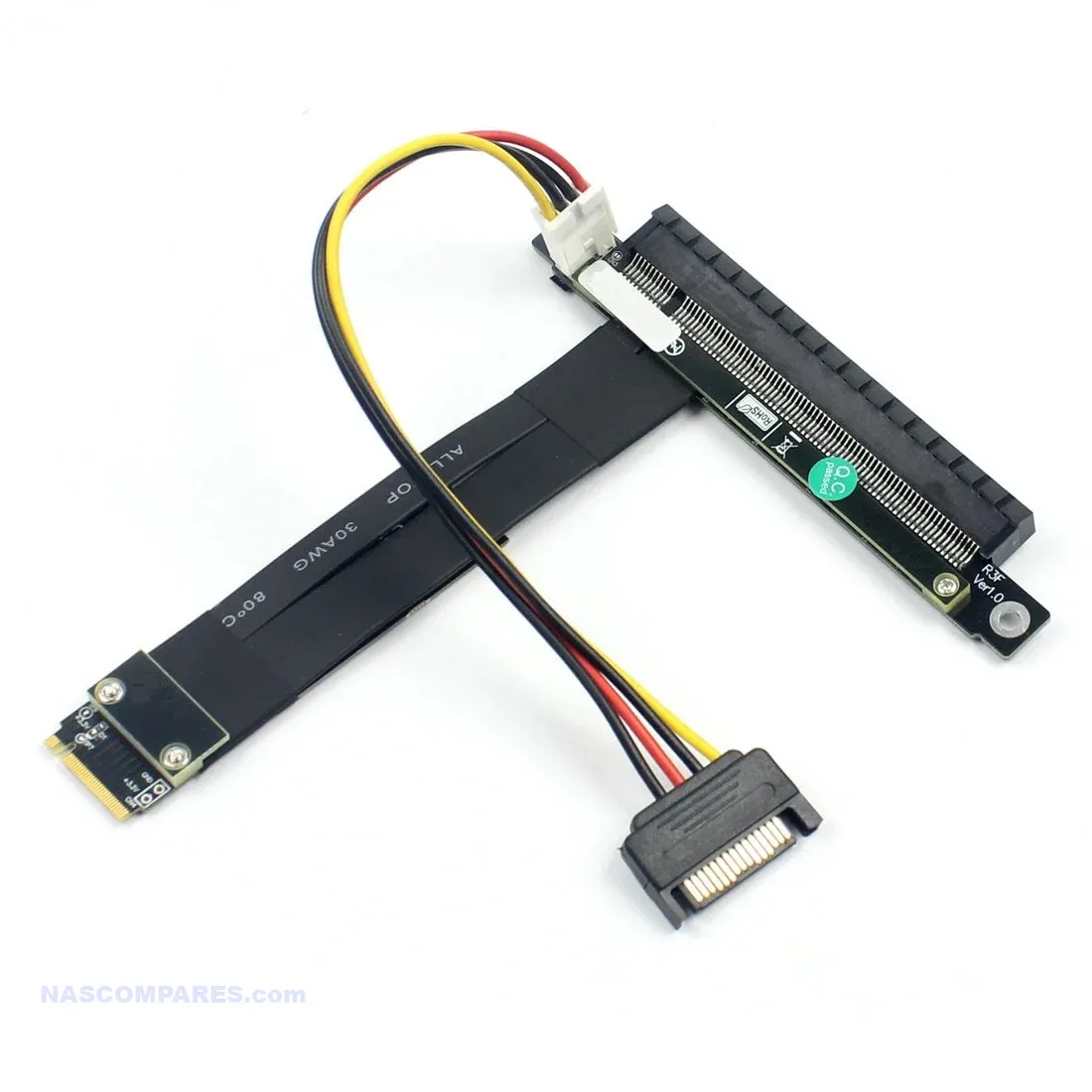
If you want to add further fans to the Jonsbo NAS via those hanging rails, or modify the existing 120 mm Jonsbo fans, low-noise fans from Noctua can be used on the Jonsbo N5 as replacements or upgrades.
Buy the Noctua NF-P12 Silent 120mm Fan HERE for $25.98 at Aliexpress or $21.95 on Amazon HERE
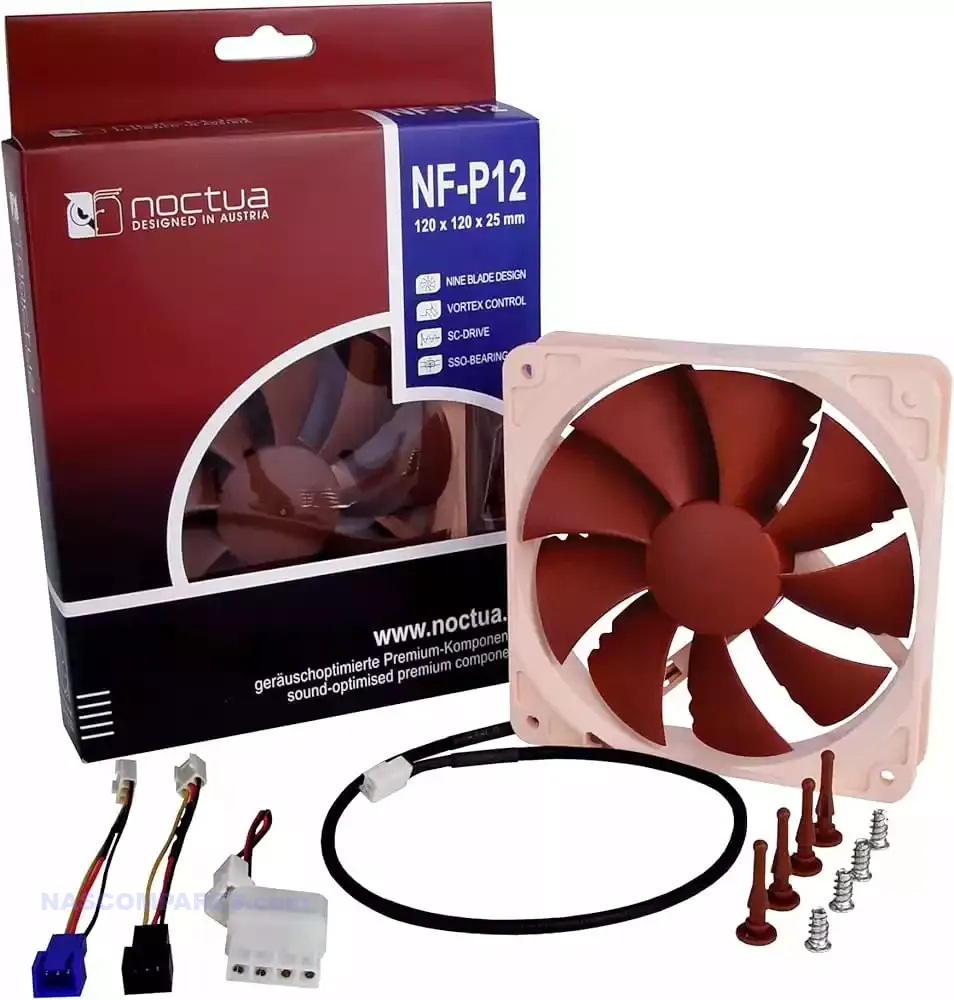
Even if you opt for an ATX motherboard, you’d be surprised how many motherboards do not arrive with 12 individual SATA inputs for your storage media. Of course, there are workarounds on some motherboards, such as PCIe SATA upgrade cards, or some more modern motherboards featuring HD Mini-SAS fan-out ports that allow for multi-SATA interfaces to be connected on a smaller surface area. However, one of the cleanest and easiest upgrades I found to attach six additional SATA drives is utilizing an M.2 to SATA upgrade card. These are dirt cheap and have the added benefit that they can be tidily installed on the M.2 PCB in advance before installing onto the motherboard. You are potentially sacrificing a useful M.2 in favor of SATA connections, but we are starting to see more and more multi-M.2 slot motherboards in the market, so this is less of a concerning sacrifice as time goes on.
Buy the M.2 to 6x SATA Adapter HERE for $17.19 at Aliexpress or $32 on Amazon HERE
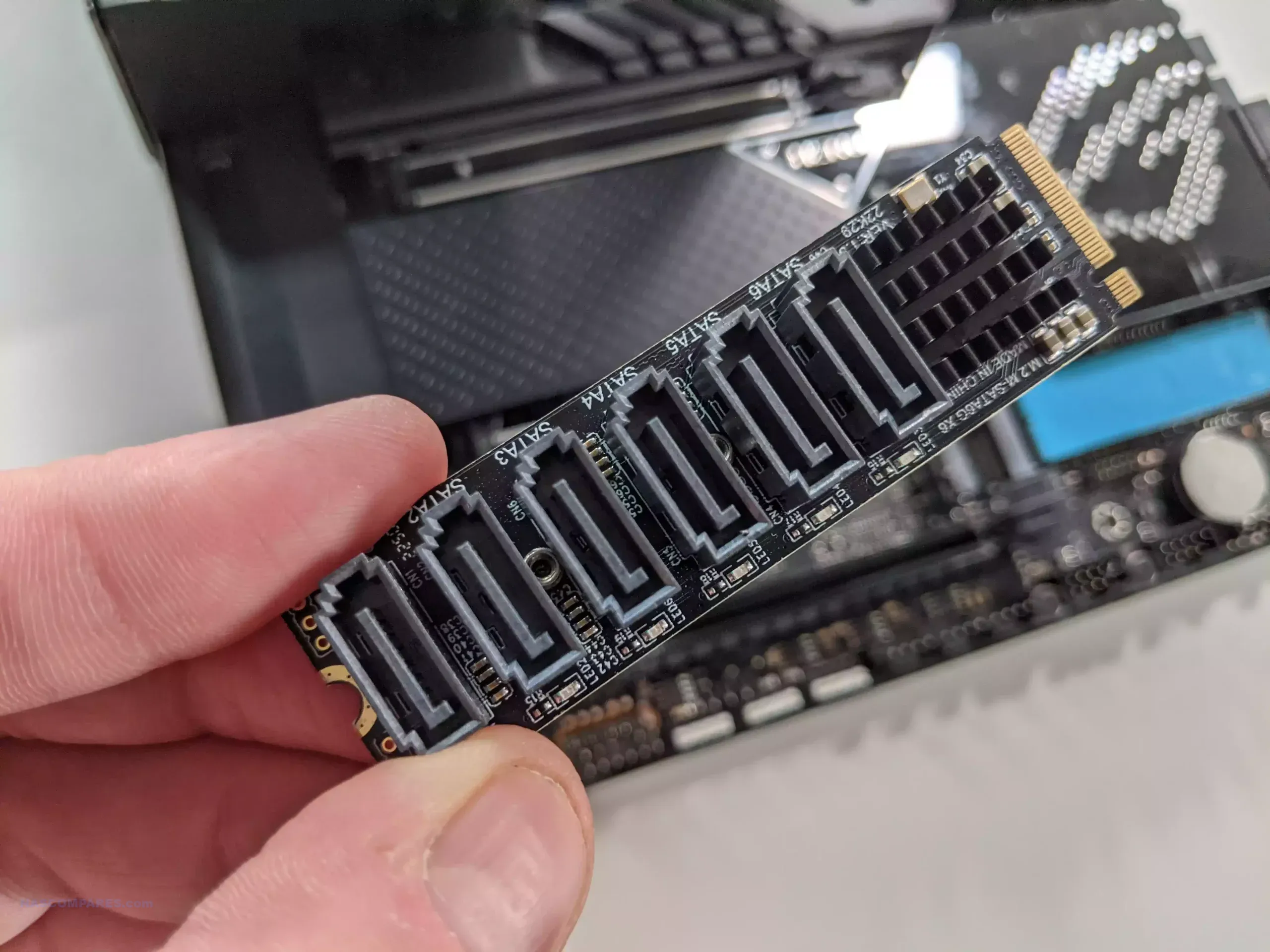
As mentioned previously in the article, motherboards available in the world of NAS. Even though the Jonsbo N5 supports a much larger ATX motherboard, the small scale and lower power consumption afforded to a number of NAS-optimized MITX motherboards can’t really be ignored. ITX boards are great for NAS.
Topton 8 Core Intel i3 N305 Motherboard, 6x SATA, 2x NVMe, 4x 2.5GbE – $279 HERE
Review HERE on YouTube and HERE on NASCompares
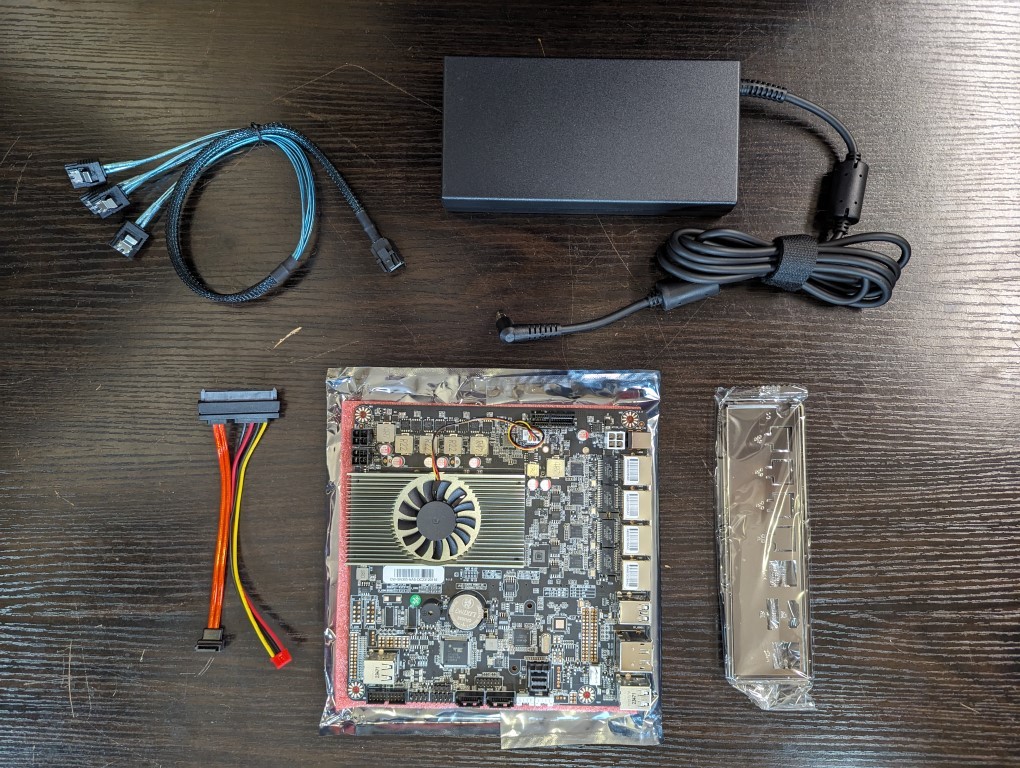
CWWK Demon Gen5 Board Intel 12/13/14 generation CPU |3x M.2 NVMe|8x SATA3.0|2x Intel 2.5G network ports – $279 HERE
Review HERE on YouTube and HERE on NASCompares
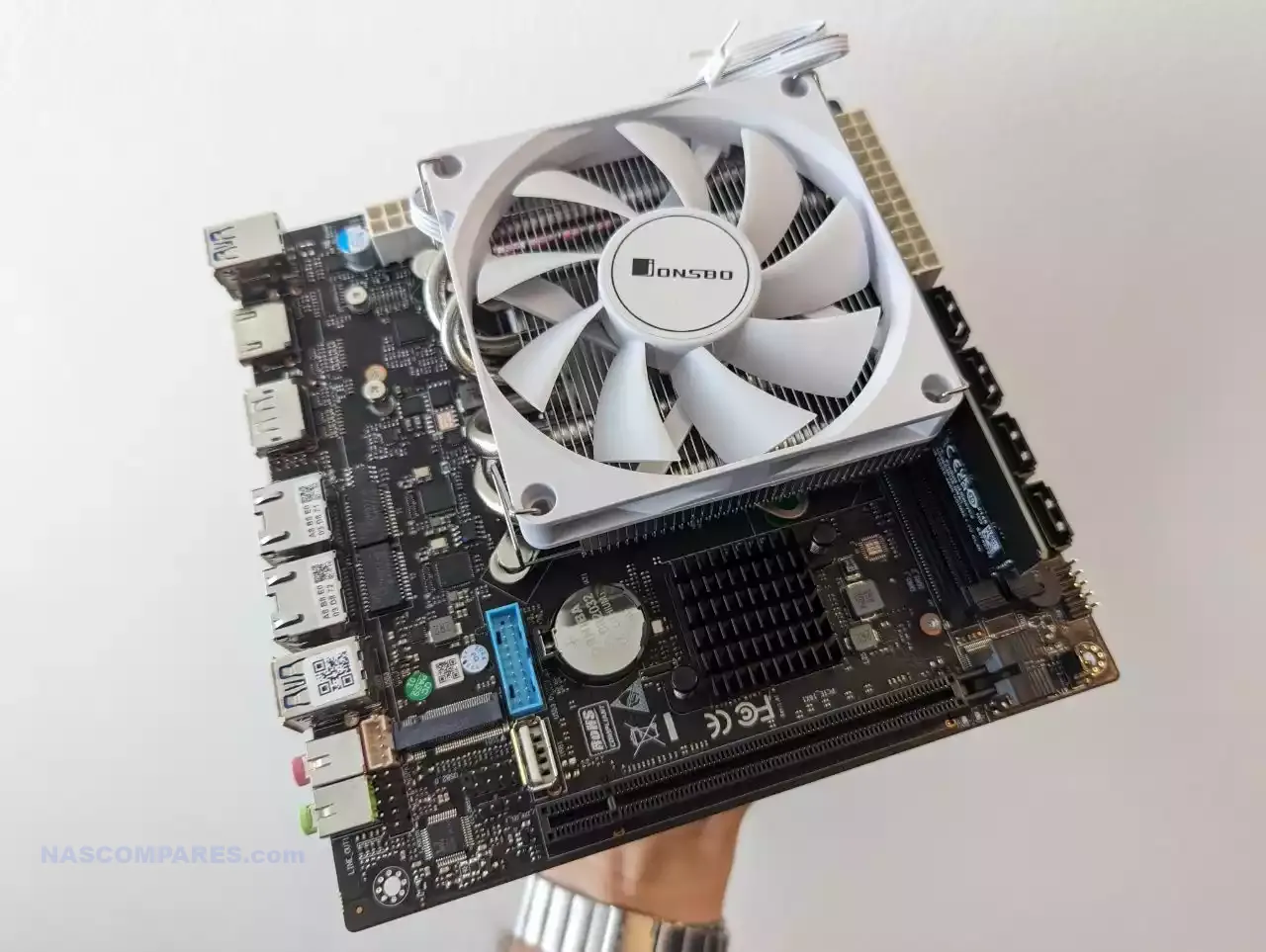
To make the funneling of the SATA cabling easier, I strongly recommend that you use pre-bound SATA cable lengths like these. These $10-12 6x SATA 50-100 cm Pre-Netted cables allowed me to attach (with 2 of them) all 12 bays of storage easily and neatly without too much loose cabling in between. Additionally, each SATA connector is numbered at either end to ensure you can connect drives appropriately and not have any confusion down the road in the event of a drive failure.
Buy the SATA x8 Cable HERE for $9.29 on Aliexpress
and x6 HERE on Amazon for $13.98
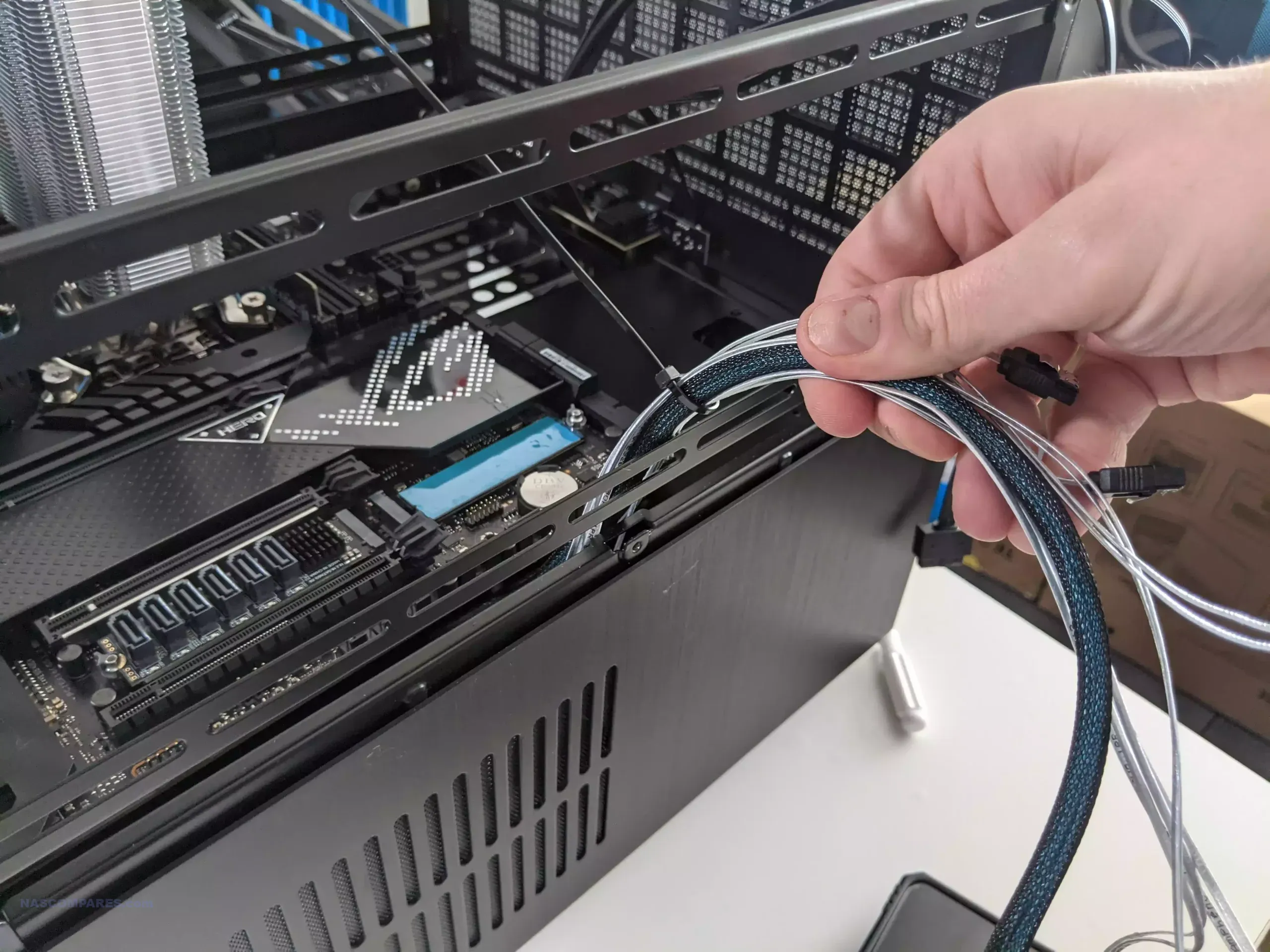
As mentioned earlier on, you may be using a PSU that does not quite have enough power input to support the rather complex storage configuration. It is recommended that you check that you have enough SATA and Molex available. If not, I recommend getting hold of Molex and/or SATA splitter cables like the ones below.
Buy the Molex Splitter HERE for $1.20 on Aliexpress
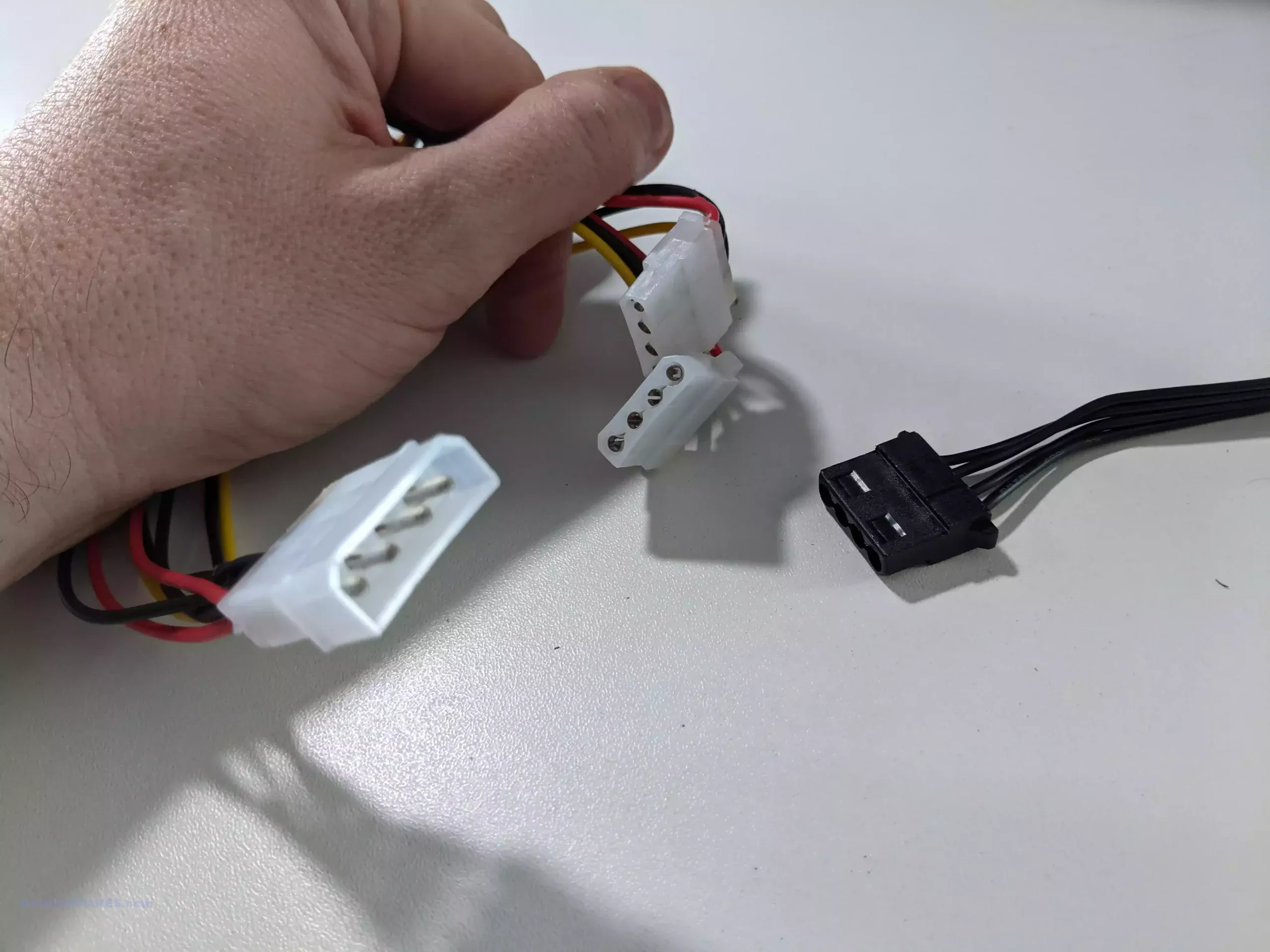
And that’s really it. The only last thing I would add is that if you are going to fully populate this NAS with hard drives, be aware that hard drives above 8/10 TB have a tendency to make more ambient operational noise and vibration, which will be multiplied significantly via this case. So just be aware that larger storage may well lead to a louder system in general.
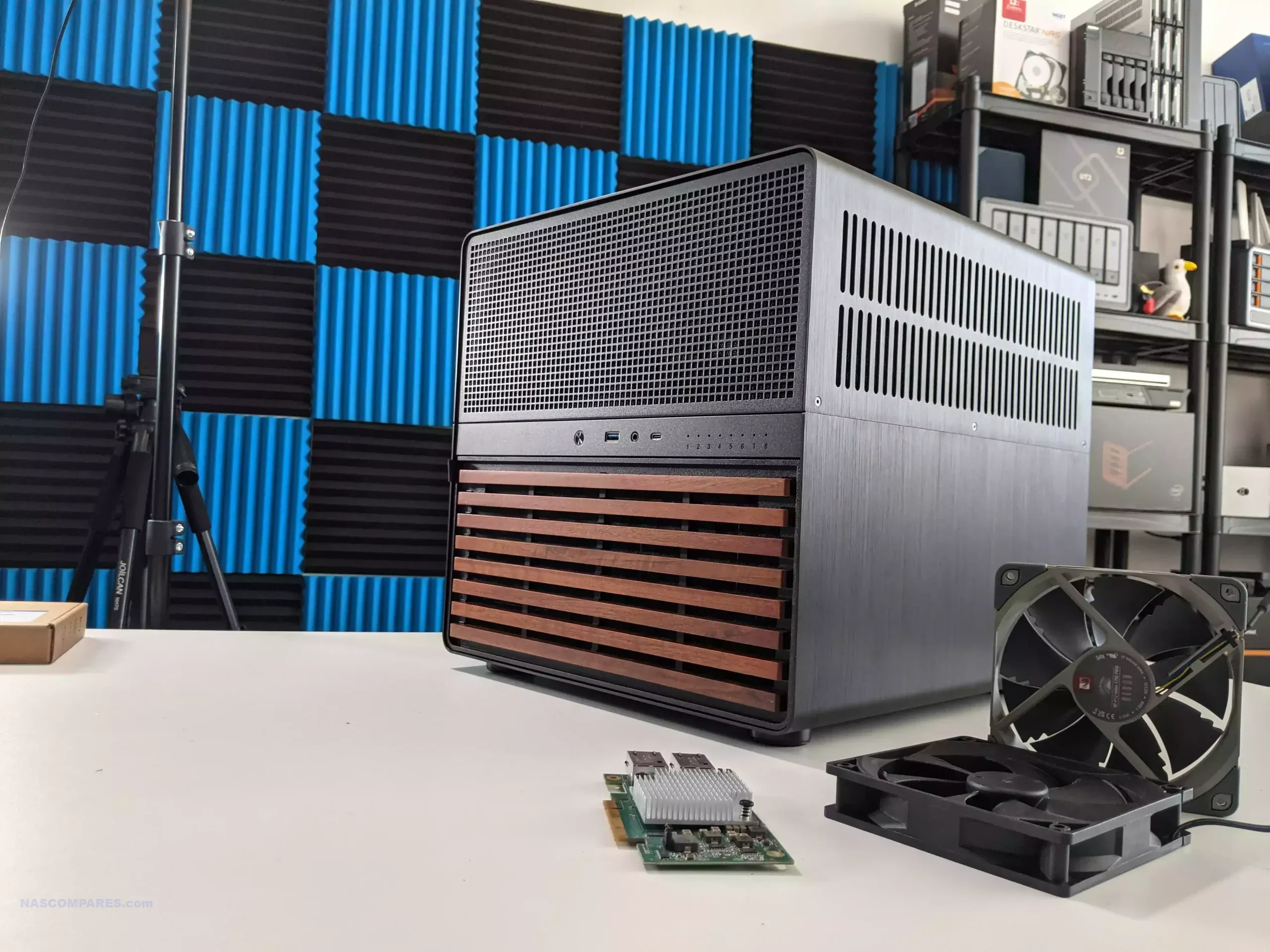
Jonsbo N5 Review – Conclusion
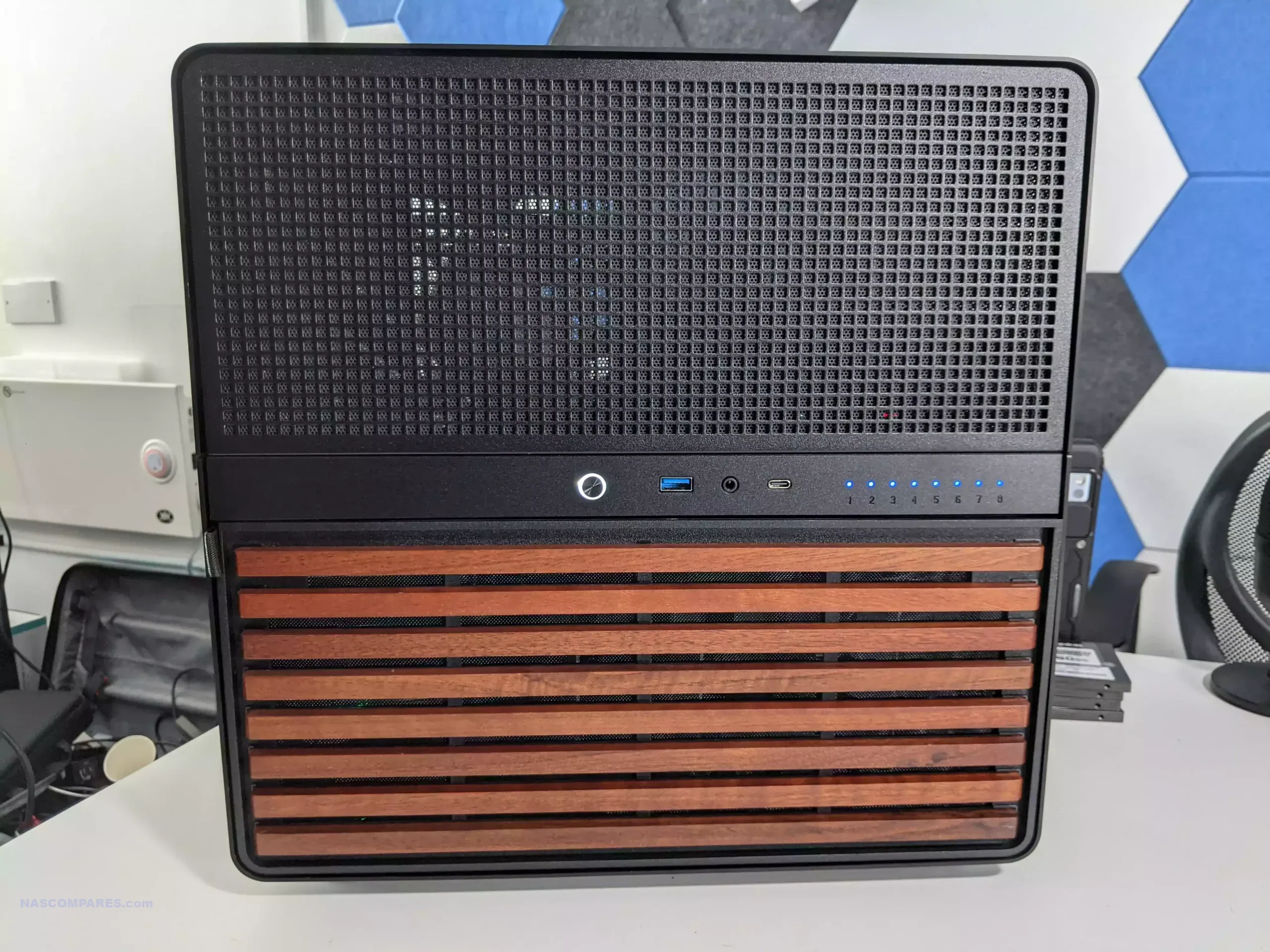
I think I’m in love! I have been playing around with DIY NAS cases for years now. I’m hard-pressed to call any single case “the ultimate NAS case,” but the Jonsbo N5 is as close as it gets. It might not be the smallest, or the most discreet, and those hard drive handles are a nightmare, but in every other regard, this is the perfect NAS case for your DIY server solution. If you have the surface area available, you simply will not find a more scalable and upgradable NAS solution in the DIY server market in 2024. It is not a solution for the timid, but if you are looking to start your server journey off right on day one and not have to be concerned in any way that you perhaps cannot scale the system in any direction down the road, the N5 will have you covered for decades to come!
Jonsbo has clearly spent a great deal of time learning from their previous releases and tweaking the things that needed to be tweaked. I’m sure it won’t be long before someone creates a hard drive tray mod that eliminates the issue of those rubber handles, and in every other regard, this thing is unbeatable. Also, if you factor in that the N5 is only around $80-100$ more in price than the N2, N3 and N4, but several times more broadly compatibility and scalable – it’s surely a no brainer!
Read the Jonsbo NAS Series Comparison Article on NASCompares Below (click below):
📧 SUBSCRIBE TO OUR NEWSLETTER 🔔🔒 Join Inner Circle
Get an alert every time something gets added to this specific article!
This description contains links to Amazon. These links will take you to some of the products mentioned in today's content. As an Amazon Associate, I earn from qualifying purchases. Visit the NASCompares Deal Finder to find the best place to buy this device in your region, based on Service, Support and Reputation - Just Search for your NAS Drive in the Box Below
Need Advice on Data Storage from an Expert?
Finally, for free advice about your setup, just leave a message in the comments below here at NASCompares.com and we will get back to you. Need Help?
Where possible (and where appropriate) please provide as much information about your requirements, as then I can arrange the best answer and solution to your needs. Do not worry about your e-mail address being required, it will NOT be used in a mailing list and will NOT be used in any way other than to respond to your enquiry.
Need Help?
Where possible (and where appropriate) please provide as much information about your requirements, as then I can arrange the best answer and solution to your needs. Do not worry about your e-mail address being required, it will NOT be used in a mailing list and will NOT be used in any way other than to respond to your enquiry.

|
 |
How Much RAM Do You Need in Your NAS?
A Buyer's Guide to Travel Routers - GET IT RIGHT, FIRST TIME
Jonsbo N6 DIY NAS Case Review
The Best Bits (and Worst Bits) of NAS of 2025!
Minisforum MS-02 Ultra Review
Minisforum N5 NAS, 6 Months Later - Better, Worse, the Same?
Access content via Patreon or KO-FI
Discover more from NAS Compares
Subscribe to get the latest posts sent to your email.


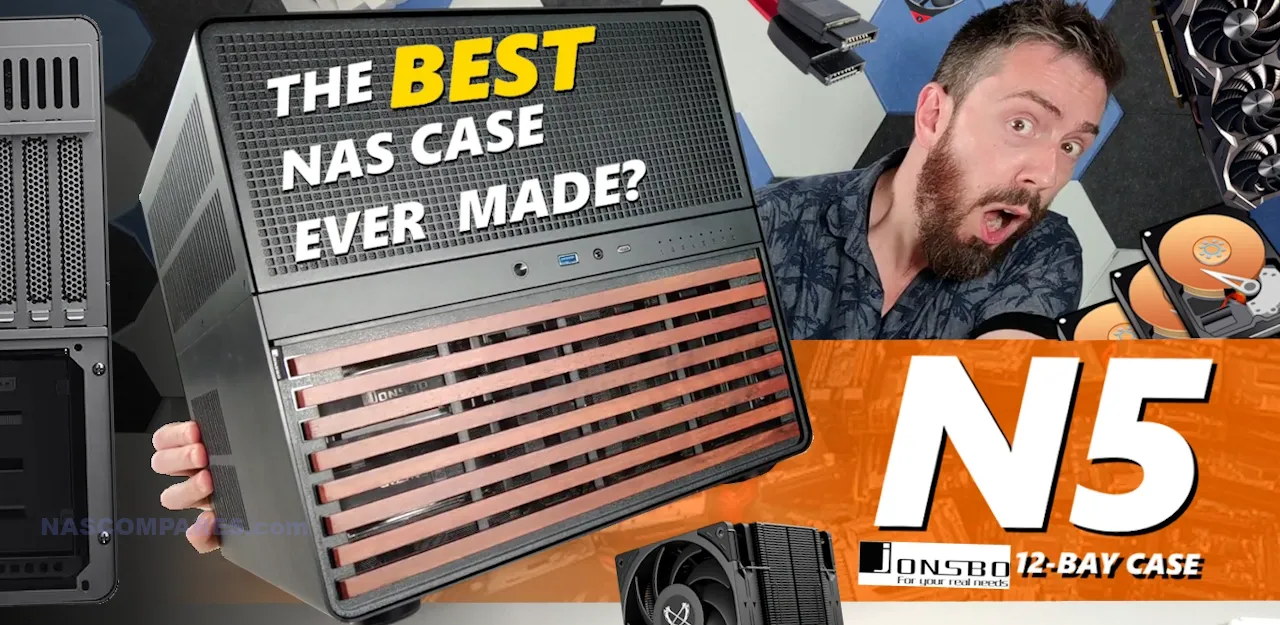
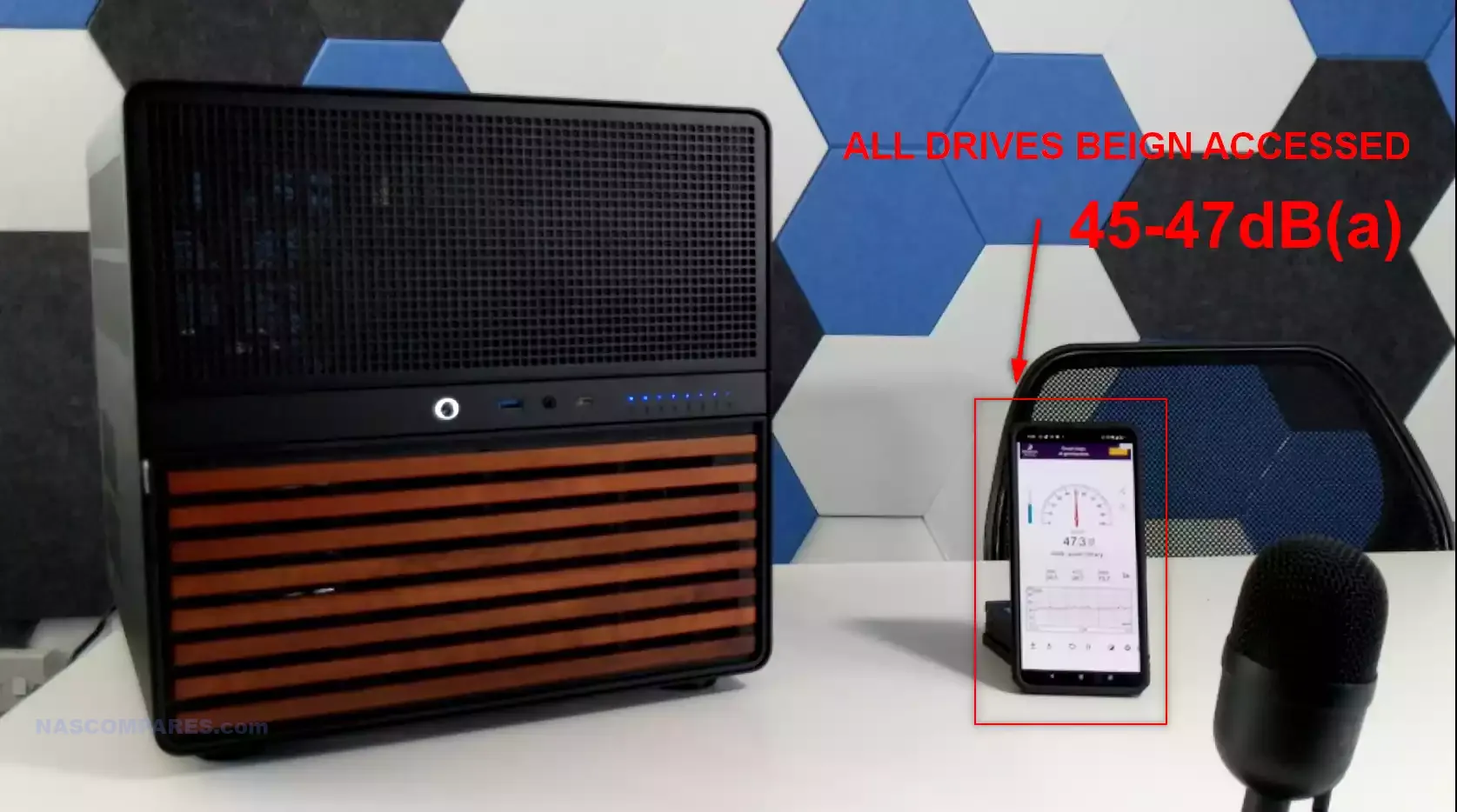
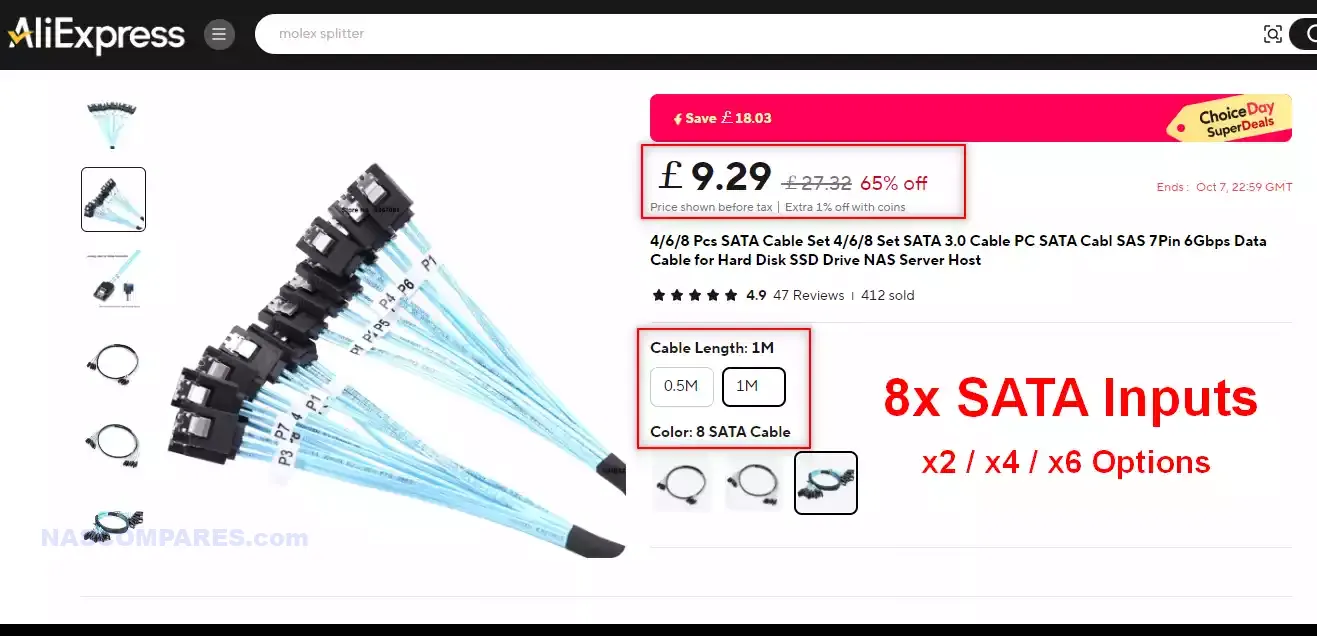


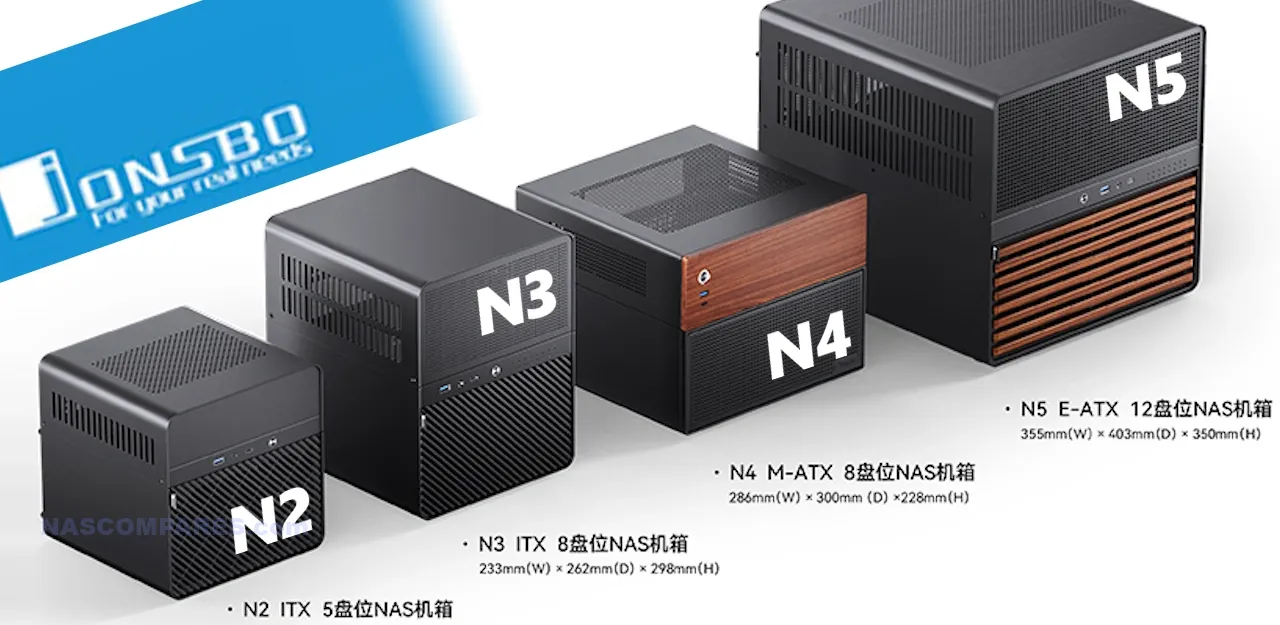



i mode from a node 804 to this. i didnt expect it to be THAT much better but it really is. The slightly larger volume is extremely worth it. Subjectively, I think it looks a lot better.
REPLY ON YOUTUBE
I’ve lived with the case here next to me, populated with 7 drives (planning on adding more) and it is a good case… however, the fan noise is ridiculous. The 2 fans at the back are powered via the SATA backplane by default and run at 100% 100% of the time… just stupidly ridiculous. So, I will add a looooong wire to set them both on my MB… If I find a way to monitor temp at the SATA backplane, even better…
REPLY ON YOUTUBE
You don’t understand?? wow that not difficult to understand, is not a professional NAS case. easy even kids can understand this
REPLY ON YOUTUBE
Oh wow the tray pullout function is a MASSIVE downside
REPLY ON YOUTUBE
Is there an aftermarket fix for the slider issue?
This is for building a NAS the whole FAMILY can access, and more importantly contribute to.
REPLY ON YOUTUBE
Very weird review. A big case for big motherboards. And he yaps about small motherboards and external peripherals. 10 minutes in and i give up listening any further.
REPLY ON YOUTUBE
realistically what is longest psu length you can use with this without losing the 4bay and still have room for cables? Thanks in advance.
REPLY ON YOUTUBE
Thank You for this build. Helped me with mine.
REPLY ON YOUTUBE
5:55 you had me laughing there. LOL
REPLY ON YOUTUBE
Forgive me what atx motherboard is in there?
REPLY ON YOUTUBE
The feet on the bottom are to protect from liquid spills. The rubber bottom on the n2 soaked up liquid. Could have use rubber feet.
REPLY ON YOUTUBE
They all have the same issue: if you want to add a PCI-E RAID adapter with a lot of write-back cache for fast (CPU offloaded) performance, the PCI-E port is so limited.
REPLY ON YOUTUBE
Wonder if a CWWK Q670 12 Bay M-ATX Motherboard work well with this case
REPLY ON YOUTUBE
Thank you so much for the video. Your video made me purchase this case and yes these tray solutions are the best. And worst part is I misplaced them, now I cannot find them anywhere in any online store. Do you have any suggestions or idea where I could get more of these rubber grommets and pull straps?
REPLY ON YOUTUBE
Great vid! Tbh im just looking for a decent horizontal mount case and this is well decent.
Dont spose theres any decent alternatives as i dont have any use for the nas part 😛
REPLY ON YOUTUBE
Thank you for this video. Very funny intro. I laugh when you show us all the route and wait to arrive from AliExpress but then I was startled when you threw the package at the door and over the desk … That must has been a muck up box …
I don’t understand why delivery to the UK has to go through the USA … My AliExpress deliveries to the UK come directly or if slow, they come by cargo train via Khazastan – Belarus – Poland – Germany
REPLY ON YOUTUBE
I bought the NAS case for a customer a few weeks ago.
Visually, it’s great and looks high quality at first glance.
However, in terms of technology and accessibility during assembly, Jonsbo doesn’t seem to have put much thought into it, and access to the vertical hard disks is also limited. You cannot use 2.5-inch hard disks without buying your own adapters.
Most people have 2.5-inch SSDs these days.
Additionally, the rubber bands, which also serve as the rail guide for inserting the hard disks, do not fit properly with either the SATA connector at the back or the rail itself, due to the rubber causing significant resistance.
I wouldn’t buy it again at this price. The HDD/SSD holder is the main issue — it’s okay for private use, but not for commercial purposes.
I am aware that you would normally use rack hardware.
REPLY ON YOUTUBE
I have this “older” version of the q670. How to i activate the vPro feature? I am running it with a 13500, so it should be available.
REPLY ON YOUTUBE
I am not sure if I overheard it, but does the Backplane use staggered spinup of the drives or do all the drives spinup simultaneous on start? That really makes a difference in choosing a PSU.
REPLY ON YOUTUBE
anyone who thinks a 12-day Nas is overkill is simply not doing data storage the right way even if you’re not a certifiable data hoarder there is no such thing as too much storage it may just take you longer to fill up 12 drives but there’s no such thing as too much storage
REPLY ON YOUTUBE
Where’s the build video?
REPLY ON YOUTUBE
Any idea of how this compares to the JMCD-12S4?
REPLY ON YOUTUBE
Too big to have next to the TV! Off the shelf 4-6 Bay NAS are so expensive given the hardware included and always equipped with noisy fans. DIY is the way to go but nobody seems to make the perfect case for mIDX. Case suppliers should skip on the fans or supply with low noise ones. Xpenology (DSM) is now installable in easy way now.
REPLY ON YOUTUBE
dude that thing is from China
maybe tell your President to hate China lesser and make better international logistics arrangement
REPLY ON YOUTUBE
Does anyone know if the Lian Li Edge PSU is a good match for this case?
REPLY ON YOUTUBE
FYI Utilize=use. Using larger words does not make one sound more informed. It is big, but can it handle and AIO?
REPLY ON YOUTUBE
I would try to cram another 2-3 drives in the motherboard chamber lol
REPLY ON YOUTUBE
The reason for continuing to use rubber is, of course, high profits. Otherwise, what do you think it is?
REPLY ON YOUTUBE
I’d love to know the powerconsumption of this one. I wonder can i use a GPU card on it too?
REPLY ON YOUTUBE
I feel like it’s kind of an ugly case ????
REPLY ON YOUTUBE
Hex screws are 100% better than Phillips screws.
REPLY ON YOUTUBE
Do you need to connect both molex and sata power to the backplane or can i just use sata power?
REPLY ON YOUTUBE
Hex screws are vastly superior to normal screws when it comes to longevity. The thing you don’t like is actually meant to be that way so you can take them off over and over again.
REPLY ON YOUTUBE
How can a case criticized for thin steel enclosure get a 10/10 in build quality?
16:00 the complaint here is related to silk screening. Easy fix for Jonsbo to implement.
REPLY ON YOUTUBE
Disagree with the hex screws 100%, get a cheap set of hex tools. Phillips screws are a joke. Or switch entirely to a magnetic/latch securing method.
REPLY ON YOUTUBE
It’s taken over a decade for the Fractal Node to actually have some competition in the market.
REPLY ON YOUTUBE
Boring case, it does not fit my dual Xeon EVGA SR2….
ventilation should be front and back, not at the sides thats just stupid.
Not to mention the fan grills are just terrible.
REPLY ON YOUTUBE
Noone says mobo. Say motherboard.
REPLY ON YOUTUBE
10:00 smartphone noise meters are notoriously unreliable.
Also, tee bee? Just say terabyte.
REPLY ON YOUTUBE
Another swing and a miss from Jonsbo. No sound insulation, garbage slide rail system, terrible hex screws etc. For those wanting an actually good NAS case, pickup the Antec P101 Silent Black ATX Case. 10x the quality at half the price. You’re welcome.
REPLY ON YOUTUBE
Too bad backplanes can’t support SAS drives
REPLY ON YOUTUBE
Seagulls are beautiful.
REPLY ON YOUTUBE
Do you have to carry everything you review up those stairs?!
REPLY ON YOUTUBE
ohhhhh I hope they bring out an imbedded CPU . wondering if should wait or commit
REPLY ON YOUTUBE
Maybe….. Best JAS case so far, to me.
REPLY ON YOUTUBE
8U portable server lol
REPLY ON YOUTUBE
Wow really good video!
REPLY ON YOUTUBE
Can soneone clarify what molex cable is required for this? Mines has just srrived and want to ensure i have the correct cabling before i start swapping over components
REPLY ON YOUTUBE
How much of a carbon footprint does that case have. Its been on more flights than most people do in their entire lifetime.
REPLY ON YOUTUBE
????????????????
Very well done intro, capped off perfectly with the abrupt audio transition to the slamming of the box.
REPLY ON YOUTUBE
Ehh. I don’t like the fact there is such a huge jump from the N4 to the N5 in drive bays. I don’t need 12, but I could use 8 drives bays. The N4 has only 6. And the next step down with the N3 only supports mini-ATX boards. I have a Mini ATX as I need 2 PCIe slots for the NBA and 10gig Ethernet.I mean sure this is a good case but my use case is something that is portable. The N4 could fit the bill if the other 2 slots were 3.5″ bays as there are plenty of adapters out there that will convert 3.5 to a 2.5″ SSD setup.
REPLY ON YOUTUBE
@NASCompares Do you think that the rubber pull handles could be replaced with more standard drive trays from another case? I’m not a fan of the fiddly rubber handles.
REPLY ON YOUTUBE
4:40 EXCUSE ME!?
REPLY ON YOUTUBE
m.2 to 6x sata adapter, is that reliable?
REPLY ON YOUTUBE
Does anyone other then me think it would be possible to rig some type of HD holder with a real handle using a 3d printer? Would be really interested to hear if it might be possible. I dont have the new case yet.
REPLY ON YOUTUBE
I’m Canadian, so I used a shipping receiving company in USA to receive the box for me for $5 and drove across the border to pick it up – to avoid insane shipping fees. This case is 100% overkill for me, but that’s ok.
This will be my first NAS build ever, and only second build ever (my other one was a PC). I will be starting off with:
– Intel Core i5-13600K
– GIGABYTE Z790 AORUS Elite X WIFI7
– TeamGroup T-FORCE DELTA RGB 32GB (2x16GB) DDR5 6000MHz CL30 UDIMM (didn’t want RGB, but it was the best deal at the moment for a CL30 DDR5 ram)
– WD Black SN750 NVMe 1TB PCIe 3.0 (Cache)
– WD Black SN750 NVMe 512GB PCIe 3.0 (more cache? I don’t really know what to use this for, but I already have it)
(regarding the SSDs, I am pulling them from my PC, and upgrading my PC ones – so they are a little underwhelming for this build, but good enough for now)
– Storage: 4x Seagate Ironwolf Pro (Enterprise) 16TB (for now)
– PSU: Corsair RM850x Gold (overkill, but got it for decent price)
– Case: Jonesbo N5 (duh!)
– CPU Cooler: Cooler Master Hyper 212 Black Edition
– Case fans: Noctua NF-A15 HS-PWM chromax.black and SAMA BL 3 in 1 ARGB fan kit (had these fans laying around)
– USB Boot drive: Anker 2-in-1 USB 3.0 Portable Card Reader with SanDisk 32GB Ultra microSDHC UHS-I Memory Card (planning to run unRAID, and the GUI is assigned to the card reader, so I can remove the microsd and make copies of it)
– External Hard drives for additional backup for sensitive files: – 2x 14TB Seagate Expansion STKP1400400 and 2x 8TB WD External HDD (some will be offsite ideally)
– I’m going to try to do this workaround I saw online where backblaze personal can be used to backup the NAS, instead of the more expensive B2.
I wanted ECC, but mobos and ram were too expensive and I won’t be using ZFS files, so I hope/think regular memory is ok – considering unRAID works off parity instead of data stripping.
Any feedback is appreciated 🙂
REPLY ON YOUTUBE
Nice try. I may be wrong, but I observe that you and the Chinese manufacturer could’a mentioned that there is no such thing as 2x96GB UDIMM kit available for sale ANYWHERE. You and the manufacturer could’a also clearly specified a Bifurtication feature. Also, what iGPU does this come with? Not your fault because you tried. I believe you. Until I can see more clearly better specifications. I am just not comfortable enough yet to push the buy button. I imagine by April 2025, manufacturing and marketing kittens will open their eyes and mature this product description.
REPLY ON YOUTUBE
I initially saw this review and figured it would be too big for my needs, but as I do more research on enclosures I’m quickly realizing that they all make compromises in the weirdest spots, so I’m quickly circling around back to this one because while yes, it is a bit large and I don’t need quite this many drives, it also doesn’t compromise in any of the areas I actually care about.
Now to see if I can actually get hold of one.
REPLY ON YOUTUBE
I wonder how safe these boards are when it comes to hardware level spyware/backdoors? Have you tested it with wireshark to see if there is any unauthorized communication between it and its homebase in china?
REPLY ON YOUTUBE
I wonder if the drives cages are completely removable and that there are aftermarket drive cages with proper sleds that fit this case.
REPLY ON YOUTUBE
Did I miss the upload of the build video?
REPLY ON YOUTUBE
Okay. Now I want them to come out with a Jonsbo 4.5 NAS Case lol. The 4 not quite big enough and the 5 is too big lol. If the 4 had 6 easy remove hard drive back plane it would be perfect for me.
REPLY ON YOUTUBE
FOKKERPARK
REPLY ON YOUTUBE
put noctuas in it
REPLY ON YOUTUBE
I can’t find any info. Can 12 by 13 be installed in this case?
REPLY ON YOUTUBE
Deal Breaker, no Blu-Ray Drive support, they could fit a laptop version in it.
REPLY ON YOUTUBE
im Happy, A Case Company is at least giving us, this. Proprietary i hate. i built a N3 throw Win 11 on it, and 10gbe and i use the ram and intel optane for cache, very fast.
REPLY ON YOUTUBE
I didn’t even watch the video, I just clicked on the Like button. I found what I need in the video description… But I watch your videos regularly, very good content you have.
REPLY ON YOUTUBE
when will we get the build to youtube 🙁
REPLY ON YOUTUBE
Damn I was with you till you said it’s as loud as a rack mount NAS
REPLY ON YOUTUBE
PC Topton low quality product, no warranty and no technical support, I bought it on Aliexpress and it was money thrown away. Advice from a friend, look for another brand
REPLY ON YOUTUBE
CWWK released a new version of this board, a white version with 2 SFF ports which can provide 8x SATA
REPLY ON YOUTUBE
Can the fans be replaced with static 120mm fans which could be quieter?
REPLY ON YOUTUBE
I bought a Topton computer and threw my money away, it is a low quality product, without technical support. Friendly advice, look for another brand.
REPLY ON YOUTUBE
At this size I feel like just getting a Fractal R5 for $100. You can cram 12 drives in there if you try.
REPLY ON YOUTUBE
which PSU would you recommend with this board if i want to use 8x22tb drives?
REPLY ON YOUTUBE
Ryzen 5800u on a mini Nuc is cheaper with 16gb ram and dual 2.5G with wifi 6 and 512 nvme. Just add 2 USB 8TB drives and install TruNas. Its 25w TDP and can do gaming with the built in gpu
REPLY ON YOUTUBE
This case needs a revision.
REPLY ON YOUTUBE
22:30
That’s what she said.
REPLY ON YOUTUBE
naah. gonna stick with 804. but full atx is a miss.
REPLY ON YOUTUBE
No
REPLY ON YOUTUBE
I built my first NAS recently in a fractal 304 case with an old Ryzen CPU and MB I had lying around, problem is it’s only got 4 SATA ports.
I’m trying to decide on whether I upgrade to this and a new intel with an iGPU, or I upgrade to a Micro ATX motherboard with an intel CPU and put it into a fractal 804 :/
REPLY ON YOUTUBE
Could I use SAS drives in this enclosure by using an adapter and moving the backplane back 10 mm so I could get the front back on. I would be using a SAS pci card with a mini sas adapter.
REPLY ON YOUTUBE
When is the Build video coming?
REPLY ON YOUTUBE
Neat case but for the price you can get it in EU, I’d go for Define 7 or Define 7XL or even Define R6. These are much cheaper where I live than N5.
REPLY ON YOUTUBE
I want one…. 🙁 Tho I am waiting for retailers in EU to stock those still, cuz I don’t have the balls to gamble with China shipping anymore 🙁
REPLY ON YOUTUBE
Would you say it’s worth replacing the thermal paste at purchase?
REPLY ON YOUTUBE
If this had a slim ODD bay I’d switch to it.
REPLY ON YOUTUBE
Hi! Thanks for all your videos, I learn a lot with you. I have recently gone ahead with a Jonsbo N3 + CWWK 8505 motherboard. I have configured everything and it works great with Unraid, except fan control. I have switched all the fans in the case to PWM but regardless of whether or not I activate the dynamic control system and its thresholds in the BIOS, or even setting the fan control to a manual PWM value does not generate any change in their behavior, they continue to run at the same speed. I don’t know if I should update the BIOS or what I should do, but I can’t find any documentation or link to a more updated bios version either. If you could help me I would be very grateful. Best regards.
REPLY ON YOUTUBE
I am amazed at their website, the TK series should be more popular yet I’ve never heard of them before. I would totally get a TK-5 if they made one
REPLY ON YOUTUBE
What *Mobo was used in that? It had great io on it ????
Edit oh its a hero so hi end and full size so IO isn’t that surprising lol. Great content as usual, not sure id ever look anywhere else for NAS stuff you guys do it best! ❤️
REPLY ON YOUTUBE
Any micro atx in this similar configuration? Will be using it in the Jonsbo N5
REPLY ON YOUTUBE
I wonder how quiet it can be with just SSDs
REPLY ON YOUTUBE
I have been dying to build myself a decent nas for about 5 years now (not including splurging money on used servers/workstations which cannot be run 24×7).
The motherboards that cost $200 cost $500-700 used in India. At this point I am beyond frustrated. Time to start looking for that long lost friend who settled abroad to bring back a decent MOBO on his trip back home.
REPLY ON YOUTUBE
Moore Donna Jackson Amy Perez Patricia
REPLY ON YOUTUBE
3 minutes worth of intro is absolutely nonsense my friend.
I have to watch 3 fucking Ads before seeing the case.
REPLY ON YOUTUBE
I would like to see how you supply 12 sata drives from one PSU given most PSUs only come with 6 sata power connectors. Molex? More info please ! ????
REPLY ON YOUTUBE
Clark Donald Martinez Maria Taylor Ruth
REPLY ON YOUTUBE
Will SAS drives work in this case? The interface seems like it will bit it uses sata cables.
REPLY ON YOUTUBE
Honestly, if I’m gonna build a NAS with that many drives, I’ll get a regular PC case that can support that amount. This case is ugly as hell even for a NAS case.
REPLY ON YOUTUBE
Just discovered the channel, it’s great!
Newbie question: could a case like this be a NAS AND a good gaming rig (like RTXX 4090 good)? If yes, would you make a video on it (specs for the build, configuration etc…)?
REPLY ON YOUTUBE
Oh boi … last year the N3 … now I am planing for the N5!
Those extra 4 bays will come so in handy for SSD storage – the extra space will come so in handy for extra M2 NVMe cards and PCIe to M2 cards!
Really thrilled about this 🙂
REPLY ON YOUTUBE
Loving my N2 case. Upgraded my non-NAS case to one of those recently and it was pretty easy to work in. I changed nothing about my system config but at least now I can add new HDDs in the future. It’s already pretty substantial and I can’t imagine how much heavier this case is.
REPLY ON YOUTUBE
Where would a NAS with this much speed, memory and processing power be used?
REPLY ON YOUTUBE
I tried an N3, and it had absolutely massive resonance, that made hard drives normally audible from 3 feet away audible from outside the room, 7 feet away, instead. I ended up returning it.
I wonder how much *this* one will resonate?
REPLY ON YOUTUBE
just lubricate the rubber HDD mounts, they will slide easily
REPLY ON YOUTUBE
Fantastic Review! Love it! Awesome case. Cracking my head on whether I can justify to get this case!
REPLY ON YOUTUBE
I hate FedEx so much….
REPLY ON YOUTUBE
2:17 – at least they’re remarkably nice looking steps.
REPLY ON YOUTUBE
but WHY NOT USE SFF-8643 instead 12 sata cables 🙁 (where is no many board’s have 12 sata, so many people will use SAS HBA)
REPLY ON YOUTUBE
does anybody know if you can replace the back plane with something that supports SAS drives and SFF connectors?
REPLY ON YOUTUBE
Commented and subed just because of intro love it!
REPLY ON YOUTUBE
Its nearly a 50L case haha….at which point do we just say that there is zero physical space savings of this over a mid tower chassis?
REPLY ON YOUTUBE
So not perfect but good enough for the most part.
REPLY ON YOUTUBE
It would be interesting to see a cluster NAS / Homelab in a box in this case. Like having 3x N305 itx boards stacked on top of each other.
REPLY ON YOUTUBE
Bro! I need some NAS help and I do know who else to ask! I made a DIY NAS with drives but only using 2 atm. A 350W flex atx psu but the drives are not spinning up! Do I need more wattage?
REPLY ON YOUTUBE
for that price you can buy a rack mounted server case !!!
REPLY ON YOUTUBE
Still thinking of the Define 7 instead of this as I think I’d be quieter & provide better cooling… the front bays are nice tho ????
REPLY ON YOUTUBE
Hmm its kinda too high (my max is 33cm), i dont need alot of cooling and stuff. I hoped it would be less taller.. so i think i will go with the n3 and 2 92mm noctua fans for the hdds
REPLY ON YOUTUBE
Is this finally available?
Got a sick build in mind since it can handle eatx board’s and well i got me a banger of a board and CPU ram. Though oddly no USB internal header for fan controllers.
Nvm can’t justify the human trafficking cost of shipping ☠️
Case $556 Cad + $192 shipping. Guess I’ll wait till one hits eBay or Ncase has some in the western world.
REPLY ON YOUTUBE
It’s quite amusing how ZimaCube apparently took “inspiration” from the Jonsbo N5 NAS case. The front panel resembles a doppelgänger, and don’t even get me started on the identical IO port placements and ventilation design. It’s like they ran out of creativity and decided to photocopy the blueprints. Mechanical layout? Practically a mirror image. If imitation is the sincerest form of flattery, Jonsbo should feel immensely complimented.
REPLY ON YOUTUBE
How much did you pay for shipping ?
REPLY ON YOUTUBE
What motherboard were you using for this?
REPLY ON YOUTUBE
Great home server case, looks nice. Definatly room for a V2 tho
REPLY ON YOUTUBE
Is there any way to utilize the multi drive bays for 2.5in ssds??
REPLY ON YOUTUBE
Dumb question – does the backplane power require both Molex connectors and the SATA power connector, or is the single SATA power connector sufficient?
REPLY ON YOUTUBE
Love this intro, music reminds me of Charlie Chaplin, which was actually quite appropriate!
That case is HUGE! The only other case I can think of with that layout is Thermaltake’s Core X9. With the size and weight of graphics cards these days, I’m surprised there aren’t more cases with a horizontal motherboard tray.
REPLY ON YOUTUBE
I like it. But I’d love it if it were rackable
REPLY ON YOUTUBE
Looks to be the same dimensions as my Fractal Node 804.
REPLY ON YOUTUBE
I want one of these so bad… I don’t have anything to put in it, nor the money for either, but I still daydream about having one for a home server/lab.
REPLY ON YOUTUBE
$200 shipping…GTFO!!
REPLY ON YOUTUBE
Wouldn’t this make an awesome all in one. Modem router double NAS 8xX/2,,4xX!
REPLY ON YOUTUBE
Amazing doucheFace thumbnail! Congrats you look like every unimaginative, lazy creator on YT. Clearly intelligent people choose stupid face thumbnails because looking like an idiot is a huge indicator that your content must be amazing! ????
REPLY ON YOUTUBE
OK so… case is amazing, BUT two things:
1. it’s a couple of cm too tall and wide to fit in a Kallax and that’s the greatest shame ever. Width could be solved by not installing one of the vertical separator, but height? that’s an hard one. It’s twice of a shame because the top half is way to big and could easily be an inch shorter!
2. that 8 disk backplate looks amazing and I REALLY REALLY REALLY wish they would sell it standalone because it would be amazing for custom cases! I’m dabbling in 3d printing cases and finding decent backplate with good drive separation and with a low profile/holes to allow for a good workflow is next to impossible to a level where I’m contemplating sudying electronics to make one.
REPLY ON YOUTUBE
Jonsbo try so hard to make perfect NAS case and always fail on the simple things. My main problem is with the backplanes. Why can’t they use a SFF format connector instead of the basic SATA. It could make the build much more cleaner, to use 3 SFF cables instead of 12 SATA cables. Also, why they have to combine so many MOLEX and SATA power connectors? Molex is dead, use just SATA. Three SATA connectors would be fine (two for the main 8 port backplane and one for 4 port backplane) instead of five. And the last major problem with the backplanes are their lack of perforation. The main 8 port part don’t have any. There is only about 1cm space on top of the drive bay which I doubt will be enough to cool (especially in the summer) if you have this case just laying in the house and not in cooled server room. The 4 port backplane have some perforation but it almost don’t have any access to the airflow because of the power supply right behind it. And I also don’t like the rubber used for the drive sleds. Rubber will disintegrate over time and become useless to pull the drives out of cage. But I understand that they used it to make the case cheaper.
REPLY ON YOUTUBE
Jesus… everywhere is charging $200 shipping for a $200 case. Insane
REPLY ON YOUTUBE
Hate Philips screws and Pisidriv are only marginally better. Hex socket screws for me every time
REPLY ON YOUTUBE
You always do a nice job on physical hardware reviews, but you almost always leave out one very critical piece of information: HDD operating temperatures. The design of this Jonsbo case does not come close to providing adequate “push or pull” airflow over ALL 12 dirve bays. It would be extremely helpful to know the HDD temps. Yes, it requires more effort, but it would be greatly appreciated. Thank you.
REPLY ON YOUTUBE
You’re getting a like for the intro alone. ????
I’ve always been tempted to order some things from AliExpress, what’s the deal with import taxes, if any?
REPLY ON YOUTUBE
If you try to look at the case as it self not bad, but if you try to put it in the world and compere what’s out there at this size and form factor its most efficient if you buy a rack-able case instead of putting this somewhere if you need a NAS this size you probably have networking and maybe a server or two then at that point you need a rack solution albeit small but none the less a rack solution.
REPLY ON YOUTUBE
The case is almost ideal for a small general purpose server. I’d be tempted to use a second hand Supermicro mobo with lots of PCIe connectivity, Epyc or Xeon processor.
SAS backplanes, as mentioned by others, along with SFF connectors. I’ve invested in a bunch of SAS HDDs.
It *might* be possible to replace the SATA backplanes assuming Jonsbo use the roughly standard 80mm spacing. I don’t mind a bit of a bodge fit, metal part fabrication, 3d printed brackets.
REPLY ON YOUTUBE
Yes! Or so I thought…
I’ve been waiting for this case for the better part of half a year, once the rumors came out.
It was so long in fact, that i decided to just repurpose my old pc case from 12 years ago and put a 5.25″ to 3.5″ cage/adapter into it for 15$. Now i get 12 HDD capacity for next to nothing.
I thought it would be temporary, but seeing the price of N5 kills it for me, sorry.Yes, i get it, shipping 7.5KG is no joke, but not for x2 the price.
It’s a kickass case, and everything i hoped it would be, but I’ll keep using my practically free bubba build for now.
(Wrote this prior to even starting to watch the video, and it seems i guessed everything right, hehe)
REPLY ON YOUTUBE
LOL, I actually prefer hex screws over philips for the exact opposite reason you mention xD
For me, Philips always easily round over, especially if over tightened and the hex socket screws are far less of a trouble. Sounds like you might need a solid allen key set that properly fits the screw head and your rounding issues should be far less common.
REPLY ON YOUTUBE
long time subscriber here. Can you please please please fix your audio? It’s so muffled and I like to run your videos in play=all mode, but its driving me crazy lol
REPLY ON YOUTUBE
N5 looking really good … but is really big. What do you think? N4 is good too?
REPLY ON YOUTUBE
This new background is AMAZING! 🙂
REPLY ON YOUTUBE
You had me until I saw your cable management.
REPLY ON YOUTUBE
I ordered the case from AliExpress, funny enough, it took awhile also well beyond their estimate
REPLY ON YOUTUBE
Still looking for a decent 12 bay case with a similar drive layout as a SYN DS2422 or TERRAMASTER T12.. but with dual PSU, ZFS, decent CPU, NVME and 10Gb. A tall order, but maybe 2025 will finally be the year of the 0.25 Petabyte project.
REPLY ON YOUTUBE
3.5″ NASes all-over, NVMe NASes sprouting all the time. Why 2.5″ SATA SSDs NASes get no love? What am I missing?
REPLY ON YOUTUBE
“Was is das? Das is ein NAS. Ich hasse Möwen, Scheiße!”
REPLY ON YOUTUBE
I just don’t get it. Fractal Design Define 7XL with terrific design, build flexibility, industrially silenced case, 18 drives bays + 5 SSDs, any MB, any cooling system, any discrete GPU… Here for ages for 250 USD… And it has USB-C on its front panel 🙂
REPLY ON YOUTUBE
Just finnished my N5 build this week. Can confirn the noise, Loud as heck!!!
REPLY ON YOUTUBE
I ended up running the 3 fans to the mobo with extensions and low noise adaptors. Everything is still cool, but now basically silent. Cause I couldnt believe how loud it was with them plugged into the backplane.
REPLY ON YOUTUBE
When I was a listing for that, the shipping from China costed about 200 USD. I will wait for it to be locally available.
REPLY ON YOUTUBE
First, love the way you showed how the case travelled and some outdoor scene. May I know what are the temperature of the disks in the 4 bays cage, compare to the 8 bays? As there are no fans directly behind the 4 bays cage. TQ
REPLY ON YOUTUBE
Hmm. I really like that case!
*Thanks for the video!*
REPLY ON YOUTUBE
I love that they don’t use trays and the drives just easily slide in to their slots. Less cost on developing the trays; simple is underrated tbh. Also, idgaf about numbering… Do you cable the drives to the mobo according to the numbers on the case? If the numbering is off, do you go back and shift the back end cabling to adjust for the offset? I don’t fuggin change that sheit. If a drive fails you’ll know it and hear it. If you can’t immediately locate it, takes 2 mins to find it. Most times you know which drive it’s gonna be…
REPLY ON YOUTUBE
Dang, buying for ali with shipping is going to be over $400. I think I am going to wait till it pops up on Amazon.
REPLY ON YOUTUBE
19:32 what m2 to sata adaptet?
REPLY ON YOUTUBE
Are the backplanes SAS compatible? Or SATA only?
REPLY ON YOUTUBE
the this is a real NAS case
REPLY ON YOUTUBE
I feel like there’s a lot of wasted space with this case
REPLY ON YOUTUBE
Why did you take the bus in this video? You should have gone in your Audi RS6 as all the other tech review YouTubers.
REPLY ON YOUTUBE
This thing is officially ‘The Beast!’…Love it!
REPLY ON YOUTUBE
9:43 Wait, are larger HDD drives really noisier? Wow, okay. Why isn’t that bit of wisdom more widely known? I might have to rethink my set up since I have to keep my home server inside my room.
REPLY ON YOUTUBE
I’m waiting for mine to arrive. I notice molex and sata on the backplane. Do they both need to be populated or is it one or the other? A choice?
REPLY ON YOUTUBE
Hi! I assume that this board is made in China? I don’t´t trust and don´t want to support China in any way if possible. I really would like to see a video like this (or diy nas in general) but parts that don´t came from the greatest country on earth. Cheers!
REPLY ON YOUTUBE
I had to laugh as I had a similar situation recently. This all FedEx, which is seriously on a downslope.
REPLY ON YOUTUBE
Wow, I REALY, REALY like the 12Disk NAS case! Im rocking a PROXMOX server in a Roswill case that this would easily replace and save me tons of space!
REPLY ON YOUTUBE
No idea if this would work.
Remove the four drive backplane. Would a 4-6-8 etc ICYDock type enclousure for SSDs fit in that space? As there are already cables all over the place. A few more would not hurt. SSDs connection to an HBA with SAS SFF-8643 or SFF-8639 connectors to keep the cables in check upstairs.
REPLY ON YOUTUBE
I believe that this case has too many air vents. The air flow will be chaotic. As the air can be drawn in from anywhere. Covering the top and side vents of the mobo part may help thermals and noise. looking at the HDD lower part. As the vents are at the sides, near the fans. I presume that most of the air will be drawn in via these vents, and out via the fans. If so, this bypasses most the HDDs cooling. It also looks like only the risen heat from the HDDs will be removed. Once the heat rises above the solid backplane. So there is little direct flow of air across the drives, front to back.
Talk about Spagetti Junction with the cabling situation.
The backplanes are likely just reused from previous 4 and 8 bay cases. Which is why there are two separate backplanes with incorrect numbering.
REPLY ON YOUTUBE
Fantastic intro!!! And the background of the studio is quite nice.
REPLY ON YOUTUBE
Do they have a white version?
REPLY ON YOUTUBE
The N5 form factor reminds me a little of the Synology 12 Bay DS3622xs+ or DS2415+. Nice bit of kit that. Totally agree on the drive bay / trays, a bit odd it is.
REPLY ON YOUTUBE
The king is here, this case is great
REPLY ON YOUTUBE
How loud is this compared to a rack-mounted ‘NAS case’ or rack server with 12 or 16 HDD bays? I’ve been steering away from rack-mounted homelab specifically because of noise, but if noise will be a factor anyway even in (slightly) more traditional home-friendly chasses, maybe there’s no point to avoiding getting a rack.
REPLY ON YOUTUBE
All I know is we are into October and still no news from synology on anything… if we don’t get a notice by Nov 1st I guarantee there won’t be any releaes this year. They wouldn’t miss black friday for a new release.
REPLY ON YOUTUBE
Great video! You definitely got me excited about mine arriving soon. Cant wait to see the detailed build.????
REPLY ON YOUTUBE
I am so excited for this case to become cheaper! Can finally move my NAS from my NZXT H440 and take up less space with the same parts.
REPLY ON YOUTUBE
I feel like with a case like this there should be an option to just have a pci-e to sata adapter with one cable now that would be cool.
REPLY ON YOUTUBE
Totally disagree with hex screw opinion. Hex screw heads are superior to phillipshead in every way. If Jonsbo had used Phillipsheadscrews, these would have been much bigger. But size and head forms are two different topics.
REPLY ON YOUTUBE
Great review, appreciate all the work.
REPLY ON YOUTUBE
If it’s not rack-mounted, I ain’t buying it.
REPLY ON YOUTUBE
I think all it needs is a couple sheets of sound deadening material and it would be perfect aside from the rubber pull handles
REPLY ON YOUTUBE
Fantastic content! Also, a quick congratulations on the office space. It’s been a bit since I tuned in- very happy to see the channel growth.
REPLY ON YOUTUBE
Do you think there’s any chance of fitting a 360mm AIO in the left (as intake) or right (as exhaust) sides if I were to sacrifice a PCIE?
REPLY ON YOUTUBE
This is way deeper than it needs to be, they could have orientated the PSU so the back of the PSU faced one of the sides, they could have reduced depth, given more flexibility, and still support E-ATX/EBB.
REPLY ON YOUTUBE
Love the storytelling in the beginning of this video! What’s with the wooden panel of the case, suddenly you see them everywhere.
REPLY ON YOUTUBE
ooh FedEx…. i always worry when my tech is sent to me with FedEx…. that’s the only carrier that consistently trashes packaging in my experience
REPLY ON YOUTUBE
Wow, IT’s finally here. I’ve been waiting for this case since you showed it at that trade show.
REPLY ON YOUTUBE
They should provide option to have 8xSSD(SATA) instead of the 4xHDD bay for a grand total of x8 HDD and x8 SSD (SATA)
REPLY ON YOUTUBE
Great video! Can’t wait to get my hands on one of these.
REPLY ON YOUTUBE
8:38 I thought you were going to play Down Under by Men At Work
REPLY ON YOUTUBE
that box is massive. you can nest a whole family of seagulls in there.
REPLY ON YOUTUBE
Ah, I see…your shipment took the long FOKKER Park route!
REPLY ON YOUTUBE
You get what you pay for. This isn’t built by Elon Musk, but the cheapest parts and design in CCP
REPLY ON YOUTUBE
Get a cosmos case, even with 13 drives you’ll barely notice it’s on. That IS a masive case.
REPLY ON YOUTUBE
i think thee reason is coosts ? or maby they don’t want to add trays so people can not add ssd ?
REPLY ON YOUTUBE
Haha absolutely love the intro, we’ve all been waiting for this case!
REPLY ON YOUTUBE
the specs say with all 12 drives a max of a 170mm psu is supported
i have a spare 175mm psu, do u think like for the pcu cooler they added a 5mm buffer for psu too?
REPLY ON YOUTUBE
Imagine you fit all slot with MG09 and they all doing random access at once ….
Beethoven now
REPLY ON YOUTUBE
Can’t wait to see a build example with a regular ATX mobo with more expansion possibilities. The case is looking nice, but man it sounds cheap. It desperately need some case coating to damping that thin metal without ruining the airflow. I could definetly see a reason for people that don’t plan on going higher than 8 HDD’s to start with to just remove the 4bay slot and use the space for hiding cables.
REPLY ON YOUTUBE
No reason to buy this unless you travel with your nas
REPLY ON YOUTUBE
While I’ve been enjoying the Jonsbo case content i feel the need to address the handles. those mounts are specifically meant for mechanical drives, as you are using in the video here, to absorb the vibration of the drive. This isn’t a new idea though Jonsbo is the first I’ve seen approach it in this manner. My current “enthusiast” case is a Lanboy Air in which Antec tried to absorb that vibration using a a rubberized suspension system. The case is old and all of my rubber suspenders have failed years ago, which is my only concern here with Jonsbo. What will this solution perform and handle like once the rubber has gotten stiff and brittle? How much vibration will they contain at that point if any?
REPLY ON YOUTUBE
Maybe someone can come up with a good 3d printed rail thing for the hard drives.
REPLY ON YOUTUBE
I want one, but not going to buy it over ali.
REPLY ON YOUTUBE
Too expensive for my needs, will get a terramaster instead and see in a few laters if ill go diy.. For EU + shipping + taxes almost 450E which is insane…
REPLY ON YOUTUBE
A lovely bit of Chopin, proving a man of culture!
When does a NAS case become a server case?
REPLY ON YOUTUBE
the drive straps are fine. remember vast majority of people will use those straps twice. once to install and once to remove.
REPLY ON YOUTUBE
I’m a NAS n00b but satisfied I went with a different case instead of waiting for Jonabo to start shipping the N5.
Ended up building with a Thermaltake Core V21: m ATX mobo, ATX PSU, full height tower cooler, room for full size GPUs, 3 x 3.5”, 3 x 2.5” drives, room for seven 140mm fans. Still fussing with software but it should serve my needs for a few years.
REPLY ON YOUTUBE
great review! how about a comparison with the jmcd 12s4?
REPLY ON YOUTUBE
That classical music was wonderful
REPLY ON YOUTUBE
I was going to order one until I saw the price of shipping and that made it a big no , no .
REPLY ON YOUTUBE
Why the filter mesh that comes with it is not magnetic? but have double sided tape? Will be a pain to clean it.
REPLY ON YOUTUBE
My first take on this is the drive configuration 3 rows of 4 drives would I thought been a cleaner design and the rubber handles mmmm ,what is the chances they are going to deteriorate and snap over time?
REPLY ON YOUTUBE
Haha loved the intro to this. Good balanced review! I ended up using ironwolf pro drives in mine and noticed I did not need any of the fans so just have them disabled. The N100 board I’m using, while comically small, also sips power and doesn’t require much cooling. So overall surprisingly quiet, just a little hum. The perfect NAS for me…and really almost anyone. So much flexibility! It’s just a chonky boy though and hard to fit in entertainment centers and other common places for a NAS.
REPLY ON YOUTUBE
Awesome review, glad I’ve waited for it before making a decision to build my first nas system. Almost all “negatives” points about the case don’t bother me at all, however the only two point that concern me are noise and powerefficiency (hence why I’m using my noctua fans). I’m planning to upgrade it over the years into a gaming nas with a dedicated gpu, 10gbit network — but also for data hoarding and my family cloud solution.
Would you recommend using this particular case for this usecase or is that just absolute overkill? Also how does it compare to the fractal design 804?
Thank you again for that great in depth view!
REPLY ON YOUTUBE
This case is huge. Jonsbo N4 is likely better for my case. (Someone on reddit has made a fan mod for the front). Might be better with the fan mods for the N4.
REPLY ON YOUTUBE
I’m disappointed you didn’t say Johnny big bananas once during this review! If ever there was a case that called for it, it’s this one!!!
REPLY ON YOUTUBE
Thanks for also rating the overlooked things like a good manual. DYIers really need a great manual
REPLY ON YOUTUBE
I really want this but $200 shipping is a bit of a deal breaker.
REPLY ON YOUTUBE
finaaaaaaallllyyyyyyy
REPLY ON YOUTUBE
Its huge!
REPLY ON YOUTUBE
One NAS to rule them all!
REPLY ON YOUTUBE
No, no, no. Please do use a mini ITX motherboard and see how many additional drives you can cram in the leftover space… ????
REPLY ON YOUTUBE
Gamibt: You don’t know how loOOnng i’ve been waitin’ fa dis
REPLY ON YOUTUBE
I really wanna use the passive Noctua cooler with this
REPLY ON YOUTUBE
I think nas must be small and hidden. This beast is huge as a normal pc, even bigger
REPLY ON YOUTUBE
10:40 All of those slots in the side of this case for what is a primarily front-to-back cooling design** will reduce the static pressure and airflow performance of all the rear fans, consequently this will also serve to increase the percieved airflow noise because air is being sucked in through the sides instead of only through the front.
**I do understand that the PSU area has slots in the side for air supply for ATX PSU’s with their large itegral fan, but the rest of the case does not need slots in the sides.
An interesting noise and cooling performance test would be blocking/covering those side slots and recording the differences in temp and dB.
REPLY ON YOUTUBE
The price I sell for in Australia is 142 gbp, 186usd or 274au ,as to rubber hdd handles from jonsbo your the only one who complains
REPLY ON YOUTUBE
Great vid, especially the opening.
REPLY ON YOUTUBE
Great intro
REPLY ON YOUTUBE
Took them 5 times to finally get……most things right, but as you mentioned, oh how they love about their terrible tray design, and support 12 trays but only using SATA ports with that poor backboard, really Jonsbo, it would kill you to build a better tray and using some SFF-8643 and SFF-8639 ports?
REPLY ON YOUTUBE
Can the backplanes be replaced with icy dock 5.25″ / 3.5″ products??
REPLY ON YOUTUBE
Is the sound from the rattling of the case or the drives I have a beast of a case too but it’s not that loud
REPLY ON YOUTUBE
looks like a Caselabs BH8 (Bullet Case).
REPLY ON YOUTUBE
1:24 No rain nor fog, obviously fake. No seaguls either btw.
REPLY ON YOUTUBE
Classic response after finally getting to the office should have been… It’s……
REPLY ON YOUTUBE
Was going to order one from AliExpress, but shipping is more than the case. I’ll wait til Amazon gets them in stock
REPLY ON YOUTUBE
it a pity you can change tone of the back planes for U.2. I contacted jonsbo and asked them and they said this is not available for this unit.
Waiting for this and one minute after release I knew I wouldn’t be first ????
You should have shaved at the beginning of that first bit and ended that with the beard grown back. Clearly a small sacrifice for the Art ????
REPLY ON YOUTUBE
This guy has always cracked me up but This time it was comedy gold!
REPLY ON YOUTUBE
First?
REPLY ON YOUTUBE
The Intro .. Sponsored by Costa Coffee lol????????
REPLY ON YOUTUBE
No gaming benchmark no actual review ????
REPLY ON YOUTUBE
Rodriguez William Johnson Ronald Harris Jessica
REPLY ON YOUTUBE
White Melissa Moore Scott Brown Charles
REPLY ON YOUTUBE
First thing you should do is throw out the power supply. Never trust generic Chinese power supplies, they’ll burn your house down…
REPLY ON YOUTUBE
Excuse me, 3 what (hundred)? May I purchase a normal motherboard with 4 sata for $50, a normal cpu for $50, a pcie to sata for $20 into one slot, a pcie to nvme for $20 into another one, and be happy. Because 6-8 3.5″ drives require so big case, and psu, that literally any motherboard will fit.
REPLY ON YOUTUBE
Wanting to build a 10Gbe NAS with 2 x 2Tb NVME and 4 x 10Tb Rotating Rust. I am trying to figure out how to make the 4TB NVME as a cache fronting the older HDDs. And in the interests of low noise and low power, the 40Tb HDDs should spin down unless absolutely need for a transfer. Does such a thing exist? Thank you for reading this far.
REPLY ON YOUTUBE
171 Schmidt Lake
REPLY ON YOUTUBE
405 Felipe Bridge
REPLY ON YOUTUBE
I’m looking to upgrade to those 12th-14th gen intel socketed ITX boards that have 3 nvme, 8 sata, and full x16 pcie slot. All native and full pcie. I’d likely run a i3-12100t as it still benchmarks higher than the n305. This seems to be the only way to not have any bandwidth limitations on connected devices.
REPLY ON YOUTUBE
I have the n100 board with 2 1tb nvme, a 128gb boot SSD, and 8 8tb ironwolf drives. The boot is plugged into the native sata port and 4 of the ironwolf drives are plugged into the onboard jmb585. The other four are attached to another jmb585 chip via pcie. I am running truenas and have each 4 drive grouping as a raid z1 vdev combined into 1 pool. As far as performance goes, everything works great and is fast enough for most things. I have had zero connectivity issues. The only minor complaint is that it idles at about 75w.
REPLY ON YOUTUBE
Moore Larry Miller Susan Perez Matthew
REPLY ON YOUTUBE
wow~Our already have restocked
REPLY ON YOUTUBE
Jones Anthony Hernandez Michael Martinez Susan
REPLY ON YOUTUBE
The SIM slot will just be a slot, there won’t be a radio, it will need to be added by M.2
REPLY ON YOUTUBE
is there any difference between the DC and AC version beside power input?
REPLY ON YOUTUBE
Thanks. But this video leaves a few things to be desired.
It would be nice to see a full blown set up with this motherboard being fully populated
REPLY ON YOUTUBE
Will a intel pentium 12/13/14th gen work on it as well? ????
REPLY ON YOUTUBE
Will you please post a full build for this board? Thanks
REPLY ON YOUTUBE
I just got this board and cannot get any of the m2 slots to work. And cwwk isn’t responding after over a week
REPLY ON YOUTUBE
Very curious what idle power can be achieved. Can this even get to low c states? The bios spaghetti does not inspire confidence…
REPLY ON YOUTUBE
I just ordered the Board. Can you recommend some CPU coolers that won’t block the udimm slot?
I planning to use a jonsbo n4 – since the n3 will take a month or so. Maybe i will get the n3 anyway but if the n4 is the only option i have to fit a top blower cpu cooler.
Any recommendations?
And did you try the intel stock cooler?
Thanks for testing and thanks for your review post!
REPLY ON YOUTUBE
Looks really similar to the Piesia NAS-H670(R100) albeit in a black motherboard color.
REPLY ON YOUTUBE
I was interested in their 4 bay nvme but Lots of reviews saying various CWWK NAS boards & routers etc stop working soon or arrive with some chip (function) not working. This workshop should focus on quality control more, need reputation to grow, not quick bucks by any means necessary. I’ll stick with glinet products.
REPLY ON YOUTUBE
45w ? Hmm … Was it on idle ? If not then that board isn’t suitable for the EU
REPLY ON YOUTUBE
I got this board, plus an i5 12500T from AliExpress. The board did not want to boot, it beeps when I power it on. CWWK support said that either memory is incompatible or CPU is not seated correctly. Board keeps beeping even without the memory installed.
I am returning both the board and the CPU, even though it is more likely the board is bad.
Anyone else had an issue like this?
REPLY ON YOUTUBE
please wipe your camera lense or open a window – else… thanks for the great video! 🙂
REPLY ON YOUTUBE
Thank you for the video – Newbie question – For a newbie, installing Truenas Scale on a board like this with the 3 M2.nvme slots – what would you do for the boot drive/s ? I have read it is recommended to have a mirrored config, but then I also read the boot drives can only have the os on them ..
REPLY ON YOUTUBE
We need the review of this board ASAP!
REPLY ON YOUTUBE
Hi everyone. I bought one of these and a jonsbo n3 and either im being incredibly dumb (which is likely) or is this board is really not that compatible with the case.
Ive built multiple PCs in the past and Ive been using a terrible WD home cloud for years (hell). Thought assembling a mini PC like this would be easy but so far the building experience has been quite frustrating. nothing seems to be compatible. I have a small list of things if anyone could help me out.
1. The board has no usb C plug so the USB C on the case is useless??
2. The board has no HD Audio plug, so the audio jack on the case is useless?
3. Most importantly the power on cable on from the front panel is in no way compatible with the pins on the board, with any of them, in any configuration. Am I supposed to cut the extra plastic on the thing and plug it in? also the cable only has 4 wires connected to the “plug” while there are 7 or 8 power pins on the boards part labeled F Panel. Im kinda lost here.
4. (Mea Culpa, didnt notice this) The board has 2 Sata ports on board + a SAS to 4 Sata ports. I expected to use the 2nd nvme slot to add the extra 2 missing sata ports I needed to fully populate the case but it seems that theres no way to do that beacuse the 2 nvmes are on the back leaving no room to place the sata connectors…
5. I had this doubt when watching the video and still do. The board has two 4 pin out to feed the HDD back plate but it also has one 4 pin 19V in connector. Do I need an entire PSU to connect a single 4pin in??? whats the point of having an external charger if im going to need the PSU all the same. So far I only have 4 HDD, do I have to have the 4 pin in connected right away or only when more hdds are added?
Aditonal comments:
-I bought the model with SSD an RAM included and it came without any of these. Im currently waiting for a response from the seller.
-My board actually came with 2 power cables to connect the MB to the board. I think in the video it was mentioned that these didnt come included but in my case they did.
Anyways. Thanks and great video!
REPLY ON YOUTUBE
i cant seem to find any information or user manual on this bord. any one know of one? im would like a definate answer on bifurcation supprot
REPLY ON YOUTUBE
has support for Windows server 2022 standard?
REPLY ON YOUTUBE
How does it compare with a N100 board? The N305 are so much more expensive than the N100 boards I have found, so Wonder if it is really worth it?
REPLY ON YOUTUBE
I’d love to see a picture of how the headers hooked up. I’m trying to get one of these to work nice green light on the MB, but the switch won’t work for me to power up. 🙁
REPLY ON YOUTUBE
@nascompares Is there an option in the UEFI to limit the cpu power consumption in turbo mode?
REPLY ON YOUTUBE
on the one hand they left the whole reference bios untouched and open to the buyer
on the other hand, they definitely didn’t do any test all those features. or indeed any of them i suspect.
let alone combinations of features.
its got an attractive set of ports and slots, but you would want to do some seriously stress and fault testing if you were going to use this to store critical or irreplaceable data.
REPLY ON YOUTUBE
Imagine it was 4xgen3 drives on the back rather than 2x gen4 drives, sure it would need a 4.0 to 3.0 multiplexer but still that’d be pretty cool.
I wish Optane hadnt died out, would love a gen5 optane drive to go in that 5.0 slot with 7GB/s and near RAM latencies for a special metadata drive, though for special metadata you really should have 2-3 drives.
REPLY ON YOUTUBE
Not a bad price, i remember picking up an asrock rack X470 mATX board with dual LAN and IPMI for around $260, boy was i ticked when the one with dual 10G went on sale for $299 and then shot back up to $500+ before i realized.
REPLY ON YOUTUBE
Like this board! Based on you review I’ve purchased the H670 version and set it up with an i7-13700T, 96GB (2x48Gb) memory, 4x-mirror mode spinning disks, nmve SSDs and a Mellanox ConnectX-4 single 100Gbe.
What I noticed though is that the single PCIEv5 slot shares recources with memory; when using the Mellanox NIC card (PCIEX 16x) the system will only read half of my memory and ignores the second bank. Switching to a ConnectX-3 card (PCIEX3 x8 2x10Gbe) it does work again…..
I’m now trying to figure out how I can force the PCIe slot to work in PCIe 8x mode (as the 100Gbe Mellanox is a single 100Gbe one) but as you’ve mentoined, BIOS settings on this board are quite elaborate…. If anyone knows what settings to look at or play with I would appreciate that.
REPLY ON YOUTUBE
Have a 13700k. Have 8×16 tb hdds. Was thinking about this board or the meg z690i. Which is better in your opinion?
REPLY ON YOUTUBE
I’m reeeeally looking for something like this, but for AM4, so i can put my 3950x to use 🙁
REPLY ON YOUTUBE
I’m also interested in this tiny beast, but I’ve got two major questions. What Sata Controller does this board use? JMB or AsMedia? Want to use it with unraid and the JMB often causes problems with power efficient builds. Second: how good are the VRM, the data sheet said max 65 Watt TDP, is it usable with an 14600 or higher, or are we stuck with the “T-Series”?
REPLY ON YOUTUBE
Ok why do all the systems you recommend have to be tiny Motherboards?
I have room as do most people for a full sized computer do you have any videos where you recommend atx or even eatx boards?
I find the one pci slot on these boards annoying.
Is there a video I am missing?
REPLY ON YOUTUBE
The AliExpress links don’t work for me. Do they work for anyone?
REPLY ON YOUTUBE
When will we get a ‘smallish’ system with at least 4 NVMe Gen 5 x4 slots and ECC support?
REPLY ON YOUTUBE
Quite fancy one of these.
REPLY ON YOUTUBE
Word for thoughts to 0hraseth3 math into language common up
REPLY ON YOUTUBE
AC to SC from DC to ERf split the audio into 2hub avi channels btle the audio and jack the video using red-ultra and direct the load to local motor batt and feed generator overtick to bay field battery and garage outhaust and waste or straight down the drain pipe if ceramic with as it is service box treatment wifi over the electric over btle and red light multi accutrainable semi conduct directional ocusig and direct load energy as packets of dloadable energy. Watss son
REPLY ON YOUTUBE
I’m looking for something similar but full-size ATX with a few extra pci slots. Recommendations?
REPLY ON YOUTUBE
To me THE number one limiter in “NAS” boards these days is networking. This board should ABSOLUTELY have a 10gb NIC built in and a 1gb Management port. 2.5gb is outdated AF for “do it yourself” NAS’s. Especially when the board has so much high speed storage capability and so much bandwidth available from the CPU.
The PCIe slot should NOT be 16x. It should be 8x. PCIe 5.0×8 is more than enough bandwidth for literally anything you want to put in that slot. Including even the latest most powerful video cards. And the PCIe 5.0 M.2 is also a pointless waste on a board made for NAS’s. Should have just been another Gen4x4 or even 2 more Gen 4×4’s for the same bandwidth.
The extra bandwidth should have been dedicated to 10gb networking and perhaps even some U.2 or Mini SAS or even both.
The slot NEEDS to be left available for Storage, HBA’s or a GPU for compute or encoding/decoding. But with only 2.5gb, you would have to waste the PCIe5.0 slot on simple bloody networking.
I keep seeing these boards come out and only ever be NEARLY the perfect home server board. And this is once again the case. How do manufacturers consistently continue to fail in this arena.
This board could have been excellent if only it had friggin 10gb onboard. What a shame, what a waste.
This board is a big “BOOOOOOOOOOOOOOOOOOOOO” from me. Such a shame.
REPLY ON YOUTUBE
Still planning out my NAS rebuild, I’d love to see one of these manufcturers put a 10gbe/SFP+ port and make the board a little bigger with 2 X8 slots instead of 1 X16 and all the M.2 on top. It’s hard to cool some of the hotter running gen4 drives when it’s on the bottom of the board. That said the addition of vpro is pretty huge, if you can live with the 2.5gbe this isn’t bad for the money.
REPLY ON YOUTUBE
If you hate seagulls, then I have the perfect video for you. https://youtu.be/U9t-slLl30E?si=YnqO1bNwD3cC0ZYK
REPLY ON YOUTUBE
I’d guess, if you populate then gen5 M2 slot, you will lose 8 lanes on the x16 slot. Intel does not have own gen5 PCIe lanes for SSDs like AM5, so board manufactorers need to chop them of from the GPU lanes by bifurcation. Means: placing a SSD of any gen in the gen5 M2 leaves you with a x8 PCIe only slot and that is not possible to bifurcate anymore. Every other Intel 1700 board works that way because of the CPU limitation.
REPLY ON YOUTUBE
This looks Great to build my N3 NAS, just a quick question, since you know the N3 and this board, what is the best/biggest CPU Cooler to get to avoid interfering with RAM or PCIe Slot?
I’m thinking on going with i5 12500, unless you can provide a better recommendation.
Thanks in advance for your advice and of course, looking forward to see the Build 🙂
Cheers
REPLY ON YOUTUBE
What do you mean by Gen 5?!
Gen 5 Intel?!
Gen 5 DDR?!
WHAT?!
REPLY ON YOUTUBE
This asks for a Jonsbo case. Perfect match.
REPLY ON YOUTUBE
Can you explain the whole “low power CPU (T series) suggested” thing works? Shall my i3-14100 cause the VRM to fry?
REPLY ON YOUTUBE
The effort is nice but the result… If this could had at least 1 more PCI-E slot even x8 would be so nice. Also memory slots would be nice to be more than these 2 🙂 So for example if NAS could support at least 256 GB memory, 100Gbe NIC and 12G sas adapter all at once then it’s the working choice, otherwise no thanks 🙂
REPLY ON YOUTUBE
can the x16 slot be bifurcated to x4/x4/x4/x4 ?
REPLY ON YOUTUBE
Can you make any motherboard recommendations for SAS drives, or a decent motherboard with space for a SAS controller card? Love your videos!
REPLY ON YOUTUBE
When there’s a AM5 or AM4 equivalent wake me up ????????????
REPLY ON YOUTUBE
So what’s the difference between the NAS Board-Q670+vPro and the NAS Board-Q670? About 30 bucks difference but I can’t find a difference at least on the Amazon listing.
REPLY ON YOUTUBE
Pointless unless you have 25gbe minimum
REPLY ON YOUTUBE
Great video! When you do a build with this motherboard can you take a measurement of the watts during idle and load?
REPLY ON YOUTUBE
Can’t wait for the follow up. Thanks ????????????
REPLY ON YOUTUBE
H670 is model without intel vpro and is about $20 cheaper. Also vrm doesn’t support high end cpus, 13500t is recommended cpu.
REPLY ON YOUTUBE
Can the x16 slot do dual x8 bifurcation? Also the link on Ali for this motherboard doesn’t work for me and can’t find it anywhere searching for it manual on Ali.
REPLY ON YOUTUBE
nice MB.
REPLY ON YOUTUBE
Great video as usual, thanks for the test bench idea, https://youtu.be/Fp-LmI3W6IE?t=104
REPLY ON YOUTUBE
Been looking at this board for a Jonsbo N3-build. But that RAM-slot looks really tight by the cpu cooler. No real need for the PCI-E slot or the gen5 port. But the BIOS looks a bit intimidating for a first build. Would you still recommend this board? As for now I’m looking at Gigabyte B760I as an alternative.
REPLY ON YOUTUBE
200$ is pretty premium price for a Chinese Motherboard
REPLY ON YOUTUBE
Hi I have a spare i8700k on a m-atx mother board. I wanna do a proxmox machine out of it, any recommendations for a matx case?
REPLY ON YOUTUBE
just saw this board a few days ago on another channel. this board is the final puzzle in my plan to build a Jonsbo N3 multimedia server
REPLY ON YOUTUBE
I gotta make a point of watching these vids on Kofi. By the time they get here the kits not available. :/
REPLY ON YOUTUBE
ECC support? Curious to see the list of supported CPUs
REPLY ON YOUTUBE
Thanks for a review! Really interested to see how this all work together in that video in the future! I am actually waiting this board to be shipped now 🙂
REPLY ON YOUTUBE
I added this board to my wishlist, i’ll watch other video to see if it’s good or nah
REPLY ON YOUTUBE
CWWK missed the mark. Maybe if it had a built in mobile CPU at that price it would satisfy some needs… but for $200 you might as well get a bigger motherboard and not kneecap yourself with expansion especially for 100G networking and a 16 drive HBA. ITX is great and all but if you are putting 8 drives into a case, you probably have room for a full sized motherboard.
REPLY ON YOUTUBE
Probably best itx board ever made. The fact that you can get vPro on it is fantastic. The only thing they could of done to make it perfect is add 10Gb. You can use a different cooler that extends higher if are worried about not fitting everything. Plus gen5 nvme for nas really isn’t noticeable even if you had a 25Gb nic. Save some power, heat, and money using gen4.
REPLY ON YOUTUBE
Can’t wait to see the full build ????
REPLY ON YOUTUBE
I always aim for matx, but this genuinely would allow some shrinkage without making sacrifices, assuming everything fits.
REPLY ON YOUTUBE
Why trusted brands don’t make some of these boards.. I want this but from ASUS..
REPLY ON YOUTUBE
What a great board for NAS/Homelab build.
REPLY ON YOUTUBE
Super interesting Board ????
REPLY ON YOUTUBE
Love your videos
REPLY ON YOUTUBE
Sweet
REPLY ON YOUTUBE
*SORRY* for the hazy lighting on this video! It was recorded JSUT before I headed to Taiepi for computex and my ‘good kit’ was all packed up and I was relying on my backup kit – which had a faulty light sensor that failed AFTER I checked everything was up and running.I plan on returning to this board for a larger video soon, and I will be double…no…TRIPLE checking the light levels on that one!!!!!! Have a great weekend all.
REPLY ON YOUTUBE
Video missed the wall power consumption information. Nothing mentioned about how much watts consumed for idle, or with full load. However, video title mentioned “king of power vs efficiency” lol…..
REPLY ON YOUTUBE
Why always 4 nics…. 1x1gbit (Management) and 1×2.5gbit(data) is enough
REPLY ON YOUTUBE
Will you try the new purple board from topton and other Chinese brands, I’m rly interested about the power draw and it’s 2 Ethernet port and I think pcie x4?
REPLY ON YOUTUBE
I wonder how they’re getting away with selling a 32GB RAM option when the N305 is officially listed as 16GB max.
REPLY ON YOUTUBE
Any really compact case that would be particularly be a good fit for this board and 6 2.5-inch drives?
REPLY ON YOUTUBE
So I bought this board from your review being generally positive about it. And I wanted to have some fun and build it my own. But, this with the power supply situation has me really stuck.
This board does not have that normal power 24 pin connector so I don’t really know how I would connect this to make 4 drives work.
You say “..you may need additional cabling here” what do you mean exactly?
Please give some additional information on how this board should be connected or used with more than 2 drives. I have the Jonsbo n4 case. And this backplane seem to have a molex connector. That is not possible with this external power supply? Or what additional cabling could solve this?
I just have this board laying around and I would be very grateful if anyone could give some info on this. Thanks!
REPLY ON YOUTUBE
After receiving back my Storaxa chargeback thought I would get myself one of these instead, and it seems the sellers are having a major issue as after nearly a month they refunded me as it seems they have some issues getting these out to people now, which is a real pity.
I’m doomed never to upgrade my nas at this rate
REPLY ON YOUTUBE
new Odroid H4 board dropped last week, choice of N97 or i3-N305 chip, 2.5GBe, PCIe Gen 3 X4, has a version with 4 SATA III ports
REPLY ON YOUTUBE
Is there any RAID functionality on board just for a resiliant boot devices?
REPLY ON YOUTUBE
Chicony.. never heard of them… WHAMZ you got a “dislike” from me 😛
Remember them well my Bondwell PC XT at 4.75Hmz had a keyboard from them in the 80’s… oh right you where not born yet sorry…. Pfftt…
(hmz kinda pressed the “like” by mistake sorry)
REPLY ON YOUTUBE
should i buy an ATX power supply for this board or only use that external power brick that i can get with the board?
I would like to build in a power supply, but i have no clue on where to start. what is resonable to to buy?
REPLY ON YOUTUBE
I have the board and it is nice but do not buy it for the m2 slots. they are useless. With dd i get arround 200MB/s on one and the other is like 150MB/s
REPLY ON YOUTUBE
I’ve heard about motherboards having Spyware from brands like Asus, etc. What are the chances these have the same?
REPLY ON YOUTUBE
Honestly I’m fed up with “nas” motherboards coming in with 8 or less sata connectors (even with mini SAS), while giving people 4 ethernet ports … WHY ? this supposed to be a NAS not a SWITCH. Even if you wanted to use it as a router, just two ports would be enough … but NO, we need to take 4 slow ports and pretend that this is not a bottleneck … idiotic.
REPLY ON YOUTUBE
EVERY COMPUTER runs dc power
REPLY ON YOUTUBE
People are getting excited for the wrong cpu. The one to get excited is actually Intel Pentium 8505: 20 lanes of pcie, dual channel memory. 4e+1p (so 6 threads total) cores. 1/3 cheaper msrp than n305. AV1 decode. Same TDP as n305: 15w. It’s absolutely no contest which is better for a nas and not only for a nas.
REPLY ON YOUTUBE
There’s also a variant of this board setup which uses an ATX power design and can mount a LGA115x compatible cooler, though you lose the 4g modem port and you get 6 SATA ports instead of 2+SAS. These ports are also in front of the PCIe x1 slot along with some headers, which will prevent you from plugging a x16 card in there. That PCIe slot is also shared with the second M.2 slot and you can only use one or the other, though this is true for all of those N100 and N305 mobos.
REPLY ON YOUTUBE
One of the main things you would compare in a NAS motherboard would be how far the C states go. You just skipped over them in the BIOS…
REPLY ON YOUTUBE
holy crap i love you shirt. I dont trust RAID!!!!!!!!!!!!!!
REPLY ON YOUTUBE
Magic roundabout music was a nice touch. Most viewers probably wont know where that song is from.
REPLY ON YOUTUBE
Topton recently released a similar motherboard using an i7 1165G7 (or similar i5 and i3), do you think you can also review one of these?
One of the advantage compared to this N305 motherboard, is that the 1165G7 has more PCIe lanes, thus 4 lanes to each nvme and 4 lanes to the PCIe connector as well. And the Xe graphics are way better too for transcoding for instance…
REPLY ON YOUTUBE
What is the idle power consumption of the board itself with the nvmes alone? I can’t imagine it being lower than 19-25 watts due to the many controllers that are used to split the pcie lanes and NICs…
REPLY ON YOUTUBE
But how do you power the HDDs? If you still need a PSU it defeats the purpose of having DC input. Also you’d need some way of jump starting the PSU as you don’t have the ATX 24 pin header. I see that it has 2 4 pin ATX outputs but it doesn’t come with the cable and the pin out is non standard.
REPLY ON YOUTUBE
You never heard of Chicony? ????
REPLY ON YOUTUBE
Wow. I have just subscribed. What a gem of a channel.
REPLY ON YOUTUBE
Have you seen the 12xSata Port Version of the N5095 NAS Board?
REPLY ON YOUTUBE
Have you never heard of the immortal keyboards from Chicony? LOL))
REPLY ON YOUTUBE
Where are the details about power consumption? Why is this missing for a 24/7 NAS Mainboard?
REPLY ON YOUTUBE
is shield back panel thin mini itx size? or standard mini itx size shield back panel … can find any info about this aspect
REPLY ON YOUTUBE
Roland Rat says hi.
REPLY ON YOUTUBE
for a firewall which one would you chose among all the ones you have shown us?
REPLY ON YOUTUBE
I love the Atom/Alderlake N family of processors. Imagine we get a similar board with a real i3 and you had 20 PCIe lanes to work with and could use 64-512GB. The downside is that the real i3 has 4 of the E cores cut in favor of having 2 P cores so power usage goes up without much performance increase so it would need beefier VRM and cooling, without much perfromance increase, and in some cases might be slower, but i’d trade that for say 8M.2 at 2x link speed and SFP+28
REPLY ON YOUTUBE
You don’t need shit like that to have an efficient NAS, just a good DIY solution with an Intel cpu, possibly 8th gen.
REPLY ON YOUTUBE
I want an N300 fanless option. 10% less CPU performance for half the power consumption (7w vs 15w)
REPLY ON YOUTUBE
Most of my floppy disk drives were either Teac or Chicony back then.
REPLY ON YOUTUBE
I really don’t like (or fully understand) the two 4-pin aux power connectors, in addition to the main DC-in barrel jack. Are the aux connectors (one or both) required for PCIe add-in cards? They aren’t used for a SATA/SAS backplane with spinning rust drives – that has to get power directly from the PSU. So to build a NAS with this board, you’ll need a (likely flex) ATX power supply AND the external power brick. That seems kind of silly.
REPLY ON YOUTUBE
I bought the TerraMaster F4-424 Pro after watching your videos. I know you said it’s sad it didn’t have 10 gig, but I guess that NAS is for people like me … I don’t have even have 2,5 Gig to my router so I am doing dual link 1 gig till that day I upgrade my router… It’s my first NAS with Plex and some programs running in Docker on it. Can recommend the NAS and this N305!!
REPLY ON YOUTUBE
0:11: ???? High-performance Topton N305 NAS motherboard with customizable upgrades for power and efficiency.
3:40: ???? Topton N305 motherboard stands out for its unique features and versatility in terms of power and efficiency.
7:29: ???? Insufficient resources for high-speed storage on Topton N305 NAS Motherboard.
11:53: ⚙️ In-depth BIOS configuration options offer extensive system tweaking capabilities.
14:37: ???? Exploring hardware specifications and limitations of Topton N305 NAS motherboard.
17:39: ???? Performance test results of Topton N305 NAS motherboard with added SSDs for entry-level users.
21:01: ???? Comparison of performance, power consumption, and noise levels of different motherboards.
Timestamps by Tammy AI
REPLY ON YOUTUBE
€200!
REPLY ON YOUTUBE
Why do they all continue to put in 4 ethernet connections? It’s already starved for bandwidth, and it increases build cost. I’ve yet to see one using those connections where it makes sense, even as a router there are other options that are smaller and better.
REPLY ON YOUTUBE
I had to push PayPal for a chargeback to get topton to give me service. So keep that in consideration when buying something like this.
REPLY ON YOUTUBE
Hi can you test the next orange 8tb m.2
REPLY ON YOUTUBE
No ECC, no thanks ????
REPLY ON YOUTUBE
@NASCompares for sim card to work you need to put modem in the mini pci slot,
REPLY ON YOUTUBE
Great video. My trusty N6005 board is good enough, but nice to see these newer boards.
REPLY ON YOUTUBE
aliexpress anniversary sale starts on the 18th of march just fyi
REPLY ON YOUTUBE
Hm, you mention „low power consumption“ several times, but didn‘t test it? The problem with this board is, it doesn’t really get to low C–states due to that rubbish SATA controller. Mine idles at ~17W, without any SATA drive connected.
REPLY ON YOUTUBE
Don’t know about the current Chicony but ten years back they were making a lot of notebook computers sold under a number of names including their own. Brands used to give them some specs and logos and they would produce custom versions of their designs using the specified design and with the brands logos and names. They were not the best, but far from the worst notebook manufacturers.
REPLY ON YOUTUBE
This would be a perfect board for a camping van. Low power, acceptable connectivity but integrated LTE
REPLY ON YOUTUBE
nice video and board.
Since my contry decided to ban aliexprexx, alibaba and most things china, may i offer to buy this board off you if your not using it ?
REPLY ON YOUTUBE
Never understood all these 1G or 2G Nics onboard. Prefer having 1 10G nic and call it a day and have more room on the board for other components
REPLY ON YOUTUBE
What cpu cooler can you upgrade with?
REPLY ON YOUTUBE
Another contender is the minisforum ms01. It offers much more right up to i9 gen 13 intel (pci slot sets up the possibly to config the storage you want).
One thing that is in common is the barrel jack power supply. It would be great to find a converter to go from the barrel input to a standard pc/NAS power supplies to power all the disk drives
REPLY ON YOUTUBE
How much ECC really matters, if you make NAS to boot like daily?
REPLY ON YOUTUBE
just info Aoostar R7 nvme 512GB gen3x4
root@pve:~# dd if=/dev/nvme0n1 of=/dev/nvme1n1 bs=1M count=1024
1024+0 records in
1024+0 records out
1073741824 bytes (1.1 GB, 1.0 GiB) copied, 0.377167 s, 2.8 GB/s
REPLY ON YOUTUBE
No ecc, non-atx psu, no 10gig network… Nah, pass
REPLY ON YOUTUBE
i know there is a dual 4 pin power output on the board but is it enough for 6 or more hdd ??
REPLY ON YOUTUBE
Would be wonderful if you can export the IOMMU groups and confirm thtat we can passtrough the iGPU. Great video!
REPLY ON YOUTUBE
You probably need a mini pci-e modem card to use the sim, since in lot of cases the sim slot isn’t on the card itself.
REPLY ON YOUTUBE
They really need to just put 10 gig on the board, rather than 4x 2.5 gbe connections. The 1x PCIe is only gonna give you about 7 GBe throughput if you slot a 10 gbe card in.
REPLY ON YOUTUBE
Nice review! that puppy goes all the way up to 48 GB of DDR5 ram btw, that’s what I have in mine!
REPLY ON YOUTUBE
idk this thing tries to be everything and makes such weird compromises that it doesn’t shine in any particular usecase
REPLY ON YOUTUBE
I think this is why your guest from Ugreen yesterday was talking about a 12th gen i5 in their upcoming NAS. A bog standard i5-12600 supports 20 lanes of PCIe3 and PCIe4, and thunderbolt. But being Intel, still no ECC! They want you to buy a $2000 xeon to get that…
REPLY ON YOUTUBE
few months ago I built my NAS based on Topton 6005. The performance shows me that CPU is never going above 40% while averge is around 5%. That board accepted 64GB RAM that is a key point when you use ZFS. So question is: how is this i3 better than 6005 in such usage? Probably it is not. Of course if I was buying today I would have bought this one. But still: can we be always on the top?
REPLY ON YOUTUBE
hey Robbie, the PCIe debacle with all of these (previously known as) Celeron chips is an Intel marketing thing. There’s no reason they could not have put 20 PCIe lanes on these chips except they really want to sell you a 12900. You really have to question whether you’d be better off with the Erying 11900 laptop cpu board for anyone who cares about i/o performance.
REPLY ON YOUTUBE
Chicony was the name of my first computer keyboard i386 – 1994
REPLY ON YOUTUBE
so it doesnt have a 24pin header for power? i am looking for a low power board that has that header
REPLY ON YOUTUBE
It’s unclear to me how to power SATA devices when using this board. There are two connectors marked “12V output” next to the CPU heatsink, but SATA devices need 12V, 5V and 3.3V. You say powering SATA devices needs “additional cabling”, but does they also need an additional power supply? A lot of great information here otherwise, thank you!
REPLY ON YOUTUBE
How would one connect 8 HDD’s on this board?
REPLY ON YOUTUBE
Great review! I’m really loving these NAS boards. However, I wonder if it’s possible to mount our own cooler of choice? At the very least it would be nice with a nicer fan.
REPLY ON YOUTUBE